Early Views of Hollywood (1920 +)
Historical Photos of Early Hollywood |
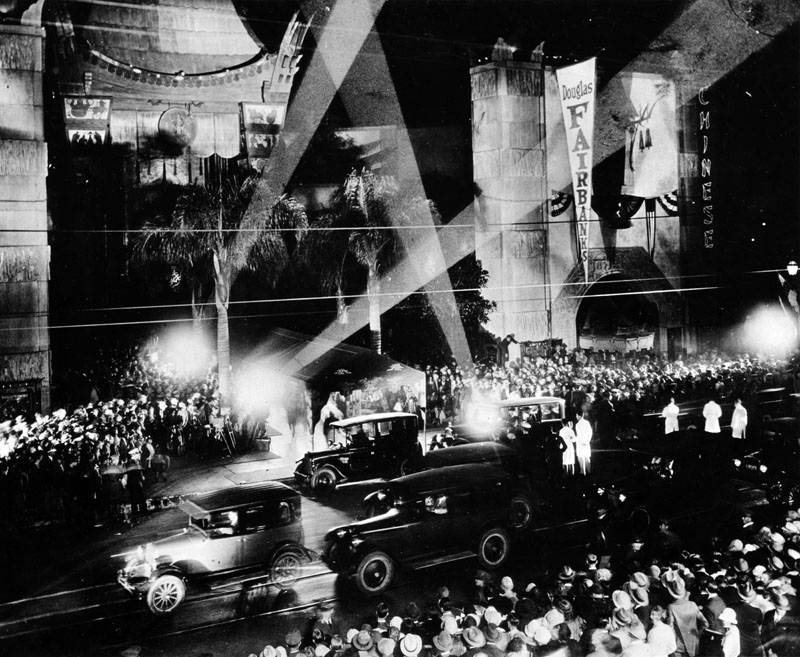 |
|
| (1927)* - Night view shows theater lights and throngs of fans packing the streets for blocks around Grauman's Chinese Theatre. Publicity of Hollywood premiers usually brought stars and other distinguished visitors to magnificent events such as the one seen here - possibly the opening night of a movie starring Douglas Fairbanks. |
Historical Notes After his success with the Egyptian Theatre, Sid Grauman turned to Charles E. Toberman to secure a long term lease on property at 6925 Hollywood Blvd. Toberman contracted the architectural firm of Meyer & Holler (who had also designed the Egyptian) to design a "palace type theatre" of Chinese design. Grauman's Chinese Theatre was financed by Grauman, who owned a one-third interest, and his partners: Mary Pickford, Douglas Fairbanks, and Howard Schenck. The principal architect of the Chinese Theatre was Raymond M. Kennedy, of Meyer and Holler. |
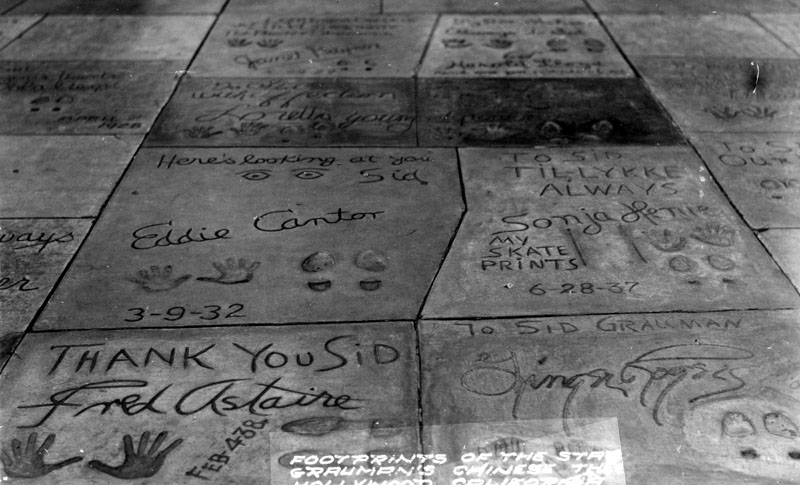 |
|
| (ca. 1930s)* - Footprints of the stars at Grauman's Chinese Theater in Hollywood. |
Historical Notes During construction, Grauman hired Jean Klossner to formulate an extremely hard concrete for the forecourt of the theatre. Klossner later became known as "Mr. Footprint," performing the footprint ceremonies from 1927 through 1957. |
 |
|
| (1927)* - View of Douglas Fairbanks putting his shoe print in the fresh concrete in front of the Grauman's Chinese Theater. Mary Pickford is by his side. |
Historical Notes Douglas Fairbanks and Mary Pickford were the inaugural celebrities to put their feet and handprints into fresh concrete at Grauman's Chinese Theater on April 30, 1927. This picture shows the two stars, exhibitor Sid Grauman, a workman, and how the event was apparently not open to the public. |
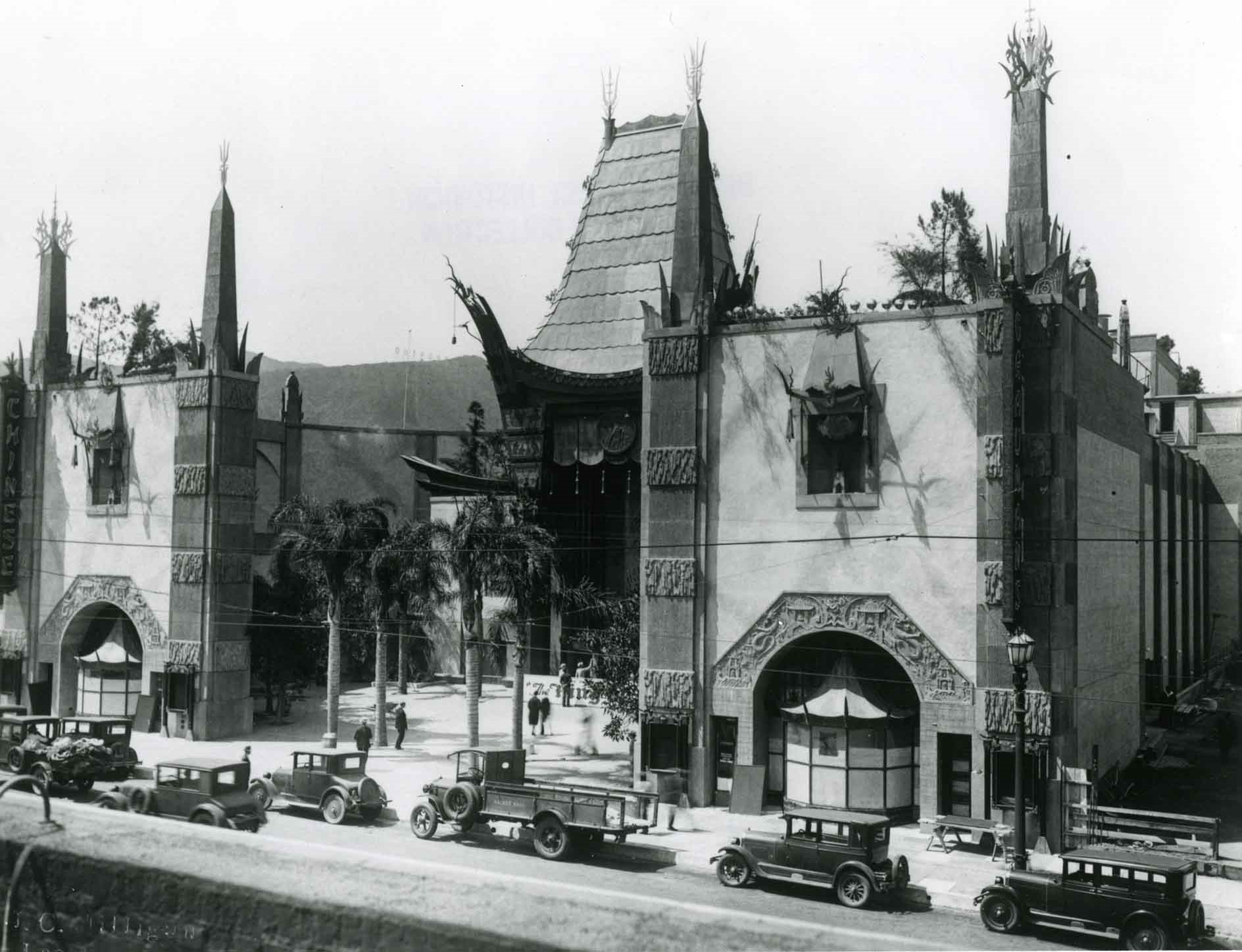 |
|
| (1927)* - View of Grauman's Chinese Theatre the year it opened, with its one-of-a-kind grandeur and décor. |
Historical Notes Previously, Grauman built the Million Dollar Theatre in downtown Los Angeles and the lavish Egyptian Theatre a few blocks from the Chinese, but this would be his dream theatre. Norma Talmadge turned the first spade full of dirt in January 1926 and beautiful Chinese actress Anna May Wong drove the first rivet in the steel girders. Built at a cost of $2,000,000, eighteen months later the Chinese Theatre opened. |
 |
|
| (1927)* - View showing Grauman's Chinese Theatre on Hollywood Boulevard shortly after it opened. |
Historical Notes Grauman's Chinese Theatre opened in May 18, 1927, after a construction period of 18 months. Built to resemble a giant, red Chinese pagoda, the architecture features a huge Chinese dragon across the front, two stone lion-dogs guarding the main entrance, and the silhouettes of tiny dragons up and down the sides of the copper roof. |
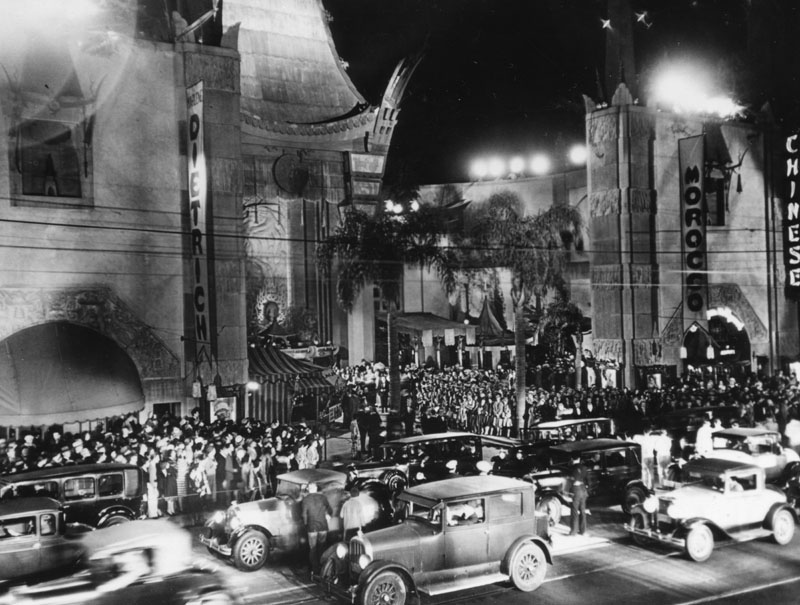 |
|
| (1930)* - Premiere of "Morocco" starring Marlene Dietrich and Gary Cooper at the Grauman's Chinese Theatre. |
Historical Notes Morocco is a 1930 American romance drama film directed by Josef von Sternberg and starring Gary Cooper, Marlene Dietrich, and Adolphe Menjou. The film is about a cabaret singer and a Legionnaire who fall in love. The film is most famous for the scene in which Dietrich performs a song dressed in a man's tailcoat and kisses another woman, both of which were rather scandalous for the period. In 1992, Morocco was selected for preservation in the United States National Film Registry by the Library of Congress as being "culturally, historically, or aesthetically significant". |
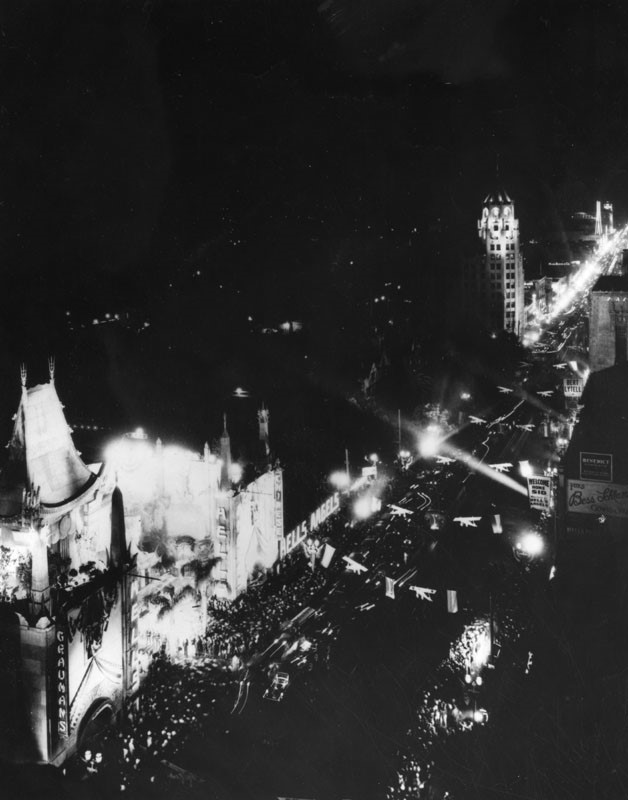 |
|
| (1930)* - Premier night of "Hell's Angels" at Grauman's Chinese Theatre. View is looking down from the top of the Roosevelt Hotel. The iconic First National Bank Tower can be seen in the background. |
Historical Notes Hell's Angels is a 1930 American war film, directed by Howard Hughes and starring Jean Harlow, Ben Lyon, and James Hall. The film, which was produced by Hughes and written by Harry Behn and Howard Estabrook, centers on the combat pilots of World War I. Originally shot as a silent film, Hughes retooled the film over a lengthy gestation period. Most of the film is in black and white, but there is one color sequence - the only color footage of Harlow's career. Hell's Angels is now hailed as one of the first sound blockbuster action films. |
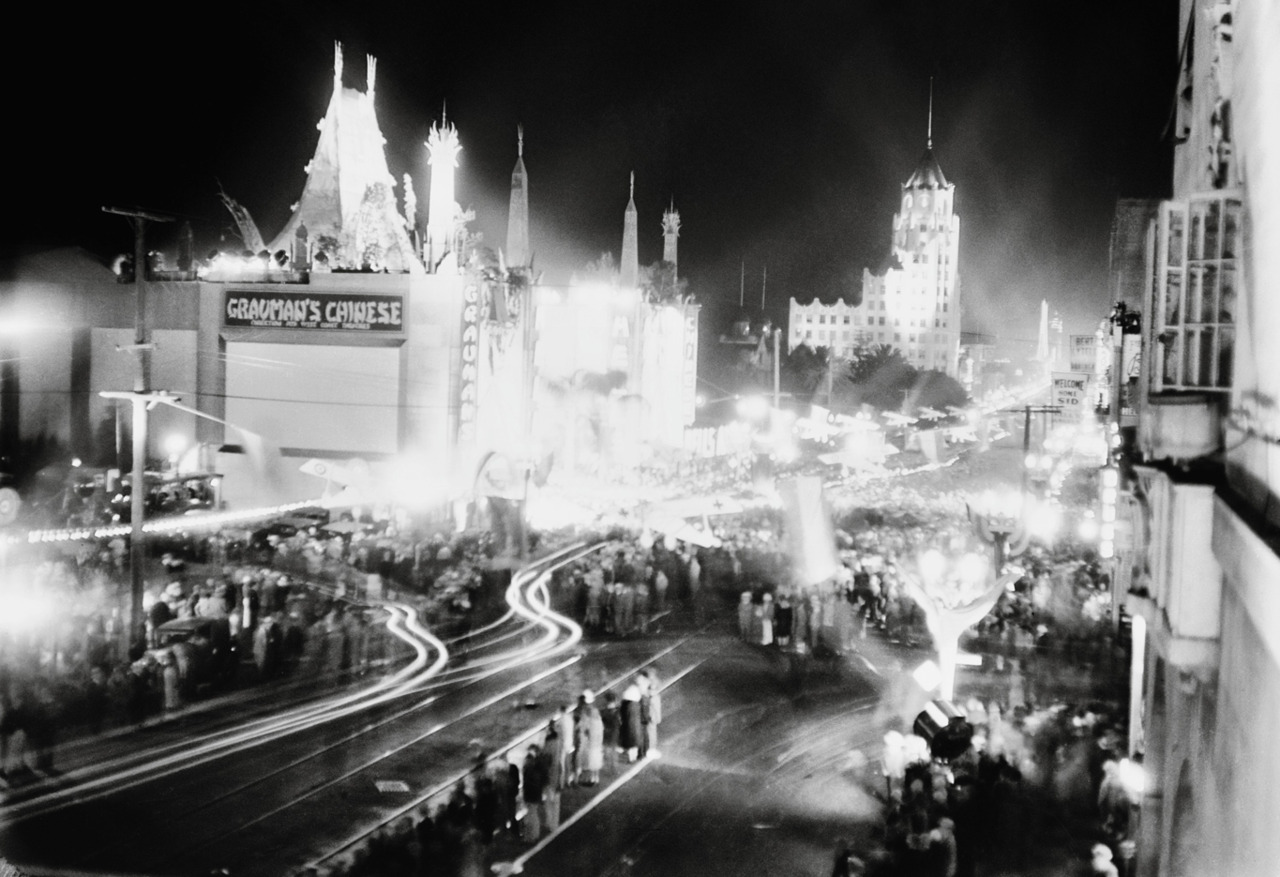 |
|
| (1930)*- The premiere of “Hell’s Angels” at Grauman’s Chinese Theatre in Hollywood as seen from across the street. |
Historical Notes Producer/director Howard Hughes poured nearly $4 million into his production of “Hell’s Angels” so he wanted to make sure everybody knew about it. On May 24, 1930 he threw a premiere the likes of which Hollywood had never seen before. And for the movie’s run at Grauman's Chinese Theatre, he had the title emblazoned on the columns, just in case, you know, there was anyone left who hadn’t heard of his movie. |
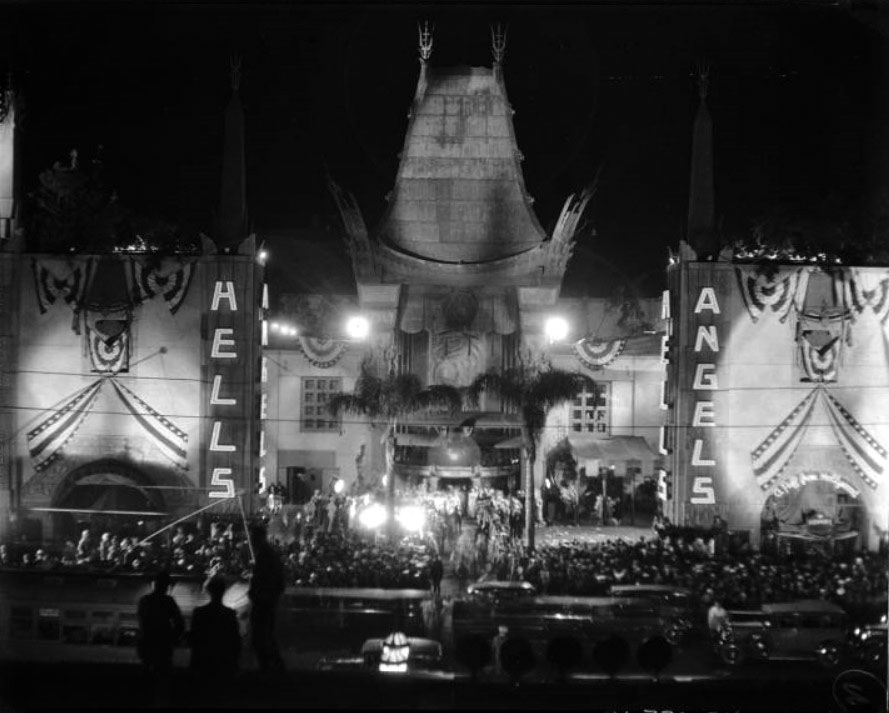 |
|
| (1930)* - View of the nighttime movie premier of "Hell's Angels" at Grauman's Chinese Theater. |
Historical Notes After being signed by director Howard Hughes, Harlow's first major appearance was in Hell's Angels, followed by a series of critically unsuccessful films, before signing with Metro-Goldwyn-Mayer in 1932. Harlow became a leading lady for MGM, starring in a string of hit films including Red Dust (1932), Dinner at Eight (1933), Reckless (1935) and Suzy (1936). Among her frequent co-stars were William Powell, Spencer Tracy and, in six films, Clark Gable. Harlow's popularity rivaled and soon surpassed that of her MGM colleagues Joan Crawford and Norma Shearer. She had become one of the biggest movie stars in the world by the late 1930s, often nicknamed the "Blond Bombshell" and the "Platinum Blonde", and popular for her "Laughing Vamp" movie persona. She died during the filming of Saratoga in 1937 at the age of 26. Click HERE to see more Early Views of Grauman's Chinese Theater. |
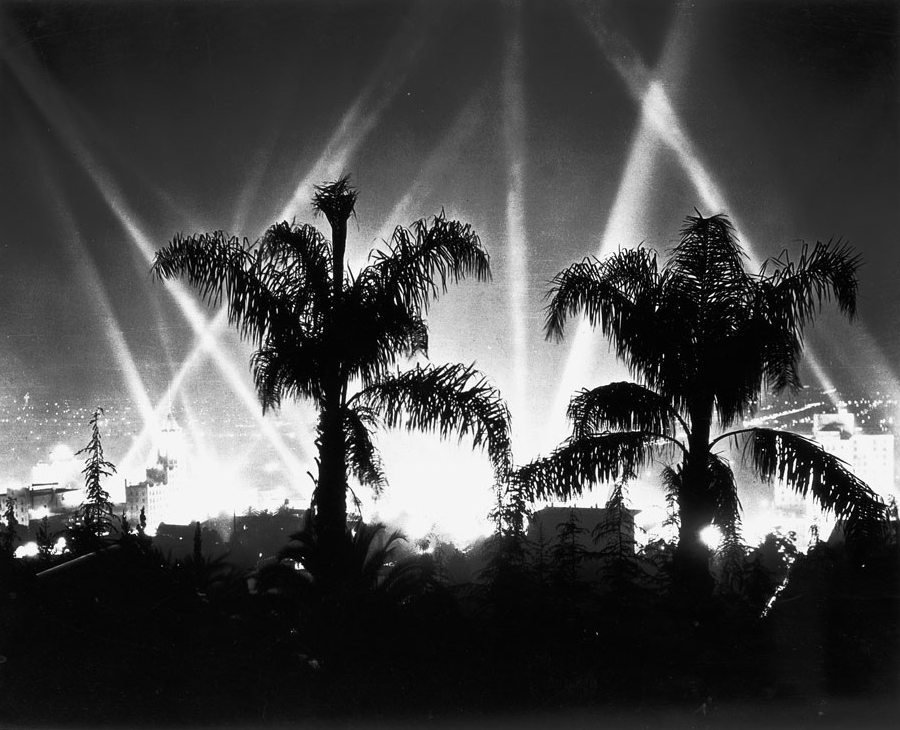 |
|
| (1930)^ - Hollywood at night as seen from the Hollywood Hills. Spotlights can be seen in the background as Hollywood premiers another movie. |
Historical Notes Downtown Los Angeles had (and has) the largest concentration of cinemas in the world. In the 1920s, efforts were made to create a theater district in Hollywood to rival that of the Broadway Theater District. Joining two earlier, more modest theaters, the spectacular Egyptian, El Capitan, Grauman's Chinese Theatre, Warner Bros Hollywood, and Pantages theaters all opened along a walkable, 1.5 kilometer stretch of Hollywood Boulevard between 1922 and 1930. Three of them were co-opened by Charles E. Toberman, one of at least two men nicknamed the “Father of Hollywood.” The Vogue, Admiral, and other modest but beautiful cinemas followed in the 1930s. |
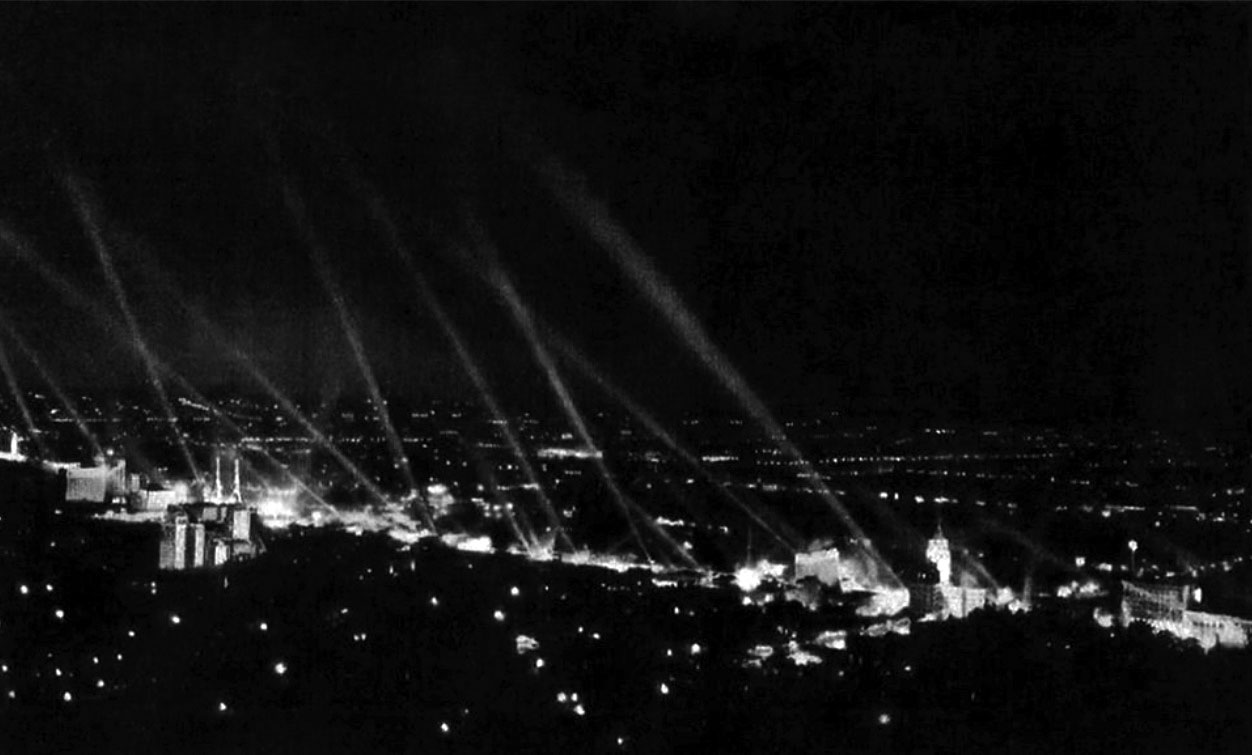 |
|
| (ca. 1932)* - A postcard view of Hollywood Boulevard at night. |
* * * * * |
Outpost Sign
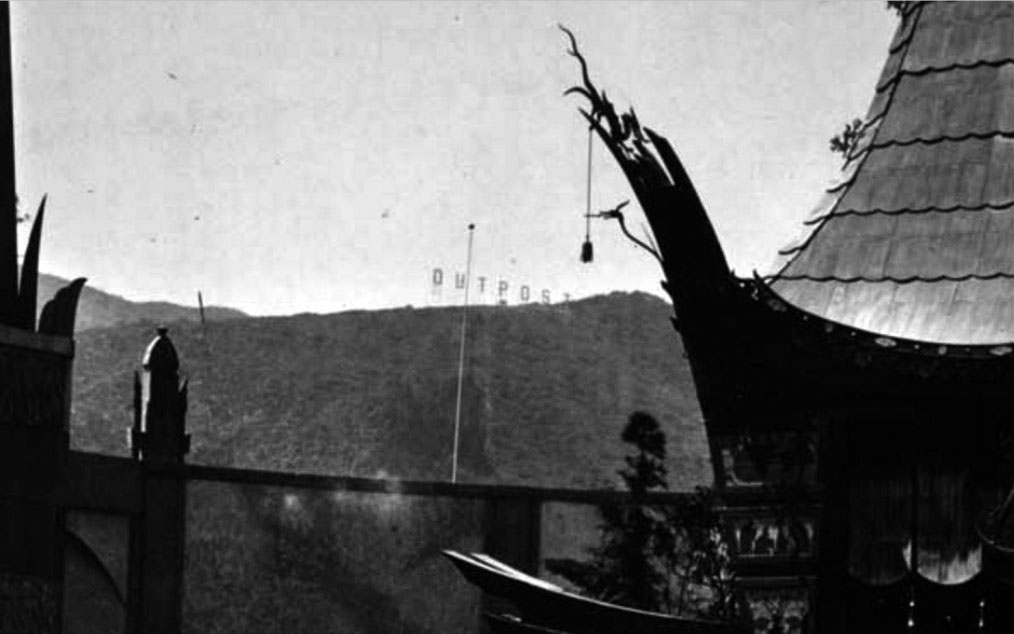 |
|
| (1920s)* – View looking north over Grauman's Chinese Theatre showing a large sign in the Hollywood Hills reading: OUTPOST |
Historical Notes In the 1920s, in the hills above the Outpost Estates development, a large sign spelled out "Outpost" in red neon letters 30 feet high. It was intended to compete with the Hollywoodland Sign, (which later became the Hollywood Sign). At the time, it was the largest neon sign in the United States. |
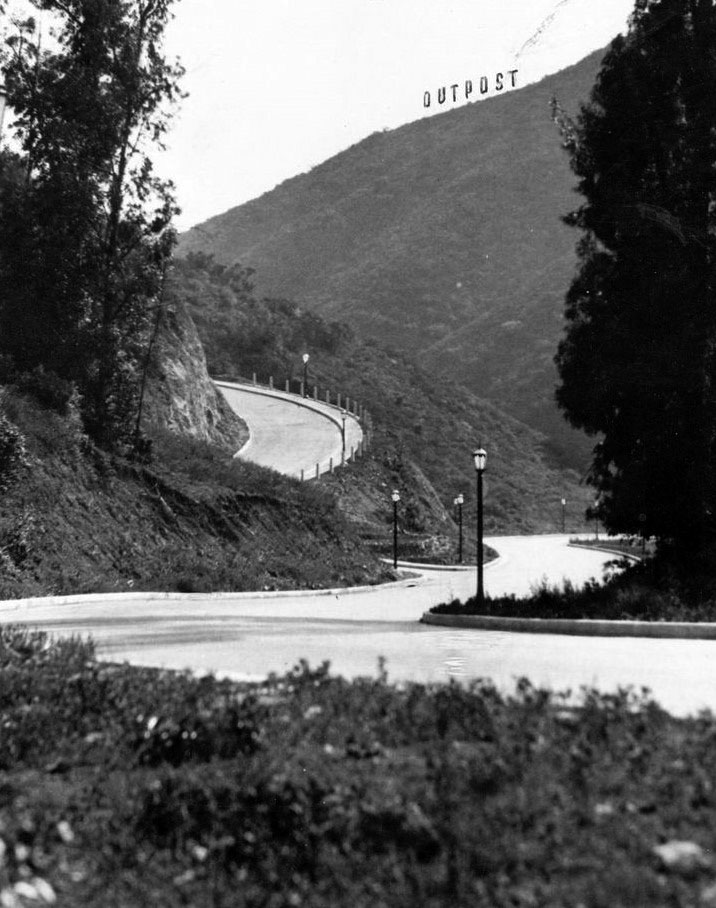 |
|
| (1928)*# – View of Outpost Drive as it winds its up through the Hollywood Hills towards Outpost Estates. The OUTPOST sign can be seen in the background, high up on the hill. |
Historical Notes The area was the site of the first building in what is now Hollywood, a three-room adobe house built in 1853 by Don Tomas Urquidez, near what is now the intersection of Outpost Drive and Hillside Avenue. General Harrison Grey Otis, the owner of the Los Angeles Times, acquired the estate from Don Tomás through legal wrangling associated with California's secession to the United States. Near Casa Don Tomás, Otis built a clubhouse on the property for entertaining, which he called "The Outpost." In 1924, Charles E. Toberman acquired the property. He kept the Outpost name and developed the property as one of several 1920s Hollywood luxury residential neighborhoods. |
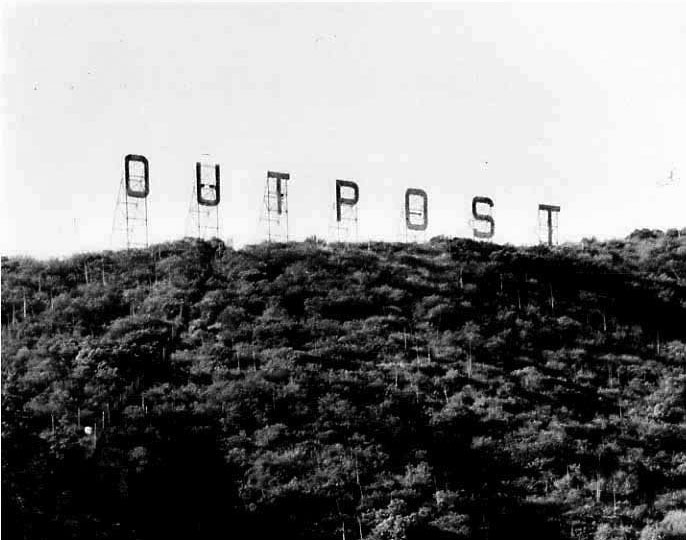 |
|
| (ca. 1920s)* - Close-up view showing the OUTPOST sign on the ridge of the mountain. |
Historical Notes The Outpost sign was dismantled during World War II, and the wreckage of the sign was left in place, buried in the weeds. Even the original foundation and electrical junction boxes survived. The twisted remains were identified by hikers in 2002. |
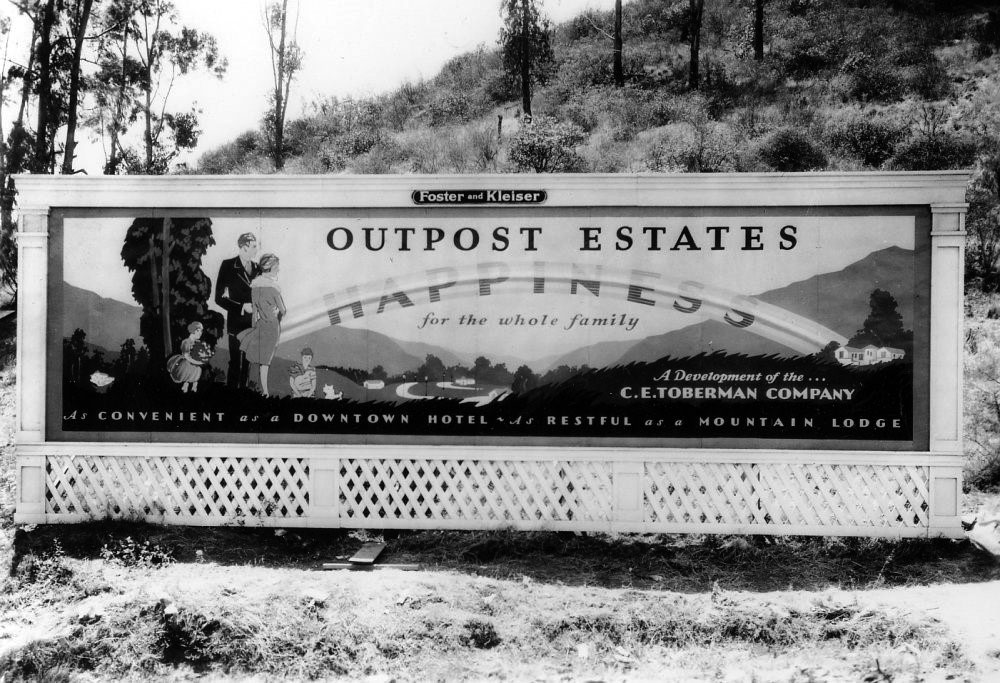 |
|
| (1920s)* – View showing a Foster and Kleiser Signboard advertising the Oupost Estates. Sign reads: HAPPINESS for the whole family - A Development of the C. E. Toberman Company - As Convenient as a Downtown Hotel - As Restful as a Mountain Lodge |
Historical Notes The area became known as an affluent area with many rich and famous residents. Homes had to be designed in Spanish, Mediterranean or California modern style, have red tile roofs, plenty of patios for "outdoor living," and be approved by architectural committee before being built. Most of the original houses have been preserved, and Lower Outpost looks much like it did in the 1920s. Today, the Outpost Estates consists of about 450 homes. It is bordered by Mulholland Drive to the north, Franklin Avenue to the south, Runyon Canyon Park to the west, and Hollywood Heights and the Hollywood Bowl to the east. |
* * * * * |
 |
|
| (1927)^** - A slightly elevated panoramic view of Hollywood facing northeast as seen from the Roosevelt Hotel. The street in the middle of the photograph is Hollywood Boulevard, with (Mann's or Grauman's) Chinese Theatre at the bottom of the picture, and the El Capitan Theatre farther away. The "Hollywoodland" sign is visible in the distance. The "Outpost" sign is to the left but out of view. |
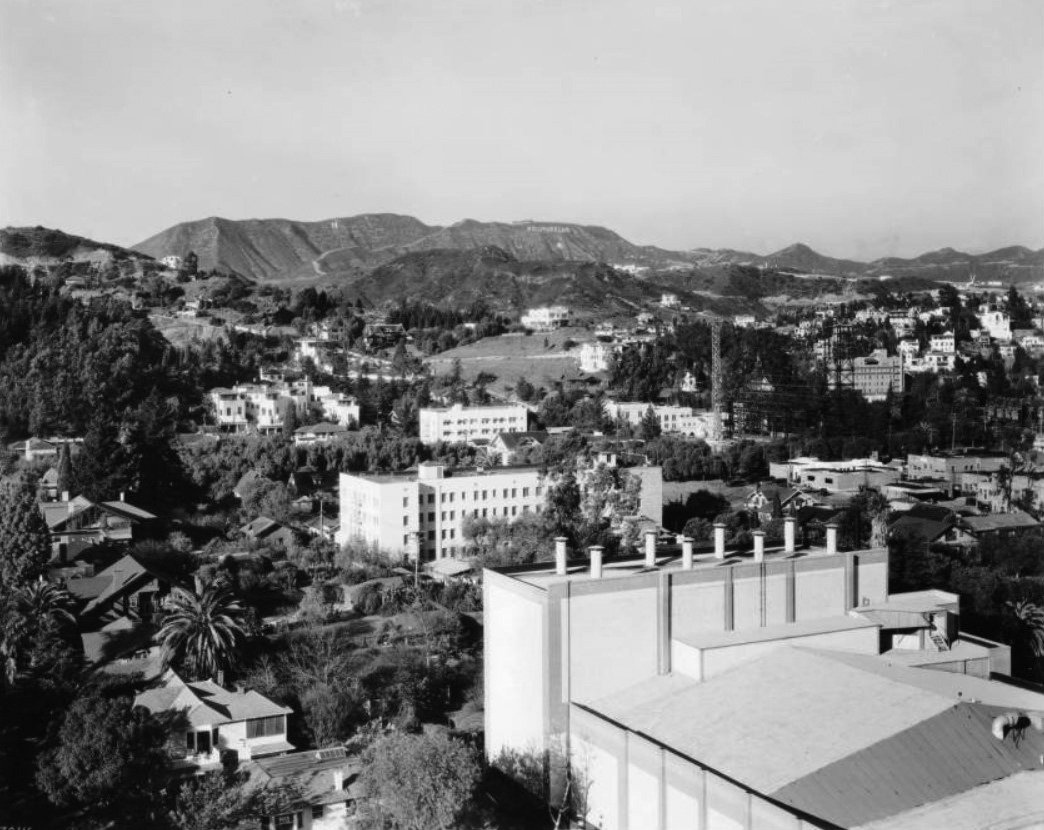 |
|
| (1929)* – Closer view looking northeast from the Roosevelt Hotel. The stage house for the Chinese Theatre stands in the center foreground, terminating in a rectangular structure with eight metal chimney stacks aligned in two rows. Further back, an apartment or office building of approximately five stories stands in the midst of two-story condominium residences. A radio tower can be seen to the right of it. The terrain is hilly and covered with trees, while the Hollywood Hills and the Hollywoodland Sign can be seen in the background. |
* * * * * |
Barnsdall Park
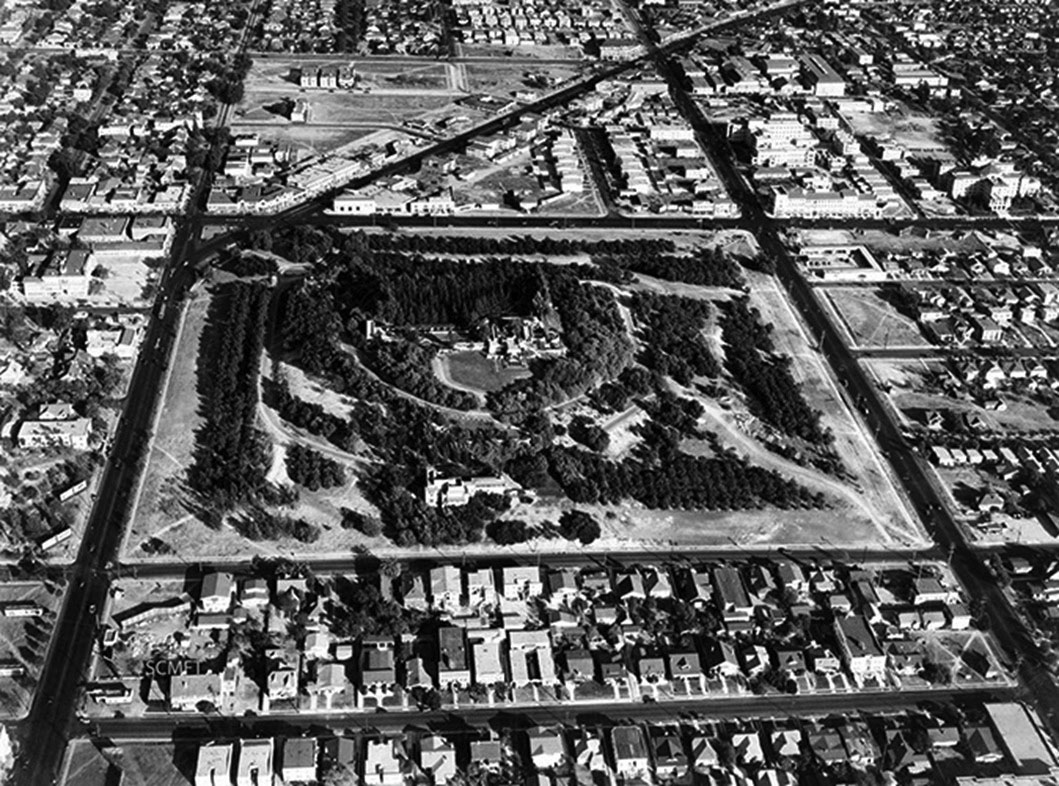 |
|
| (ca. 1930s)* – Aerial view looking east showing Barnsdall Park. Hollywood Boulevard runs away from the camera on the left. Vermont runs horizontally on the east side of the park. The park is centered on the Barnsdall's Hollyhock House designed by architect Frank Lloyd Wright. |
Historical Notes The fortunes of Pennsylvania oil baron William Barnsdall and his son, Theodore Newton, financed the artistic ambitions of Newton’s daughter, Aline. Well-travelled and unconventional, Aline possessed a passion for the arts. Her interest in experimental theater led her to Chicago, where she met the equally unconventional architect Frank Lloyd Wright who’d just finished his Midway Gardens project. Barnsdall envisioned her own arts complex years before she found her perfect site in Hollywood. Chicago, Seattle, and San Francisco had also been contenders. She finally decided that Los Angeles would be the ideal location for the ambitious and innovative development, so in 1919 she purchased a Hollywood hilltop known as Olive Hill, on the east end of Hollywood. The thirty-six-acre site had panoramic views of the Cahuenga Valley, the Hollywood Hills and downtown. Wright had already been doing conceptual designs as early as 1915 and took full advantage of this prominent canvas, designing a series of structures and terraces staggered on the hillside.* |
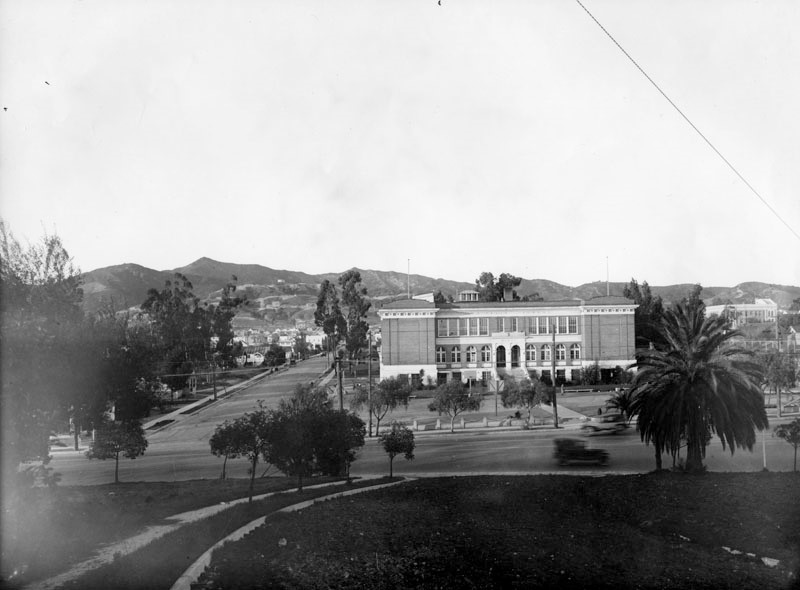 |
|
| (ca. 1927)* - View looking north from Barnsdall Park at the intersection of New Hampshire Avenue and Hollywood Boulevard. Los Feliz Elementary School is at the northeast corner. Vermont is the next street to the right (out of view). The Hollywood Hills can be seen in the distance, with the tallest peak being Mt. Hollywood. |
Historical Notes Aline Barnsdall donated Barnsdall Park to the City of Los Angeles for arts and recreational purposes, including the preservation of the historic architecture and landscape features. Located at the crest of Olive Hill, Barnsdall Art Park overlooks the city of Los Angeles, and the Hollywood Hills, including Griffith Park. The park is centered on the Barnsdall's Hollyhock House designed by architect Frank Lloyd Wright, a National Historic Landmark, Los Angeles Historic-Cultural Monument, and on the National Register of Historic Places in Los Angeles.* |
Hollyhock House
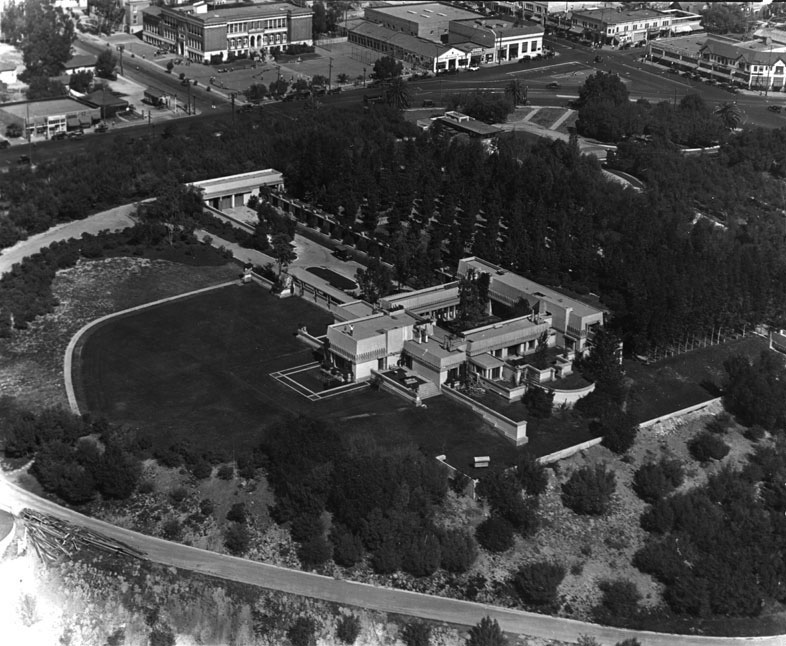 |
|
| (ca. 1927)* - Aerial view showing Barnsdall Art Park and the Frank Lloyd Wright designed Hollyhock House. At upper center-left is Los Feliz Elementary School. At upper-right corner is the intersection of Hollywood Boulevard and Vermont Ave. |
Historical Notes Originally designed by Frank Lloyd Wright as a residence for oil heiress Aline Barnsdall, The Hollyhock House was built in 1919–1921. Barnsdall originally intended the house to be part of an arts and theater complex on a property known as Olive Hill, but the larger project was never completed. Disillusioned by the costs of construction and maintenance, Barnsdall donated the house to the city of Los Angeles in 1927 under the stipulation that a fifteen-year lease be given to the California Art Club for its headquarters, which it maintained until 1942. The house has been used as an art gallery and as a United Service Organizations (USO) facility over the years. Beginning in 1974, the city sponsored a series of restorations, but the structure was damaged in the 1994 Northridge earthquake. It was again restored, and was open to the public as of June 2005.* |
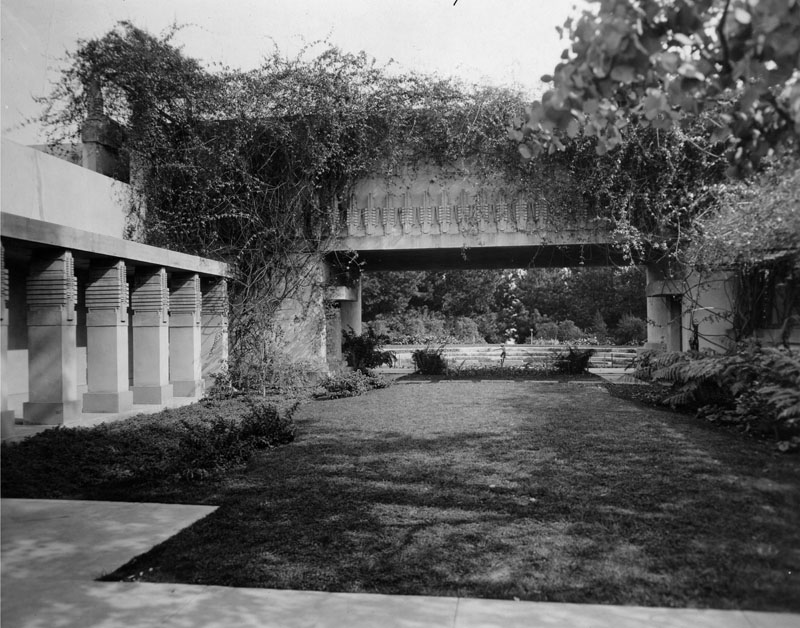 |
|
| (1939)* - View of archway and greenery, Hollyhock House located at 4808 Hollywood Boulevard in Barnsdall Park. The home was built between 1919-1921. Architect: Frank Lloyd Wright. Home has a "pre-Columbian air and stylized hollyhock ornamentation" - Gebhard & Winter, restored by Lloyd Wright (his son). |
Historical Notes Like many houses designed by Wright, it proved to be better as an aesthetic work than as a livable dwelling. Water tended to flow over the central lawn and into the living room, and the flat roof terraces were conceived without an understanding of Los Angeles' rains. The cantilevered concrete also has not stood up well to the area's earthquakes.* |
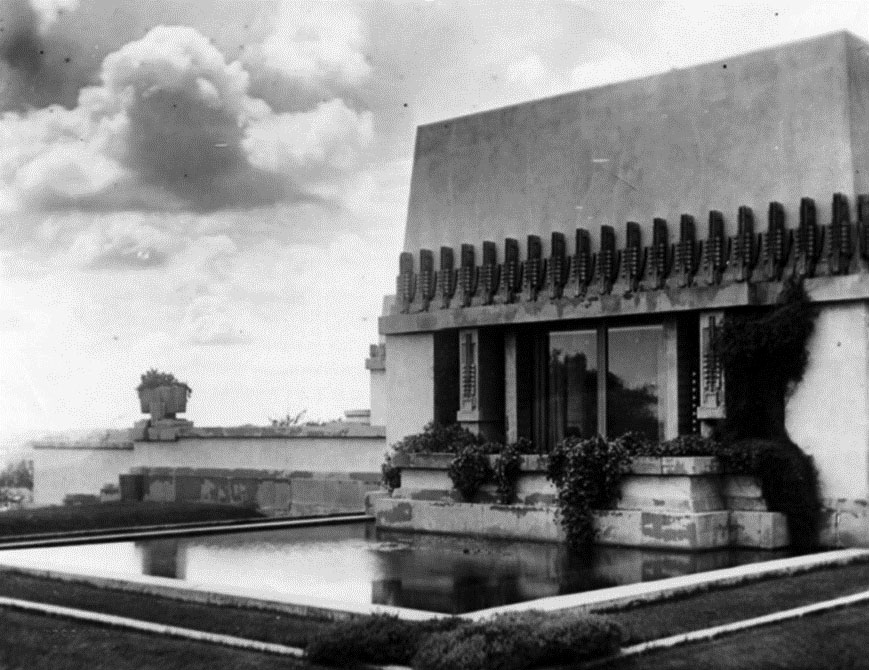 |
|
| (n.d.)* - Western exterior of Hollyhock House with the pond full of water. |
Historical Notes Like many houses designed by Wright, it proved to be better as an aesthetic work than as a livable dwelling. Water tended to flow over the central lawn and into the living room, and the flat roof terraces were conceived without an understanding of Los Angeles' rains. The cantilevered concrete also has not stood up well to the area's earthquakes.* |
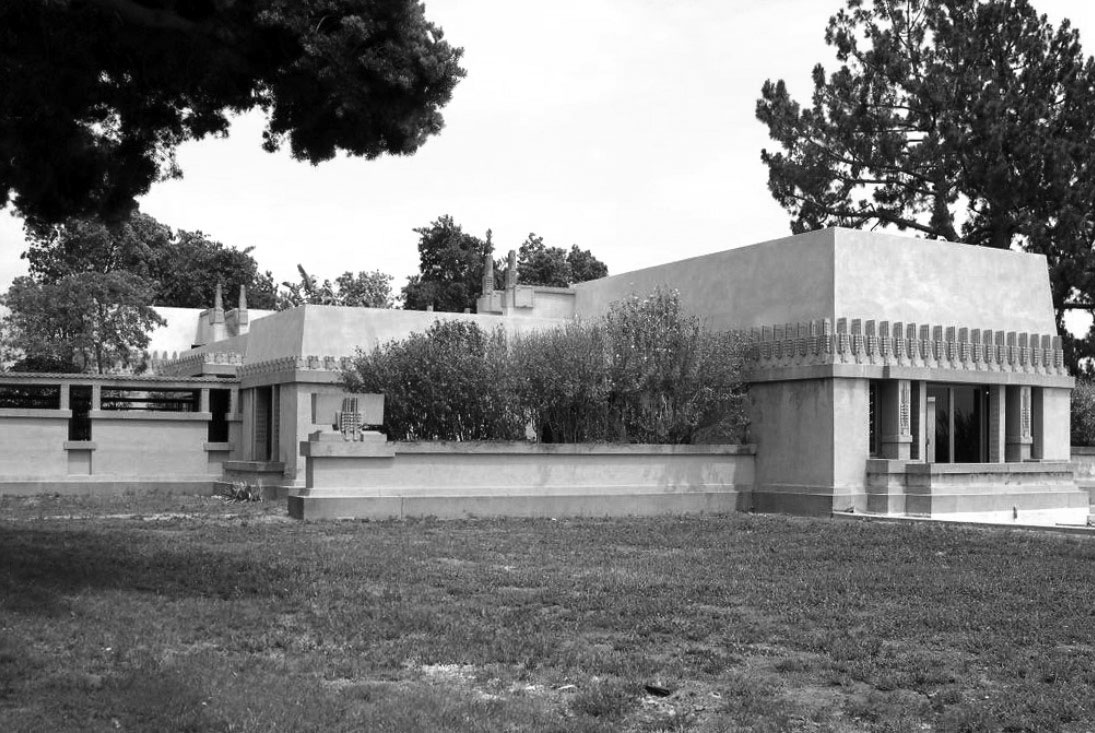 |
|
| (2005)*^ – Close-up view of Frank Lloyd Wright's Hollyhock House, located at 4808 Hollywood Boulevard. |
Historical Notes Hollyhock House was added to the National Register of Historical Places in 1971 - Building #71000143 and designated Los Angeles Historic-Cultural Monument #12 in 1963. The 12-acre Barnsdall Park was designated Los Angeles Historic-Cultural Monument #34 in 1965 and Residence A (Barnsdall Park Arts Center) was designated Los Angeles Historic-Cultural Monument #33 in 1965. Click HERE to see complete listing of LA Historic-Cultural Monuments. |
NE Corner of Hollywood and Vine
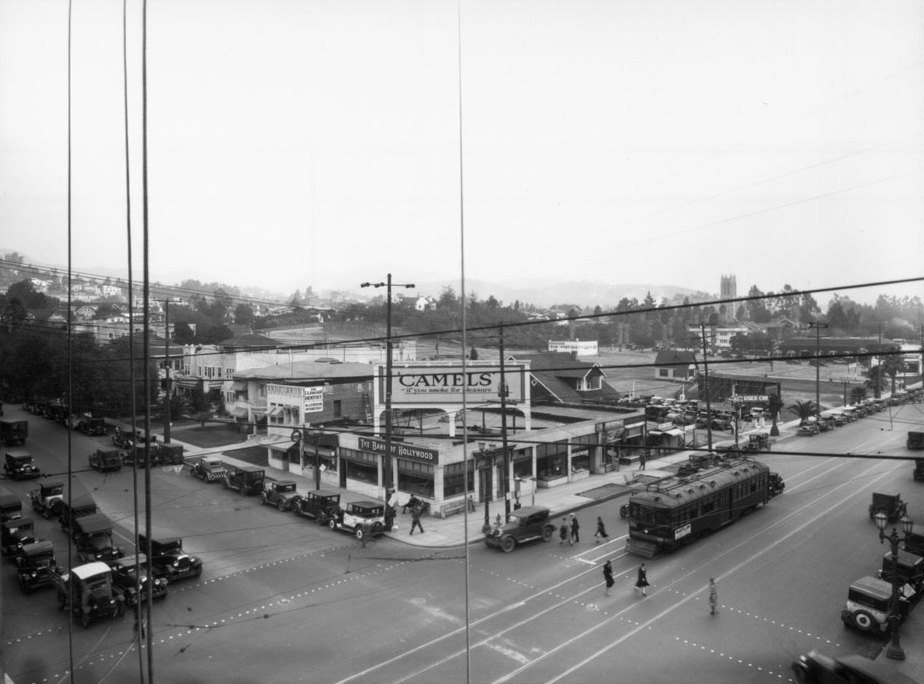 |
|
| (1927)^ - View looking toward the northeast corner of Hollywood Boulevard and Vine Street. Pedestrians cross the street as autos and streetcar wait for light to change. This would be the future home of the 12-story Equitable Building, built in 1929. |
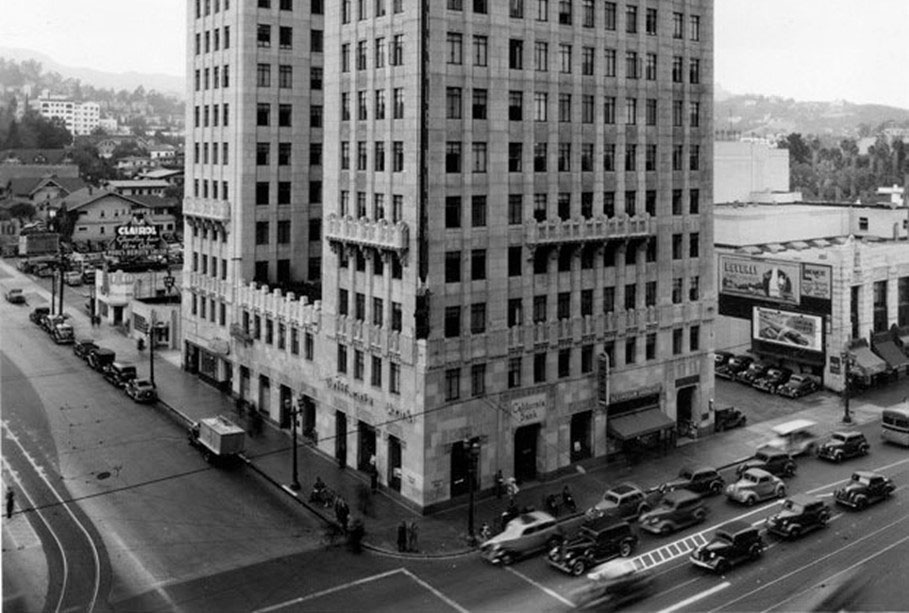 |
|
| (ca. 1937) - View looking at the NE corner of Hollywood and Vine showing the 1929-built Equitable Building. The 1930-built Pantages Theatre is seen on the right. |
 |
|
 |
Hollywood Playhouse (later El Capitan Theatre and Avalon Nightclub)
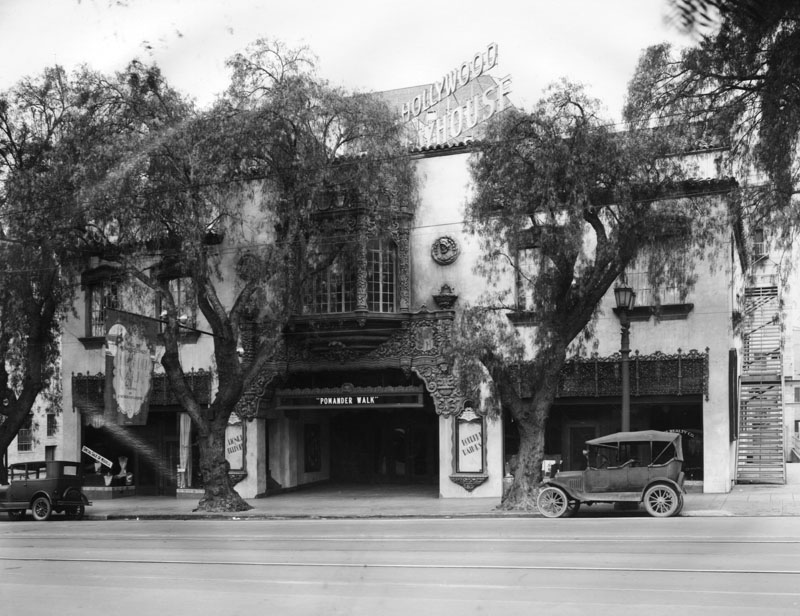 |
|
| (1927)* - Exterior view of the Spanish style Hollywood Playhouse, located at 1735 N. Vine, near the intersection of Hollywood and Vine. |
Historical Notes The Hollywood Playhouse opened for the first time on January 24, 1927. It was designed in the Spanish Baroque style by the architectural team of Henry L. Gogerty and Carl Jules Weyl in 1926-1927. Henry L. Gogerty (1894–1990) is best known for designing over 350 schools and industrial buildings in Southern California. In 1901, he began construction on Gardena High School which opened in 1907, and is still open to this day. Together with Carl Jules Weyl, he designed the Spanish Baroque Palace Theater, now known as the Avalon Hollywood, located at 1735 North Vine Street in Hollywood, in 1926-1927. Alternatively, in 1926, they designed the Spanish Colonial Baine Building located at 6601-09 Hollywood Boulevard, built for Colonel Harry Baine (1884-1945). In 1927, they designed a building located at 6654 Hollywood Boulevard. In 1928, they designed shops and studios for Fred Thomson (1890-1928). In 1929, they designed the Yucca Vine Tower, a 112-foot, eight-floor building located at 6305-09 Yucca Street in the Yucca Corridor area of Hollywood. In 1928, he designed the Grand Central Air Terminal of the Glendale Airport in Glendale. Carl Jules Weyl (1890 – 1948) moved to Los Angeles in 1923, where he designed the Brown Derby Restaurant #2, the Hollywood Playhouse, the Gaylord Apartments, as well as many other buildings and Hollywood estates.*^ |
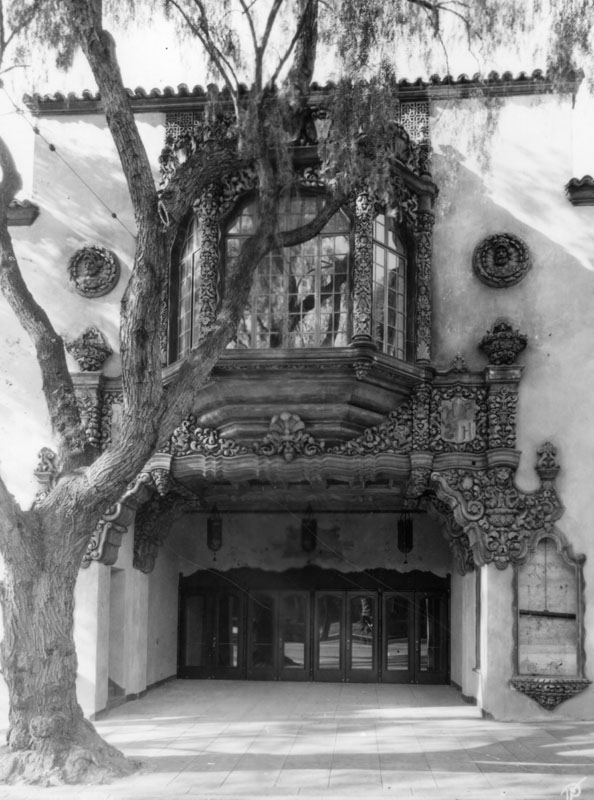 |
|
| (ca. 1927)* - Facade of the Spanish Baroque style Hollywood Playhouse entrance, designed by Gogerty & Weyl. |
Historical Notes During the Great Depression, the theatre was renamed The WPA Federal Theatre (after the Works Progress Administration), and used for government-sponsored programs. Later, the theatre hosted numerous CBS Radio Network programs, including Fanny Brice's Baby Snooks show and Lucille Ball's My Favorite Husband program. Lux Radio Theater broadcast condensed movie scripted versions, usually with the movie's original cast performing their movie roles. Ginger Rogers and Ray Milland performed "Lady in the Dark" in 1945.*^ |
 |
|
| (ca. 1927)^^^ – Interior view of the Hollywood Playouse Theatre showing the ornate Baroque designs on walls, ceiling and balcony. |
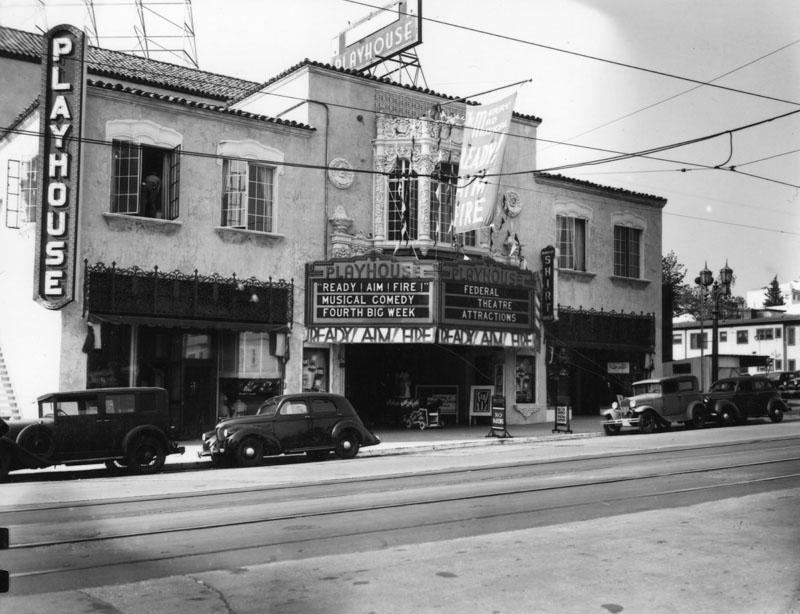 |
|
| (ca. 1936)* - Exterior view of the Spanish style Hollywood Playhouse, located at 1735 N. Vine St. Gogerty & Weyl designed the theater in 1926. The musical "Ready! Aim! Fire!" is the current show being performed at the theater. Neighboring businesses included a beauty salon (left) and a shirt maker (right). Vine Street streetcar tracks are visible in the foreground. |
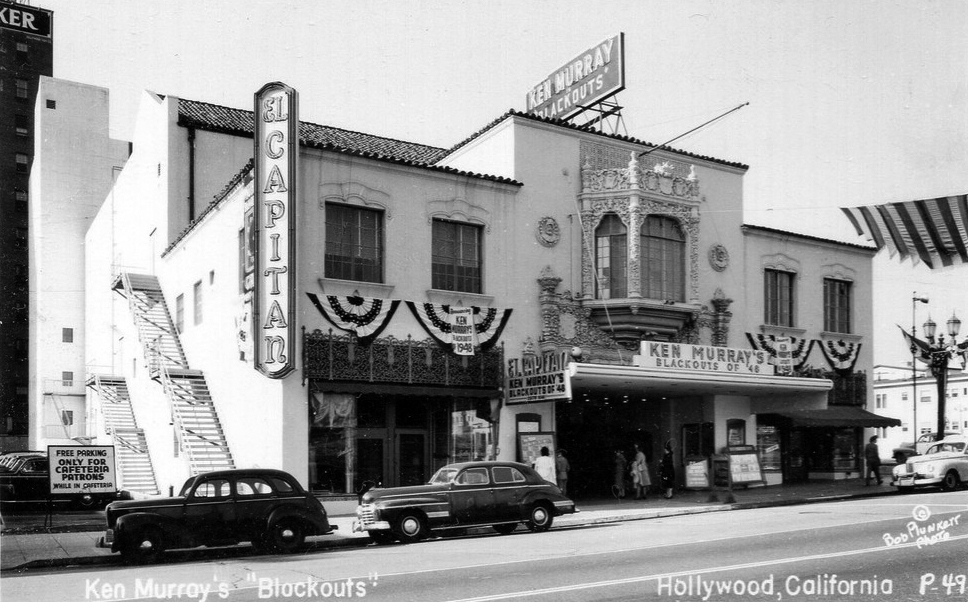 |
|
| (1948)*# - Postcard view of the El Capitan Theatre (previously Hollywood Playhouse) featuring Ken Murray's "Blackouts", not to be confused with the El Capitan Theatre on Hollywood Boulevard. |
Historical Notes In the 1940s, 1735 Vine was renamed The El Capitan Theatre, and was used for a long-running live burlesque variety show called Ken Murray's Blackouts. This should not be confused with the nearby movie theatre of the same name and age, the El Capitan Theatre on Hollywood Boulevard, which at the time was known as the Paramount Theatre.*^ |
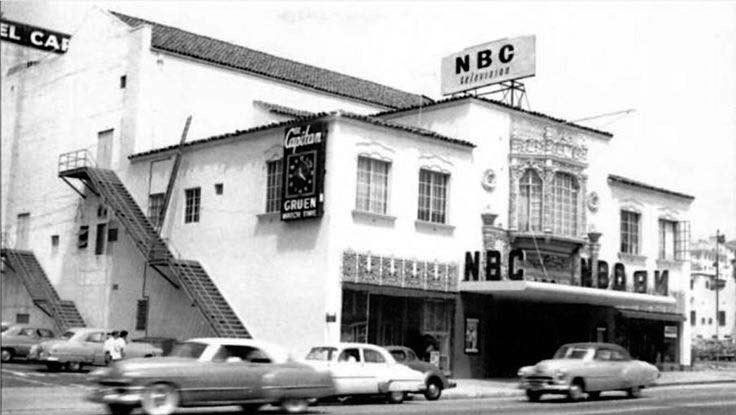 |
|
| (1950s)^.^ – View showing El Capitan Theatre (formerly Hollywood Playhouse) when it was a NBC television studio. |
Historical Notes In the 1950s, still under the name of El Capitan, the theatre became a television studio, and it was from a set on its stage that Richard Nixon delivered his famous "Checkers speech" on September 23, 1952. This event is often mistakenly said (especially on the Internet) to have taken place at the El Capitan Theatre on Hollywood Boulevard, though that theater was never a television studio, and in 1952 was operating as a movie house called the Paramount Theatre. The theater was also home to The Colgate Comedy Hour, the Lawrence Welk Show, and This is Your Life.*^ |
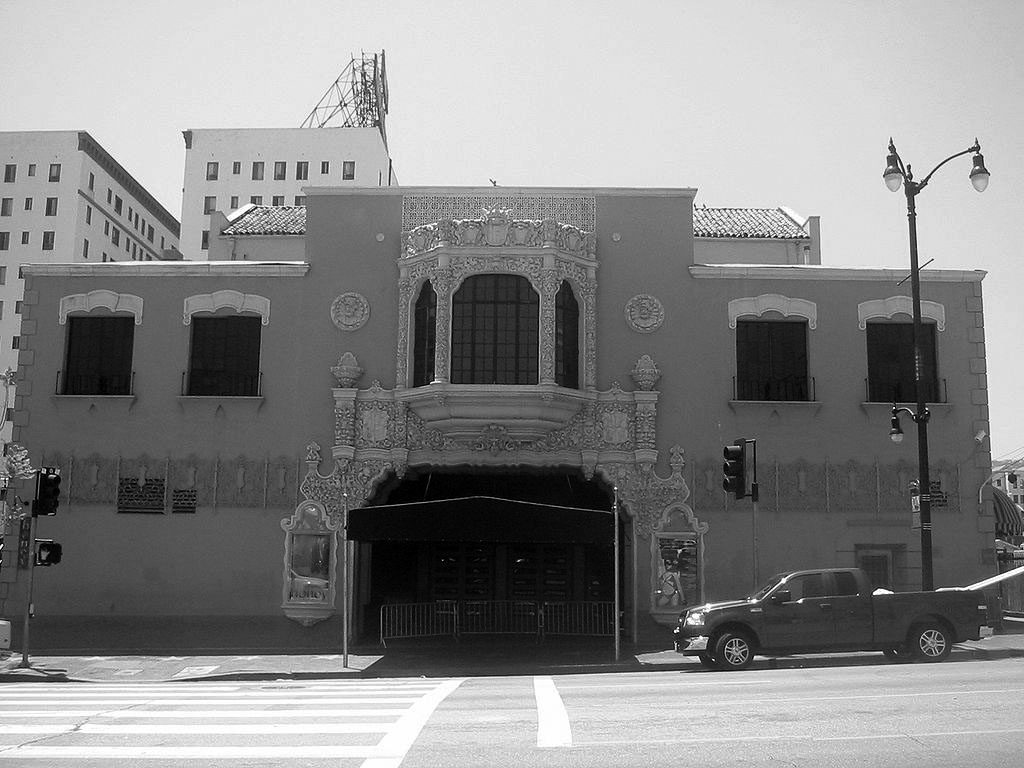 |
|
| (2007)*^ - Front view of the Avalon (formerly the Hollywood Playhouse) at 1735 N. Vine St. |
Historical Notes The Avalon (or Avalon Hollywood) is a night club and music venue. Located at 1735 N. Vine Street, it has previously been known as The Hollywood Playhouse, The WPA Federal Theatre, El Capitan Theatre, The Jerry Lewis Theatre, The Hollywood Palace and The Palace. It has a capacity of 2,000.*^ Click HERE for a more contemporary view. |
* * * * * |
Baine Studio Building
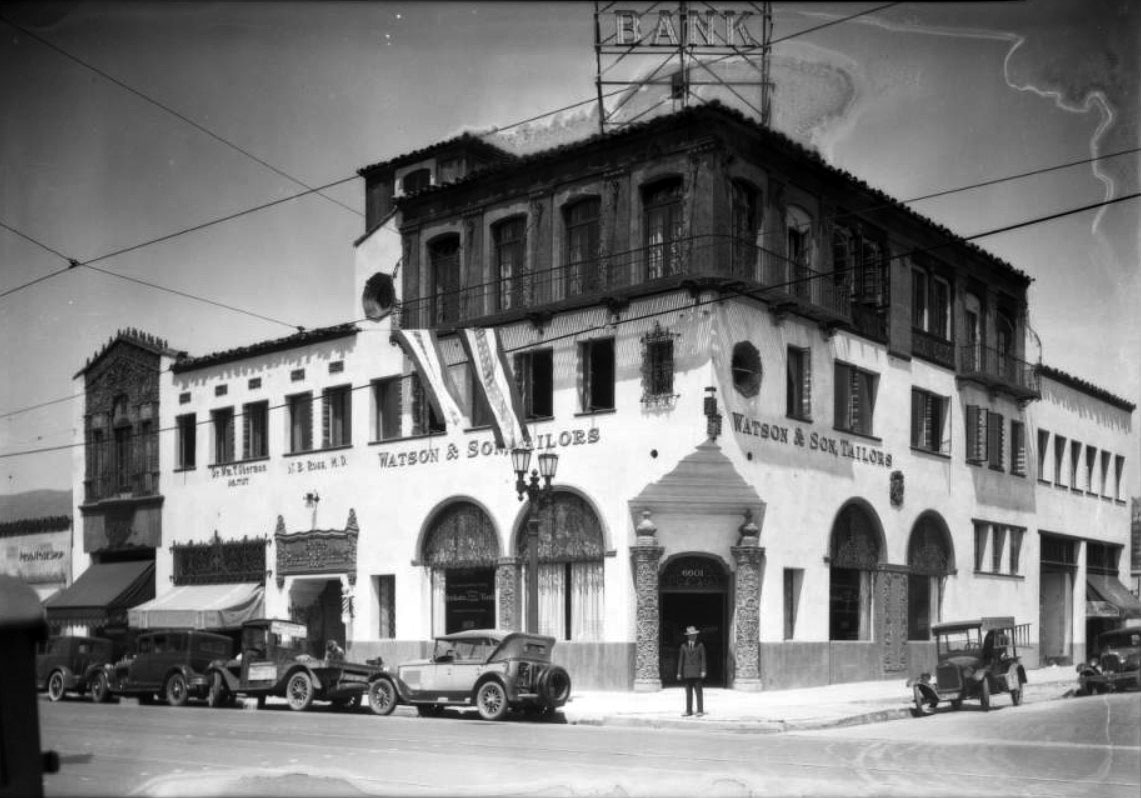 |
|
| (1927)* – A man is seen standing on the northwest corner of Hollywood Boulevard and Whitley Avenue in front of the Baine Studio Building. Written on the face of the building is: WATSON & SON, TAILORS. A large sign on top of the building reads: BANK |
Historical Notes The Baine Building was built in the Spanish Revival style by businessman Harry M. Baine and designed by architecture firm Gogerty & Weyl in 1926. Harry M. Baine, a prominent businessman and Los Angeles County Supervisor, was also the man responsible for the creation of the annual Hollywood Christmas Parade. During Christmastime in 1928, hoping to promote his business and drive sales, Baine renamed Hollywood Boulevard “Santa Claus Lane” and hired real reindeer to pull sleighs down the street. And thus a tradition was born. Baine was "the first person to live in a penthouse on Hollywood Boulevard," and his downstairs tenants were the Merchants National Trust and Savings Bank. The Baine Building still exists today. Click HERE for contemporary view. |
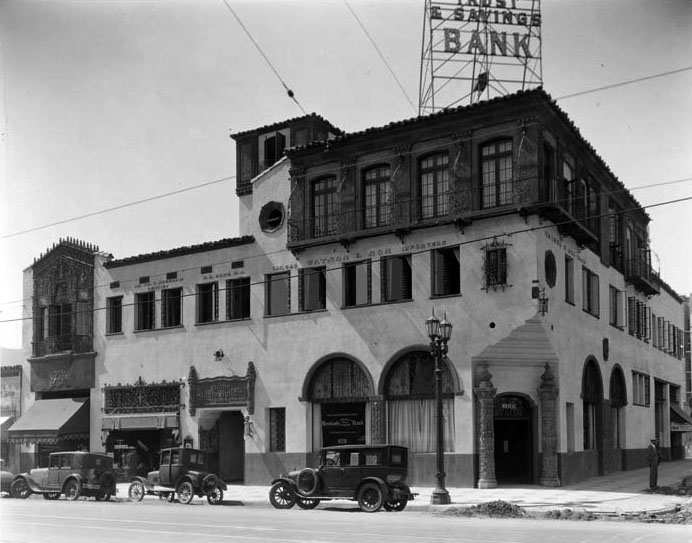 |
|
| (ca. 1928)* – View showing the Baine Studio Building, 6601-6609 Hollywood Blvd. (Hollywood and Whitley) housing Merchants National Trust and Savings Bank; Watson & Son Tailors, Importers; Dr. Wm. T. Sherman, dentist; N.B. Rose M.D.; Hamilton’s shoe store, Friend, Ind., and a barber shop. Gogerty & Weyl, architects; J.C. Kubic, iron works; Henry I. Beller, contractor. |
Historical Notes Completed in 1926, the Spanish Baroque-style building was designed by Architects Henry Gogerty & Carl Weyl. Henry L. Gogerty (1894–1990) is best known for designing over 350 schools and industrial buildings in Southern California. In 1901, he began construction on Gardena High School which opened in 1907, and is still open to this day. Together with Carl Jules Weyl, he designed the Spanish Baroque Palace Theater, now known as the Avalon Hollywood, located at 1735 North Vine Street in Hollywood, in 1926-1927. Alternatively, in 1926, they designed the Spanish Colonial Baine Building located at 6601-09 Hollywood Boulevard, built for Colonel Harry Baine (1884-1945). In 1927, they designed a building located at 6654 Hollywood Boulevard. In 1928, they designed shops and studios for Fred Thomson (1890-1928). In 1929, they designed the Yucca Vine Tower, a 112-foot, eight-floor building located at 6305-09 Yucca Street in the Yucca Corridor area of Hollywood. In 1928, he designed the Grand Central Air Terminal of the Glendale Airport in Glendale. Carl Jules Weyl (1890 – 1948) moved to Los Angeles in 1923, where he designed the Brown Derby Restaurant #2, the Hollywood Playhouse, the Gaylord Apartments, as well as many other buildings and Hollywood estates. |
 |
|
| (1927)* – View showin the main entrance to the Baine Studio Building at 6605 Hollywood Boulevard. Note the barber pole* to the side of the entrance. |
Historical Notes *The red and white pole outside barber shops references a time when barbers were expected to perform bloodletting and other medical procedures to heal the sick; red may have represented blood and white may have been bandages. |
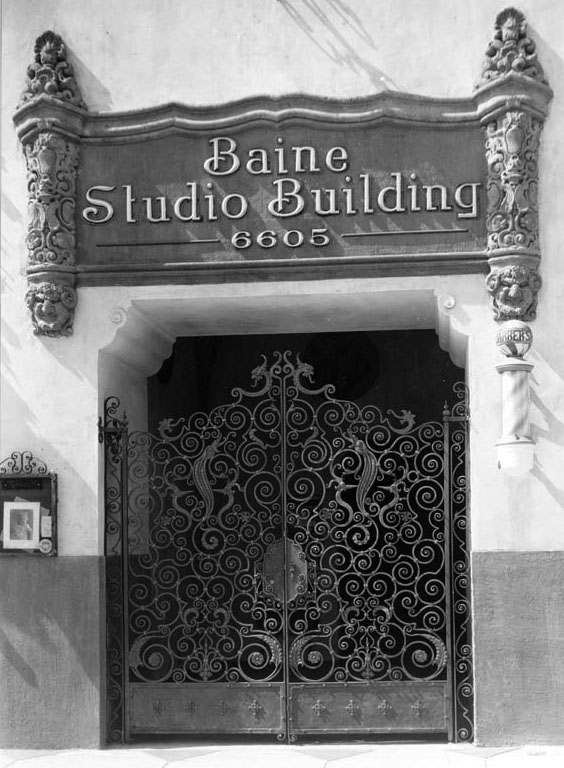 |
|
| (ca. 1928)* – Close-up view showing the detail iron work design of the front gate entrance to the Baine Building. |
.jpg) |
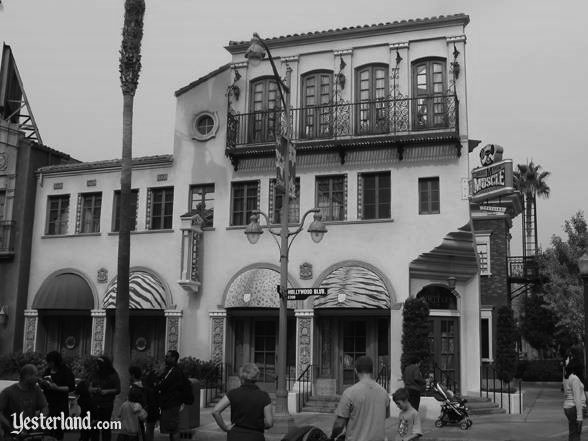 |
|
| (ca. 1928)* – View showing the Baine Studio Building, 6605 Hollywood Boulevard, located on the NW corner of Hollywood and Whitley) with Harry M. Baine's penthouse seen on the 3rd floor. Architects: Henry Gogerty & Carl Weyl | (2008)* - View showing the Disney version of the Baine Building at Disney’s Hollywood Studios, where its function and location are equivalent to the Main Street Emporium at Disneyland Park and Magic Kingdom Park. |
Historical Notes The name above the corner door in the Disney version says Whitley. That’s a reference to the location of the building after which it was modeled—the corner of Hollywood Blvd. and Whitley Ave. |
* * * * * |
El Capitan Theatre (later Paramount Theatre then El Capitan again)
 |
|
| (1925)* – Looking east on Hollywood Boulevard showing the construction of the El Capitan Theater adjacent to the adjacent to the Hollywood Masonic Temple. |
Historical Notes The El Capitan Theatre, located in the heart of Hollywood, has a storied history dating back to its opening on May 3, 1926. It was originally dubbed "Hollywood's First Home of Spoken Drama" and was the largest legitimate theatre in Hollywood at the time. The theatre was built by real estate developer Charles E. Toberman, known as the "Father of Hollywood". Its design featured an elaborate Spanish Colonial style exterior by Stiles O. Clements, while the interior was inspired by East Indian motifs, created by G. Albert Lansburgh. |
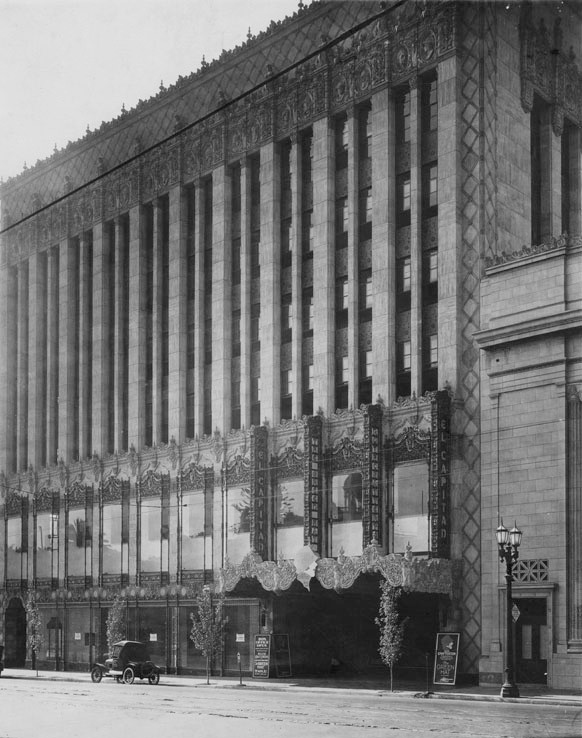 |
|
| (1926)* - View showing the newly completed El Capitan Theatre, located at 6838 Hollywood Boulevard adjacent to the Hollywood Masonic Temple (partially in view on the right). |
Historical Notes Completed in 1926, The El Capitain Theare was built by real estate developer Charles E. Toberman, known as the "Father of Hollywood". Its design featured an elaborate Spanish Colonial style exterior by Stiles O. Clements, while the interior was inspired by East Indian motifs, created by G. Albert Lansburgh. |
 |
|
| (ca. 1926)* - Night view looking across Hollywood Boulevard showing a well lit El Capitan Theatre with the Hollywood Masonic Temple next door on the right. |
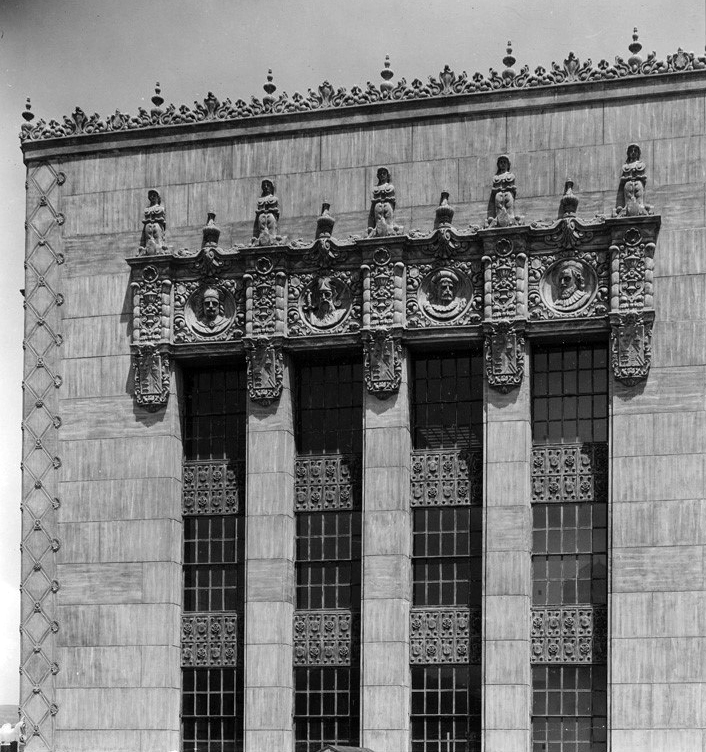 |
|
| (ca. 1926)^^^ - Close-up view showing the Spanish Baroque style designs on the side face of the El Capitan Building. |
Historical Notes The six-story building was designed in the elaborate Spanish Baroque style by the renowned firm of Morgan, Walls, & Clements, who incorporated retail and office space into the upper floors. Noted theatre architect G. Albert Lansburgh designed the elaborate interior. |
.jpg) |
|
| (1926)* - View of the auditorium and ceiling of the El Capitan Theatre, designed by Morgan, Walls and Clements Architects in east Indian-inspired style. Interior is designed by G. Albert Lansburgh. The orchestra pit is also in view. |
Historical Notes The El Capitan Theatre opened as a playhouse and was one of the premier dramatic stages in the area throughout the 1920s and most of the 1930s, hosting over 120 plays. The 1,550-seat theatre didn’t screen its first movie until 1941, when it hosted the world premiere of Citizen Kane. |
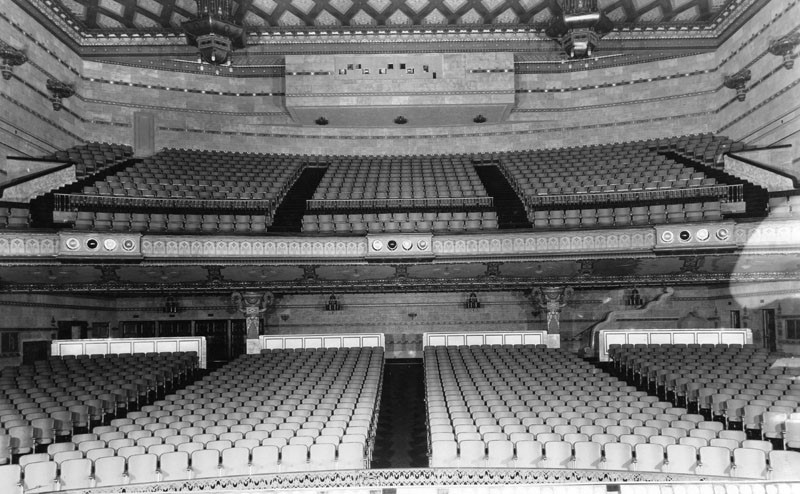 |
|
| (1926)* - View of the auditorium of the El Capitan Theatre from the stage, looking toward the orchestra and balcony seating. |
Historical Notes For a decade it presented live plays with productions including such legends as Clark Gable and Joan Fontaine. By the late 1930s, El Capitan felt the economic effects of the Depression, showcasing fewer and fewer productions. This period saw a cycle of experimentation with entertainment. In an effort to boost attendance at the theatre, its management attempted to lure revues, road shows and benefits. Despite these efforts, business was faltering. |
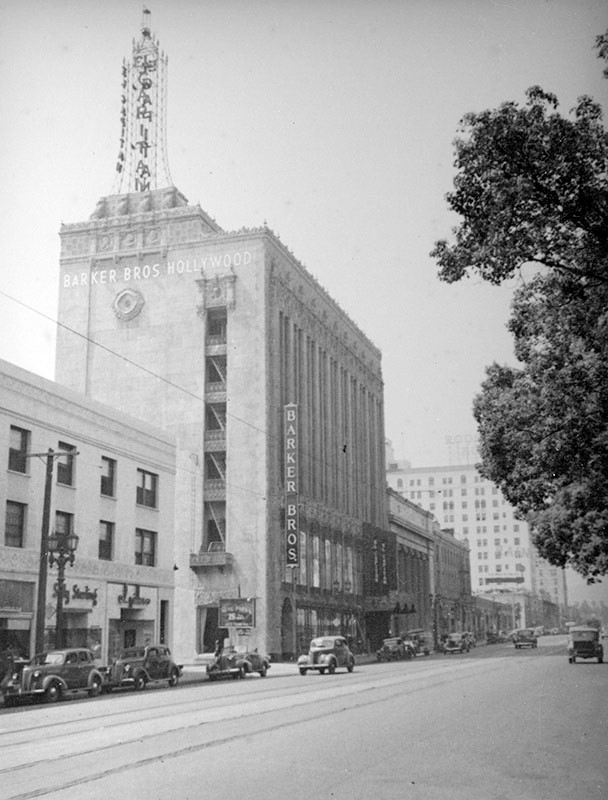 |
|
| (ca. 1937)* – View looking southwest across Hollywood Boulevard showing various businesses, including the Spanish Colonial revival style building that is occupied by both Barker Bros. and the El Capitan Theatre. |
Historical Notes When Orson Welles was unable to locate a theatre owner willing to risk screening Citizen Kane, he turned to El Capitan, and in 1941, Citizen Kane had its world premiere there. The theater then closed for one year.*^ |
* * * * * |
Paramount (Originally El Capitan and later El Capitan again)
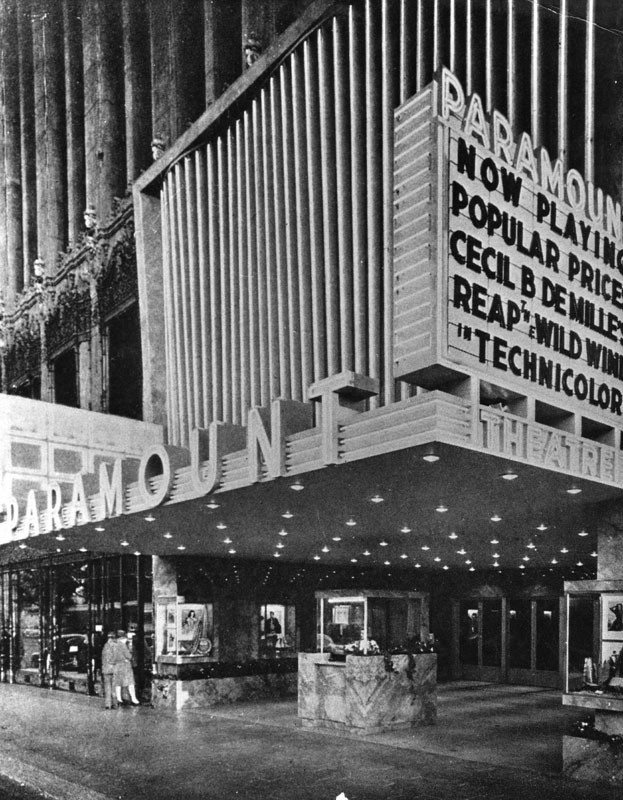 |
|
| (1942)* - View of the box office at the Paramount Theatre (previously El Capitan) in Hollywood. |
Historical Notes The building was remodeled in the modern style, and reopened on March 18, 1942 as the Hollywood Paramount Theatre. Its inaugural film presentation was Cecil B. DeMille's Technicolor feature Reap the Wild Wind, starring Ray Milland, John Wayne, Paulette Goddard and Raymond Massey. The theater remained the West Coast flagship for Paramount Pictures until the studio was forced by the U.S. Supreme Court's decision in the antitrust case U.S. vs. Paramount Pictures, et al. to divest itself of its theater holdings. After this, the Hollywood Paramount was operated by United Paramount Theatres for some years, then by a series of other companies, culminating with ownership by the Pacific Theatres Circuit in the 1980s. By the late 1980s, movie studios were once again being allowed to own theatres, and in 1989 the Walt Disney Company entered into a lease agreement with the Pacific Circuit for the Paramount and the smaller Crest Theatre in Westwood. These theaters became Disney's flagship houses. They spent $14 million on a complete renovation of the Paramount, restoring much of the building's original decor as well as the theater's original name. El Capitan reopened in 1991 with the premiere of The Rocketeer.*^ |
* * * * * |
El Capitan (Post 1991)
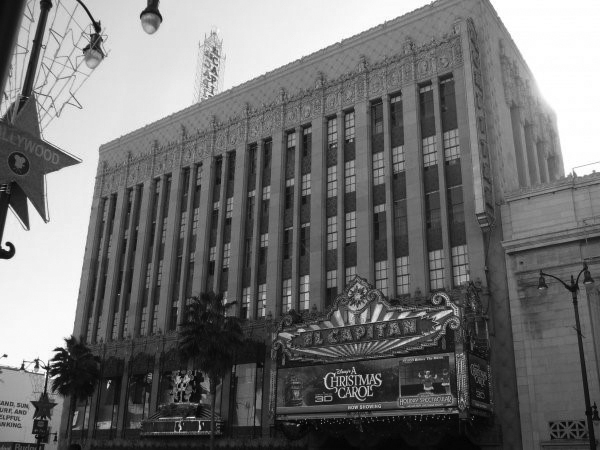 |
|
| (ca. 2009)* - View showing the El Capitan Theatre as seen from in front of the Dolby Theatre and Hollywood-Highland Complex. Now showing: A Christmas Carol. The Disney Soda Fountain and Studio Store is seen on the left. |
Historical Notes The theatre reopened in 1991 as the El Capitan with 998 seats and has since been the showcase for Disney motion pictures. Screenings are often preceded by live stage show productions, most using the theatre’s Wurlitzer organ, which once graced the now-demolished San Francisco Fox Theatre. Street-level office space, once home to a Barker Brothers furniture store, is now a Disney Store and fountain shop. |
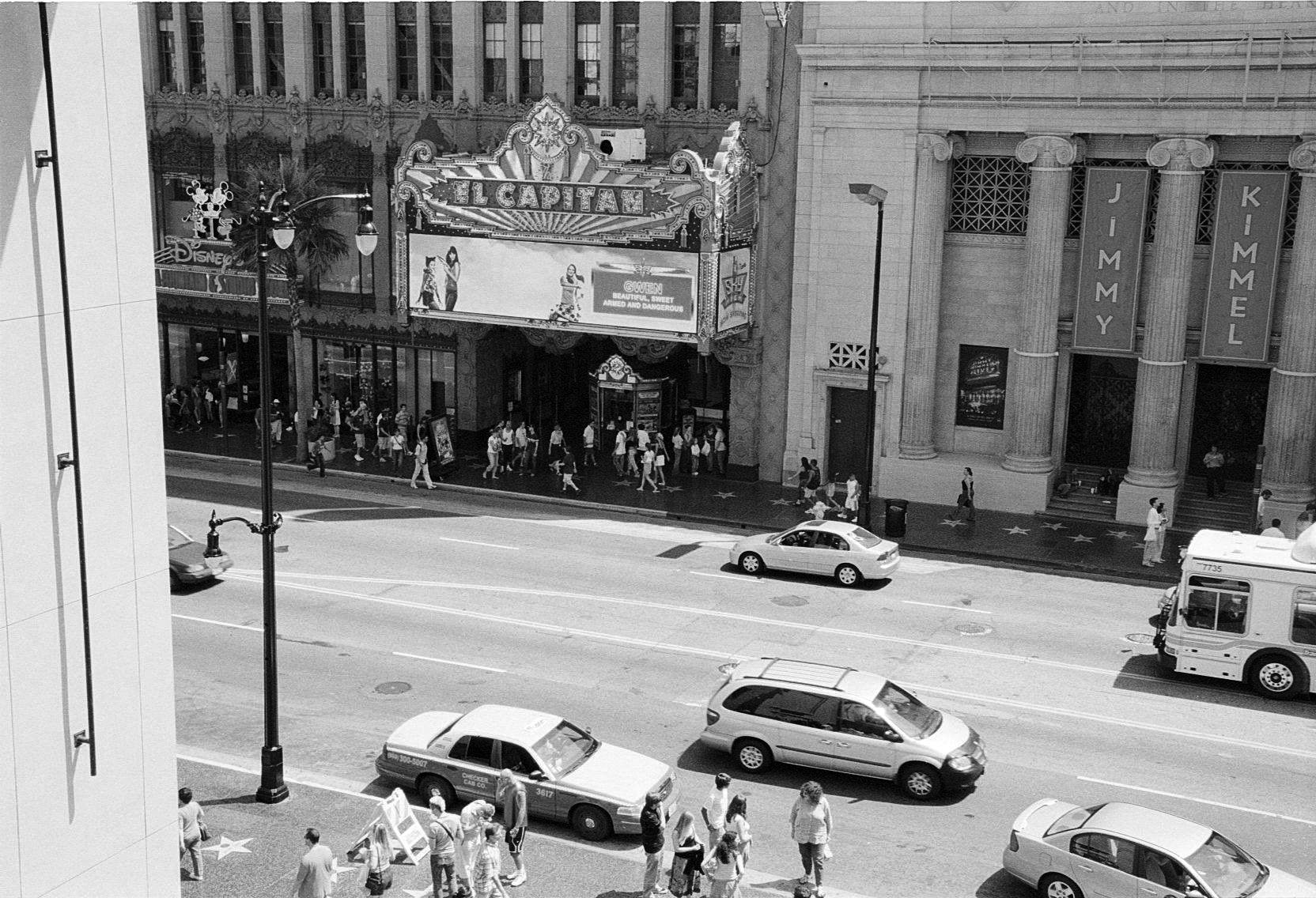 |
|
| (2005)* - View showing the El Capitan as seen from the balcony of the Hollywood & Highland Center. To the left of the theater is the Disney Soda Fountain and Studio Store, to the right is the Jimmy Kimmel Theatre, originally the Hollywood Masonic Temple. Photo by Glen Norman |
Historical Notes In 1990, the El Capitan Theatre Building was declared LA Cultural-Monument No. 495. |
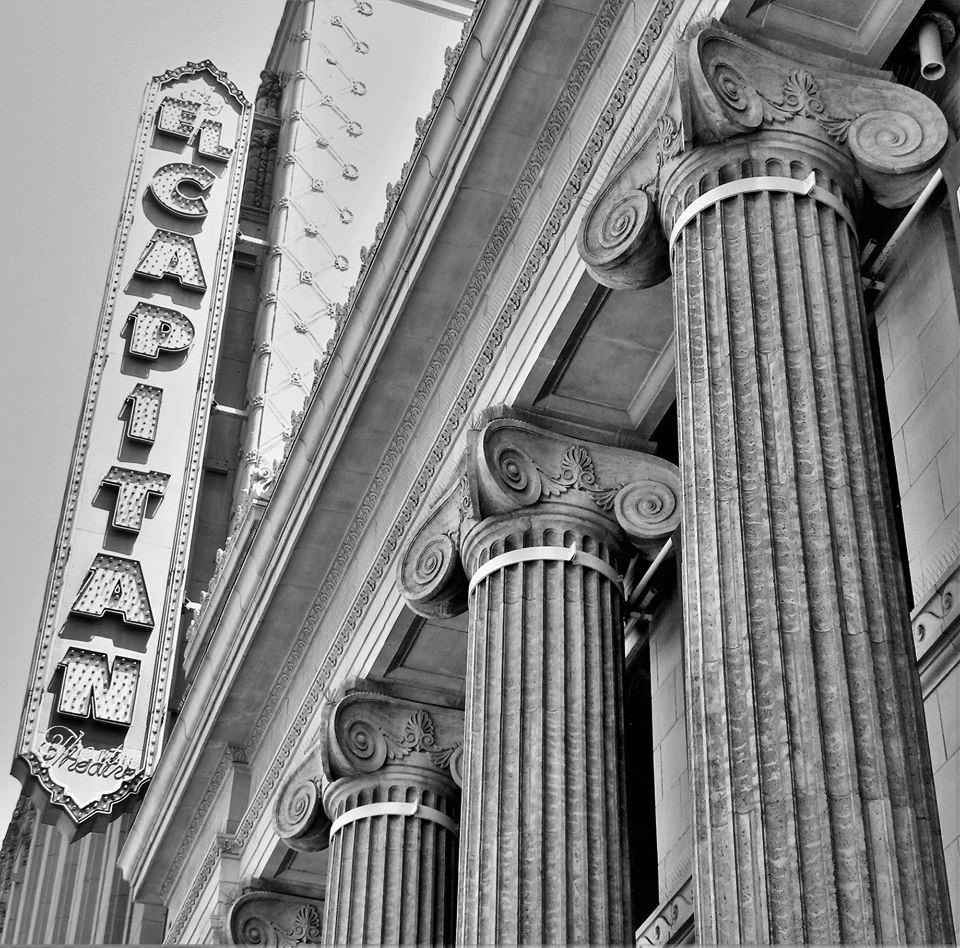 |
|
| (2020)* - The El Capitan Theatre Sign as seen from the front of the old Hollywood Masonic Temple. Photo by Howard Gray |
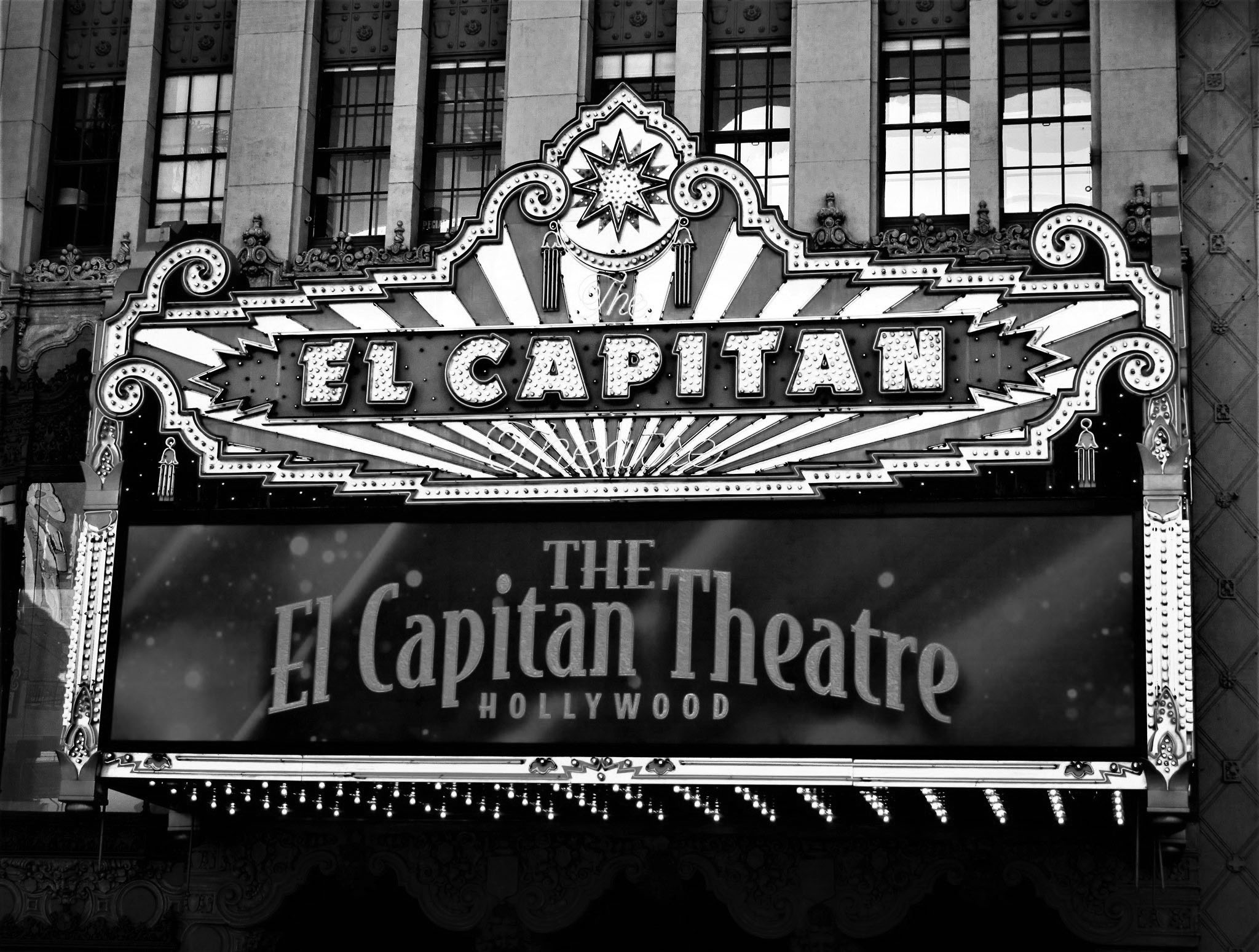 |
|
| (2020)* - The El Capitan Theatre – HOLLYWOOD. Photo by Howard Gray |
* * * * * |
Roosevelt Hotel
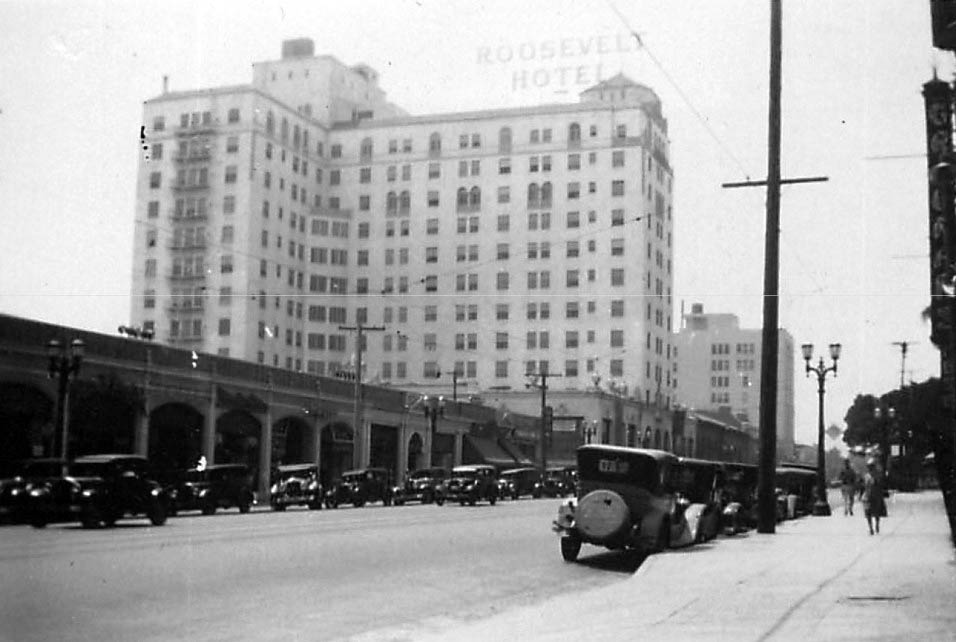 |
|
| (ca. 1929)* - Street view looking west showing the Roosevelt Hotel located at 7000 Hollywood Boulevard. Cars are parked in front of the one-story shops along the south side of Hollywood Boulevard. The blade sign of Grauman's Chinese Theatre can be seen on the right edge of photo. |
Historical Notes The historic Hollywood Roosevelt Hotel was designed by Architects Fisher, Lake & Traver in Spanish Colonial Revival style. Named after United States president Theodore Roosevelt, the hotel was financed by a group including Douglas Fairbanks, Mary Pickford and Louis B. Mayer. |
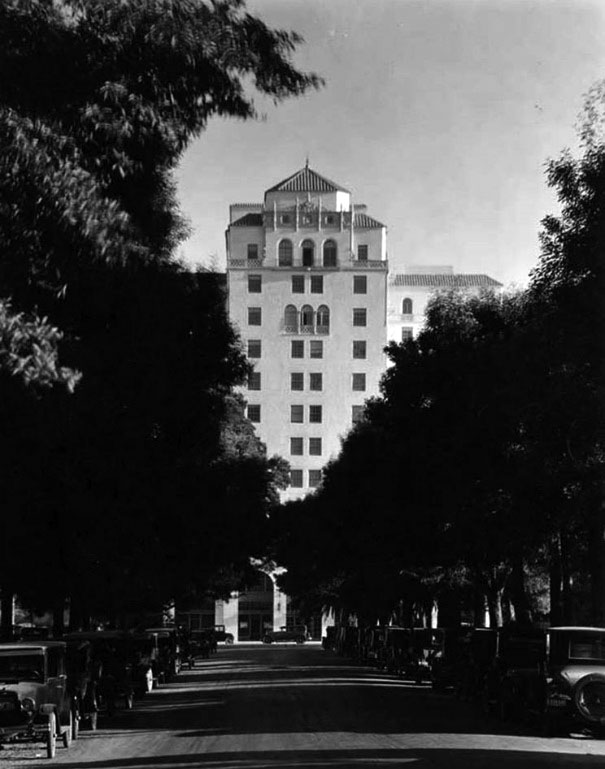 |
|
| (1927)^*^# – View looking south on Orange Drive toward Hollywood Boulevard where The Hollywood Roosevelt Hotel stands tall. The hotel is located at 7000 Hollywood Boulevard. Click HERE for contemporary view. |
Historical Notes The hotel first opened its doors on May 15, 1927. It cost $2.5 million ($33.9 million in today's money or dollars) to complete this twelve-story building, which holds 300 rooms and suites. |
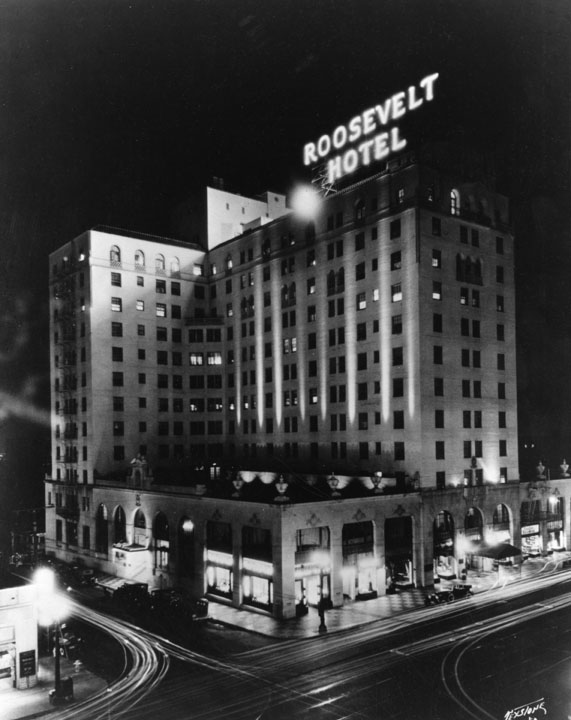 |
|
| (1930s)* - Exterior night view of the Roosevelt Hotel located on the southwest corner of Hollywood Boulevard and Orange Drive. |
Historical Notes The Hollywood Roosevelt Hotel hosted the presentation of the 1st Academy Awards in 1929 inside its Blossom ballroom. Later ceremonies were much larger than this banquet for 250, so there was never an attempt to host the awards at the hotel a third time. |
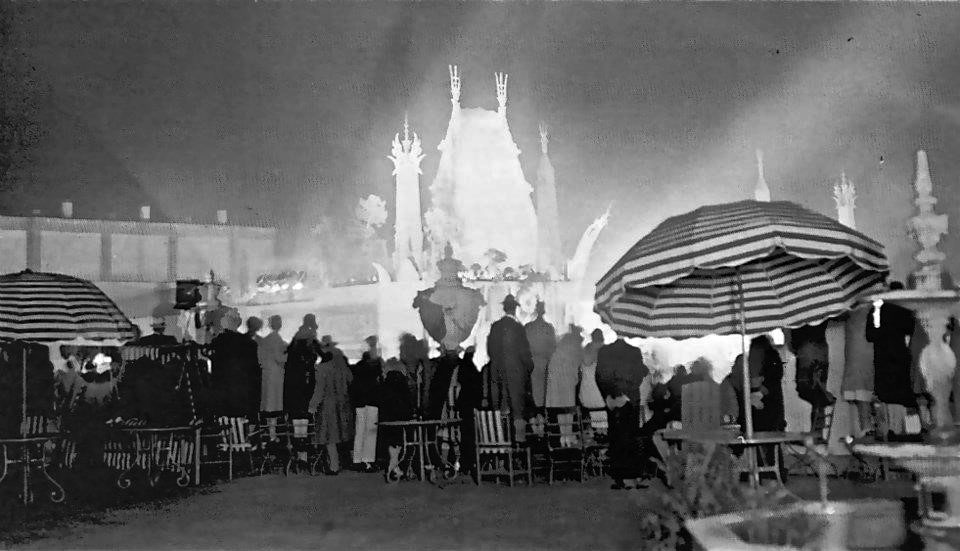 |
|
| (1935)* - Film fans stand on the roof of the Roosevelt Hotel and watch a big Hollywood movie premiere take place across the road at Grauman’s Chinese. |
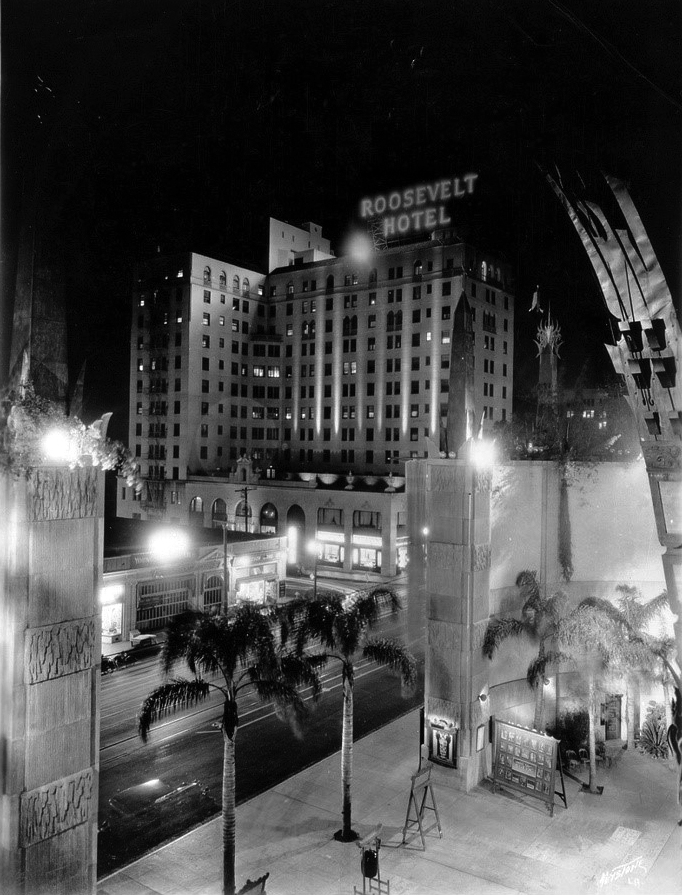 |
|
| (ca. 1930s)#^* - View of the Roosevelt Hotel located 7000 Hollywood Boulevard as seen from the courtyard of Grauman's Chinese Theatre. |
Historical Notes Marilyn Monroe was a resident at the Hollywood Roosevelt for two years when her modeling career took off. Her first magazine shoot was taken in the Roosevelt. Clark Gable and Carole Lombard paid five dollars a night for their penthouse; it is now named the Gable & Lombard Penthouse. There is also a Marilyn Monroe Suite at the hotel. |
.jpg) |
|
| (2016)++# - View looking across Hollywood Boulevard toward the Roosevelt Hotel as seen from the front of the Chinese Theatre. |
Historical Notes There have been many rumors of hauntings at this hotel. Some involve celebrities, such as Marilyn Monroe, Montgomery Clift, and Errol Flynn. Others involve a little girl in a blue dress. There have also been reports of cold spots, photographic "orbs", and mysterious phone calls to the hotel operator. |
* * * * * |
Hollywood Boulevard
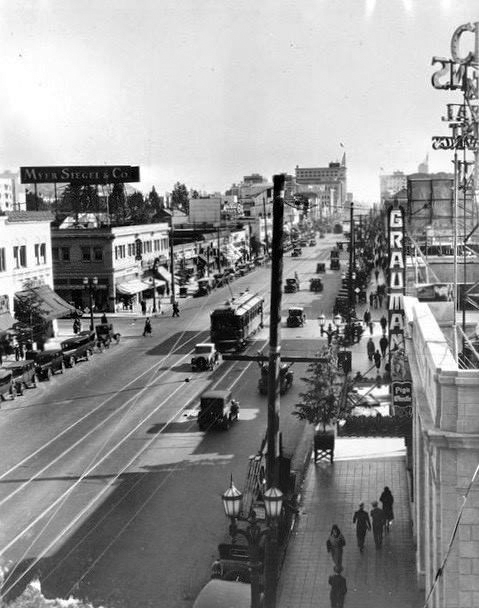 |
|
| (1928)#**# – View looking east on Hollywood Boulevard from McCadden Place. The vertical sign for Grauman's Egyptian Theatre can be seen on the right, with the Pig 'N Whistle Café next door—both are still there. Across the street is a sign for the Myer Siegel & Co. department store. |
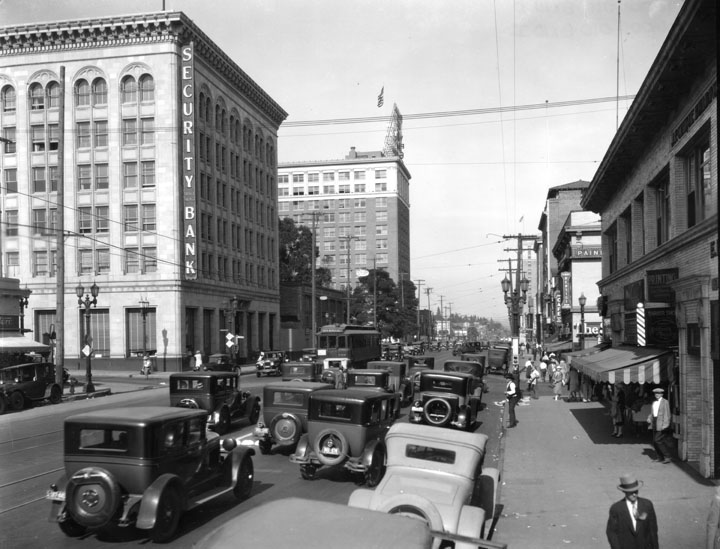 |
|
| (1928)* - View of traffic traveling on Hollywood Blvd. at Cahuenga in 1928. The Security Trust and Savings Bank building is on the far left side of the photograph. |
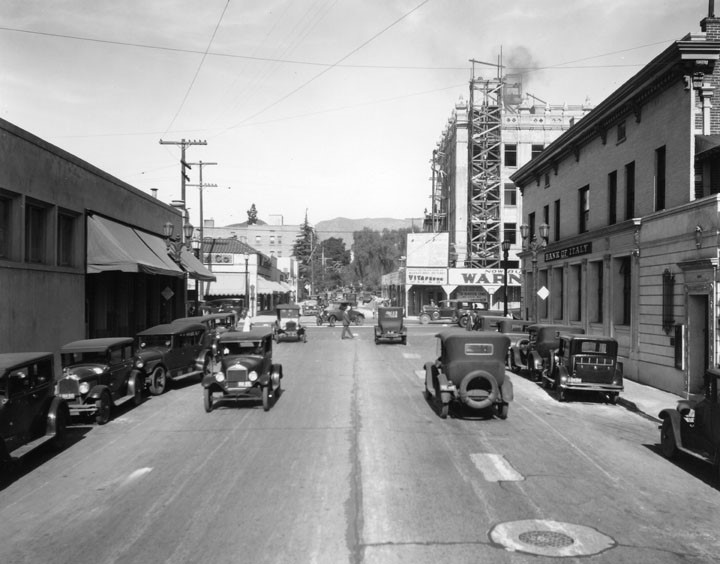 |
|
| (1928)* – View looking north on Wilcox Avenue toward Hollywood Boulevard, where the Warner Bros. Theatre on the NE corner is under construction. The Bank of Italy is on the right, SE corner. |
* * * * * |
Warner Bros. Theatre (later Hollywood Pacific Theatre)
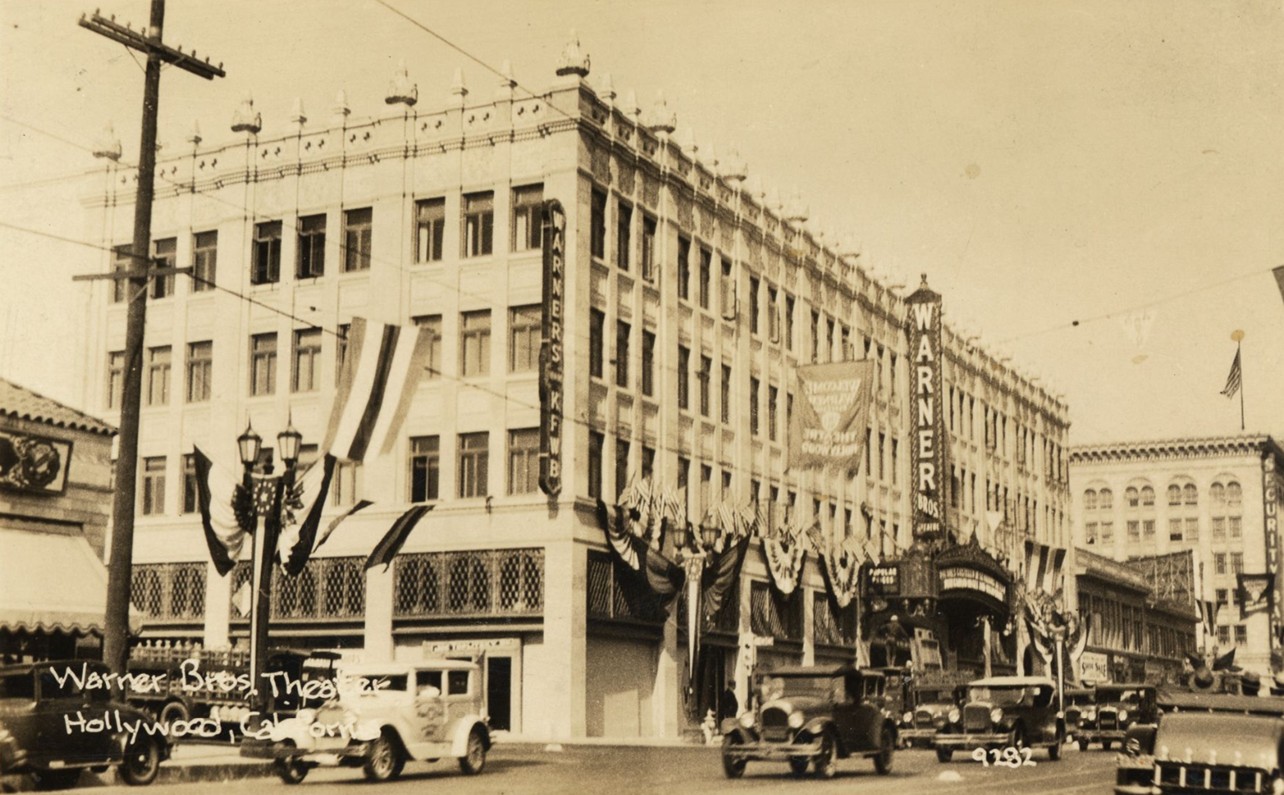 |
|
| (1928)* - Image showing the Warner Bros. Theatre in Hollywood, richly decorated, likely around the time of its grand opening. It captures the glamour and optimism of early Hollywood's golden age — and stands as an architectural jewel that helped usher in the era of sound motion pictures. |
Historical Notes The Warner Bros. Theatre on Hollywood Boulevard, also known as the Hollywood Pacific Theatre, opened in 1928 as Warner Bros.’ West Coast flagship movie palace. Designed by architect G. Albert Lansburgh, the building is an architectural gem featuring Spanish Colonial Revival and Churrigueresque styles, with ornate façades, a grand lobby, and an atmospheric auditorium that could seat nearly 2,800 people. Its construction reflected Warner Bros.’ ambition during the golden age of Hollywood and the dawn of sound cinema. |
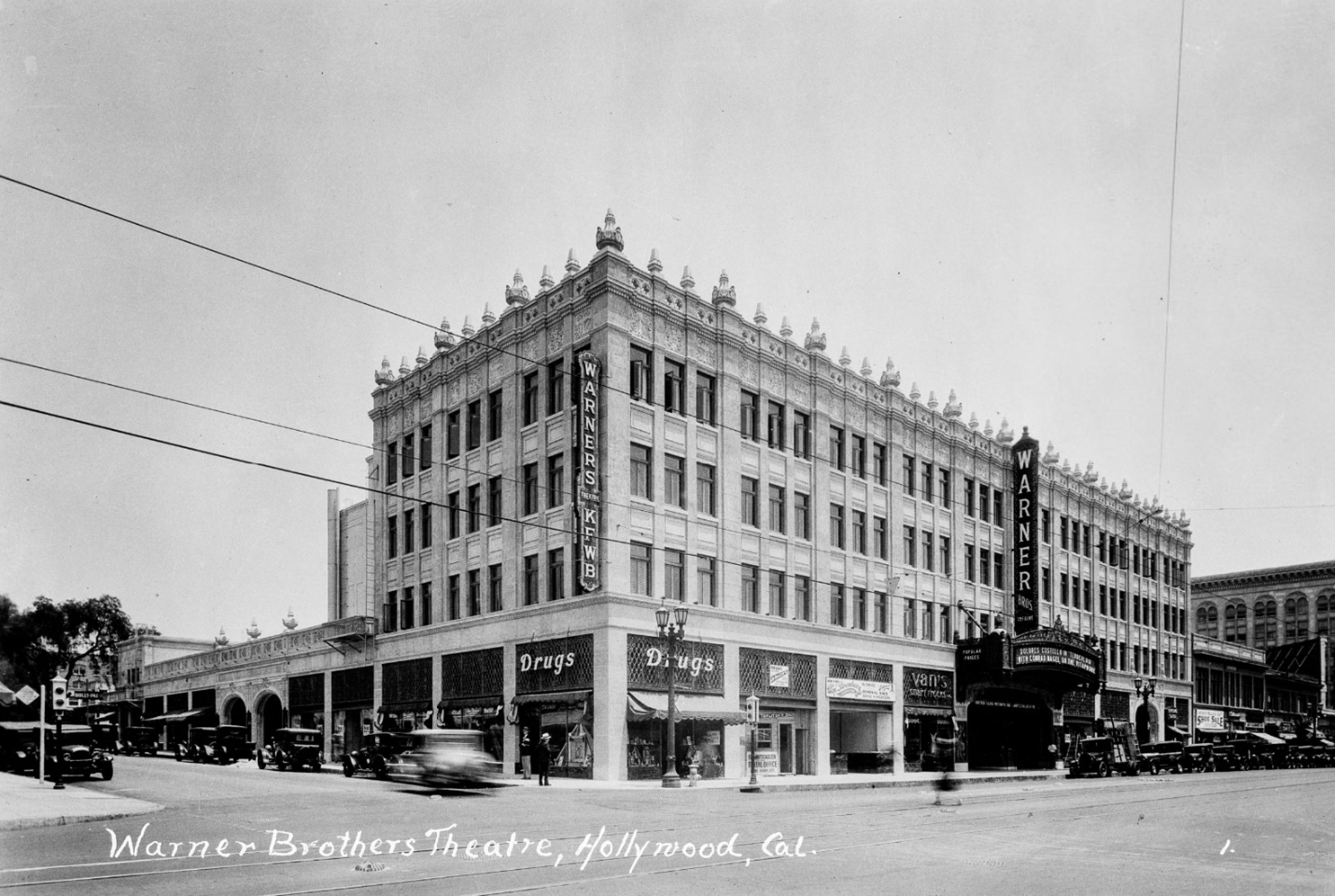 |
|
| (1928)* – View of the newly opened Warner Brothers Theatre in Hollywood. Featuring the latest in Vitaphone sound technology, the theater stood as a glamorous symbol of Hollywood’s transition from silent films to the talkie era. Photo by Bob Plunkett. |
Historical Notes The theatre was purpose-built to showcase Warner Bros.’ pioneering sound films, debuting with the Vitaphone system and the movie "Glorious Betsy." Besides film screenings, the building also housed retail shops, offices, and the studios for Warner Bros.’ radio station KFWB, making it a bustling entertainment hub. Over the years, it adapted to changing times, undergoing renovations for Cinerama presentations in the 1950s and being divided into three smaller theaters in the 1970s. |
 |
|
| (ca. 1928)* - The Warner Bros. Building and Theatre (Later the Hollywood Pacific Theatre), located at 6423-6445 Hollywood Boulevard. This photo was taken shortly before Warner Bros. installed two radio transmitting towers on top of the building. |
Historical Notes The Warner Bros. Building still stands today. In 1993 it was designated Los Angeles Historic-Cultural Monument No. 572 (Click HERE to see complete listing). |
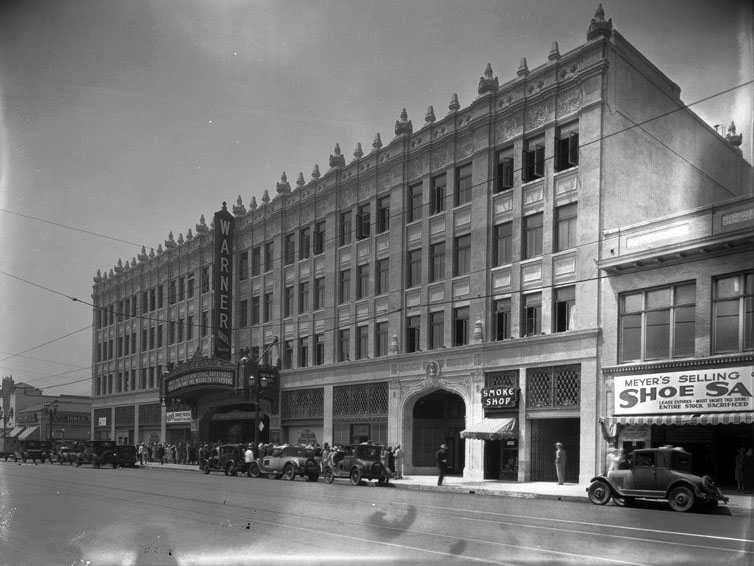 |
|
| (1928)* – View looking northwest across Hollywood Boulevard showing the new Warner Bros. Building and Theatre. The four-story building also includes a drug store, dress shop, smoke shop, and offices. Marquee reads May McAvoy and Lionel Barrymore in The Lion and the Mouse on Vitaphone. Architect: G. Albert Lansburgh. Click HERE for contemporary view. |
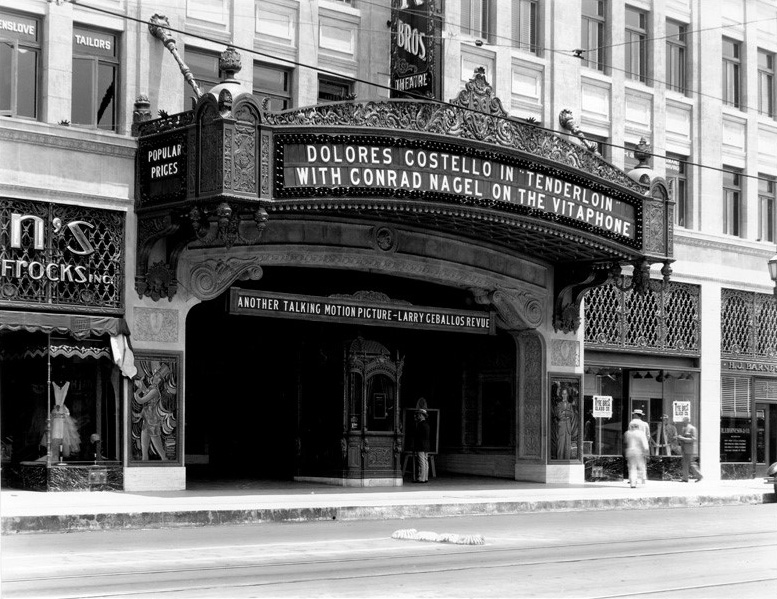 |
|
| (1928)* - View showing the entrance to the Warner Bros. Theatre. Now Playing: Tenderloin with Dolores Costello and Conrad Nagel, “On the Vitaphone”. |
Historical Notes On the great stage between screenings of the feature was the Ceballos Revue with Daphne Pollard, Harry Kelly and the girls. |
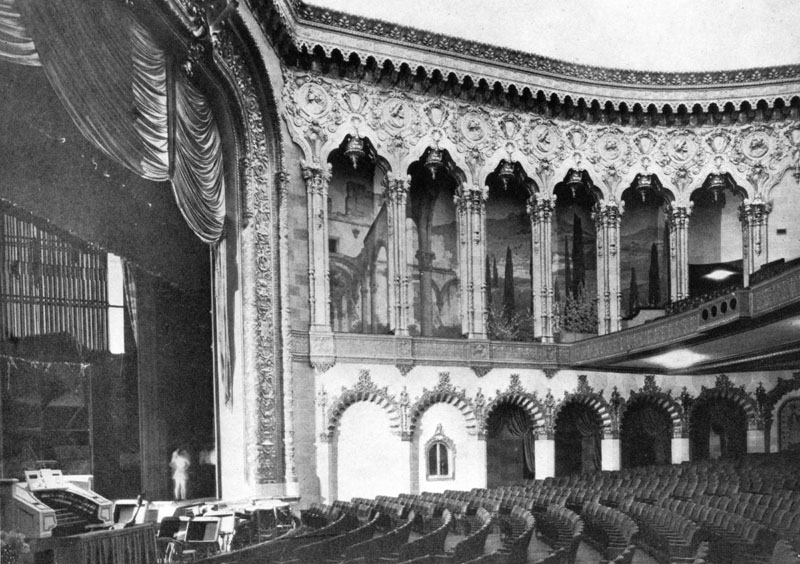 |
|
| (1928)* - Interior view of the Warner Bros. Theatre at the time of its opening. A very large organ can be seen to the left in the orchestra pit. |
Historical Notes The murals were designed by Albert Herter. |
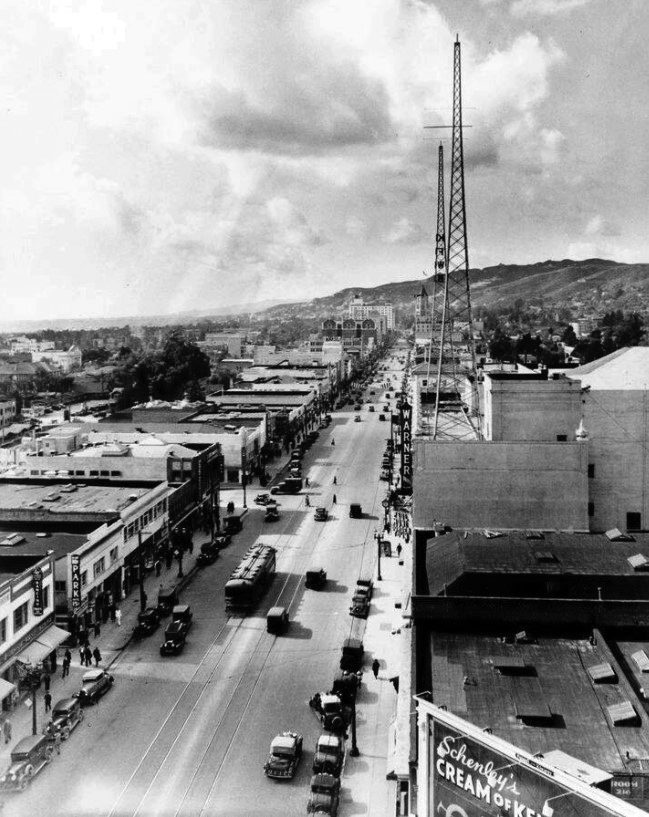 |
|
| (1930)* – View looking west on Hollywood Boulevard showing the Warner Bros. Building and Theatre on the right with its two newly installed roof-mounted radio transmitter towers. The call letters 'KFWB' can bee seen on one of the towers. |
Historical Notes Warner Bros. owned radio station KFWB and in 1930 installed its radio transmitter towers on top of the Warner building, which remain to this day. Though covered by "PACIFIC" lettering, the original "WARNERS" lettering can still be seen inside each tower. |
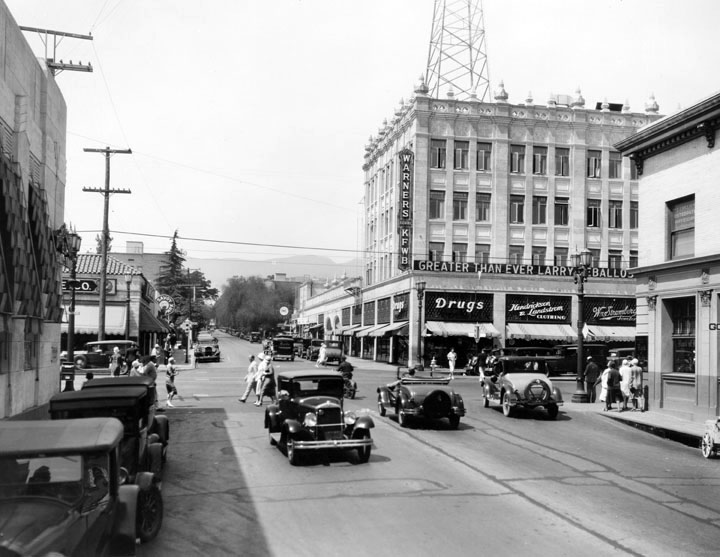 |
|
| (1930)* - View of the intersection looking north on Wilcox Avenue at Hollywood Boulevard. A sign announces Warners Theatre and KFWB at the intersection, along with Hendrickson and Landstrom Clothing and William Stromberg Jeweler in the building on the northeast corner. |
Historical Notes Warner Bros. Hollywood Theatre has also been known as Warner's, the Warner, Warner Cinerama, Warner Hollywood Cinerama, the Hollywood Pacific and the Hollywood Pacific 1-2-3. |
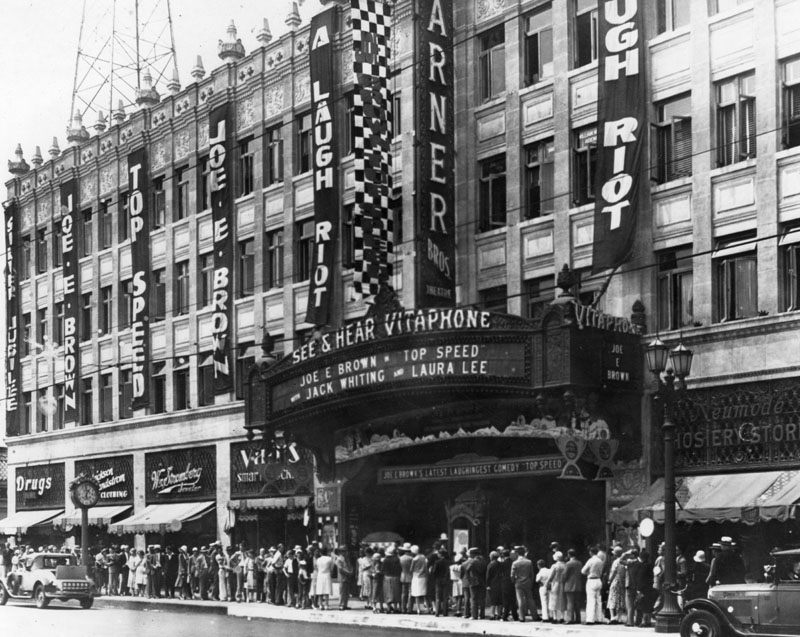 |
|
| (1930)* - Exterior with crowds for matinee performance of Joe E. Brown in "Top Speed" at the Warner Bros. Theatre on Hollywood Boulevard. The lettering on top of the marquis reads: SEE & HER VITAPHONE. |
Historical Notes Warner Bros was riding high in the late 1920s as a result of their Vitaphone sound-on-disc process. They got their studios converted first, their theatres wired for sound, and a long string of hit sound films into theatres around the country. |
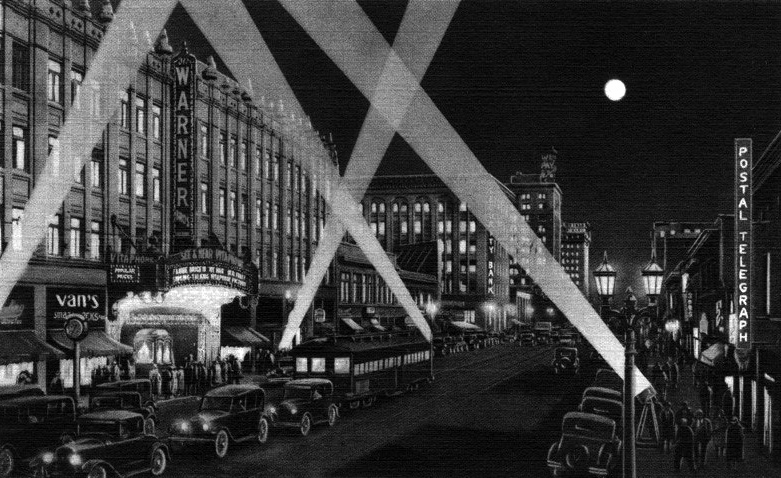 |
|
| (1936)* – Postcard view showing a premier night at the Warner Bros. Theatre on Hollywood Boulevard. |
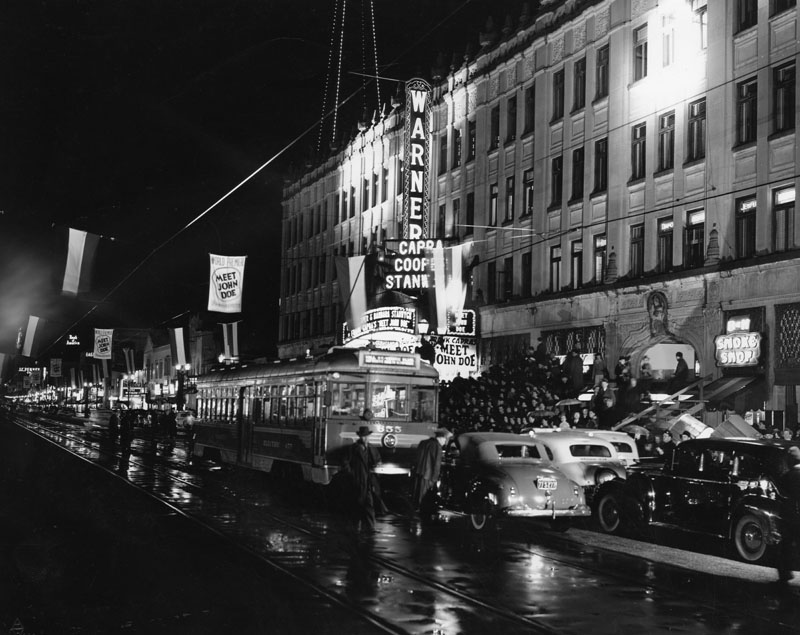 |
|
| (1941)* - Crowds in front of theatre on night of March 12, 1941, for world premiere of "Meet John Doe". |
Historical Notes As of 2025, the theatre portion of the Warner Bros. Theatre building on Hollywood Boulevard (the Hollywood Pacific Theatre) remains vacant and unused, having closed in 1994 due to earthquake damage and later temporary uses like digital projection testing and church services; however, the church that once occupied part of the building ceased operations around 2013, and since then, no regular theatrical or religious activities have taken place there. While the building still stands as a historic Hollywood landmark, neither the theatre nor the former church spaces are currently occupied, leaving the future of the entire structure uncertain. |
Then and Now
 |
|
| Then and Now: The northeast corner of Hollywood Boulevard and Wilcox Avenue, where the historic Warner Bros. Theatre building stands. In 1930, Warner Bros., then owners of radio station KFWB, installed transmitter towers atop the building. Though no longer functional, the towers are still there today as decorative historic features. Photo comparison by Trey Callaway. |
* * * * * |
Highland and Franklin
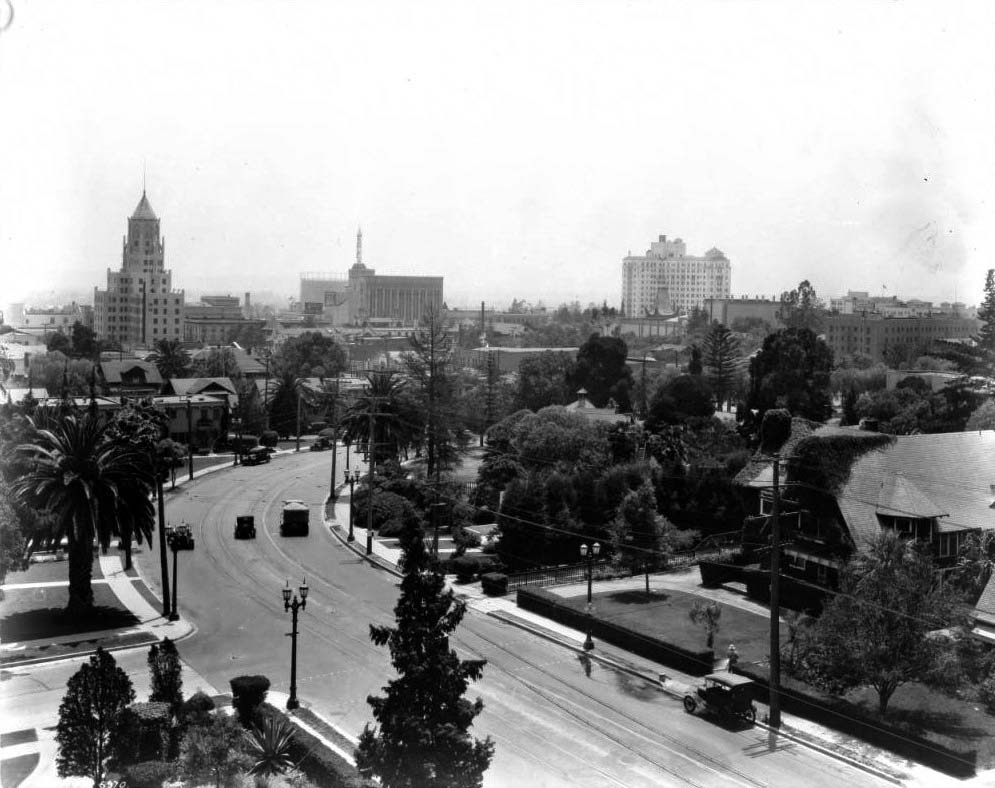 |
|
| (1928)* - View of Hollywood looking south from the head of Highland Avenue near Franklin Avenue. Automobiles navigate the unlined road that curves to the right through residential Hollywood. A street sign reads: "Caution Speed Limit 15 Miles". |
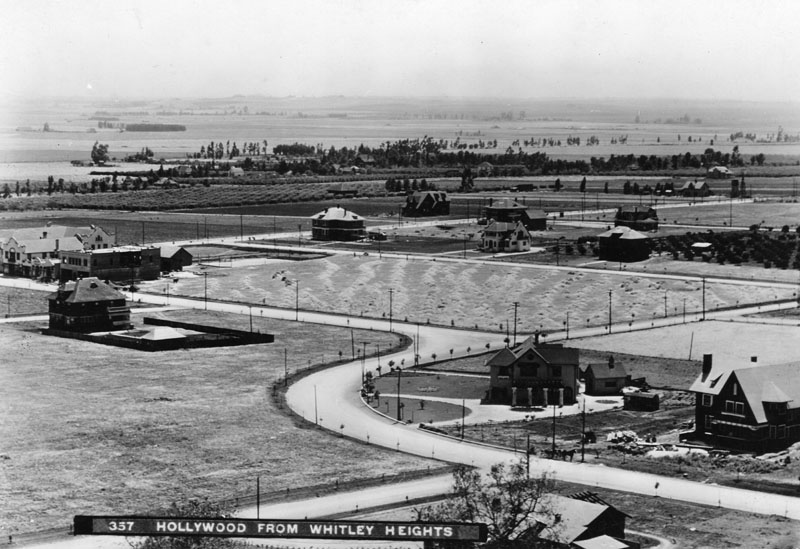 |
|
| (ca. 1903)^ - Panoramic view of Hollywood from Whitley Heights circa 1903, looking southwest from Highland and Franklin Avenues 25 years earlier. The curved configuration of Highland between the East and West sections of Franklin Ave still exists today. The larger structure, seen on the left side of the photo, is the famous Hollywood Hotel. It is situated on the Northwest corner of Hollywood Blvd. and Highland Ave. Today, this is the site of the Hollywood and Highland Center, the current home of the Academy Awards. |
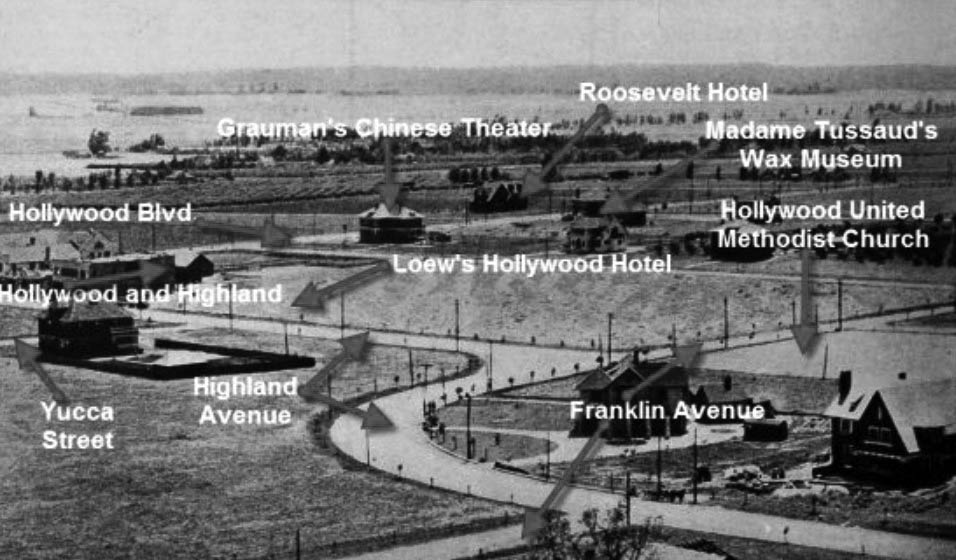 |
|
| (ca. 1903)#^* – Same image as above but annotated to show street names and significant building locations. |
Before and After
.jpg) |
 |
|
| (ca. 1903)* - Highland at Franklin Ave looking southwest. | (1928)^^ - Highland at Franklin Ave looking southwestly. |
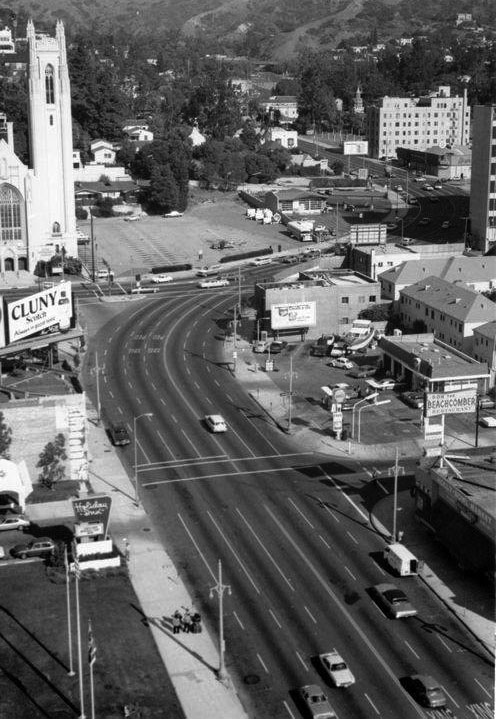 |
|
| (ca. 1970)##^* – View looking north on Highland Ave as seen from the top of the 12-story First Federal Savings and Loan Building. The Hollywood United Methodist Church can be seen on the northwest corner of Highland and Franklin avenues. |
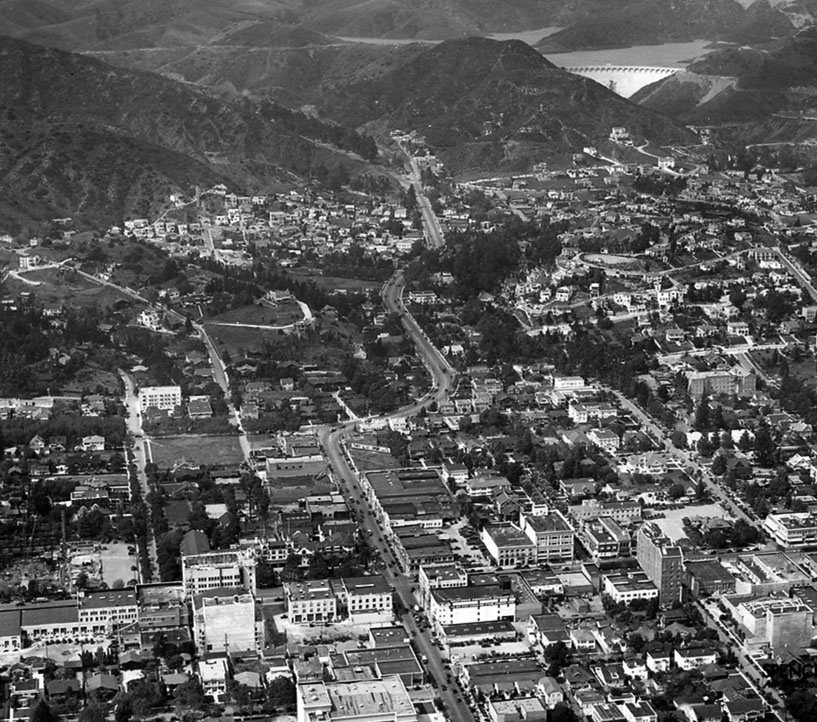 |
| (1926) – Aerial view looking north along Highland Avenue as it heads north into Cahuenga Pass with the Mulholland Dam and Hollywood Reservoir clearly seen in the distance. The intersection of Hollywood and Highland can be seen at center foreground with the Hollywood Hotel at the NW corner. |
Cahuenga Pass
.jpg) |
|
| (1928)* - View of Cahuenga Pass in 1928. There appears to be no lanes for the cars to travel in. |
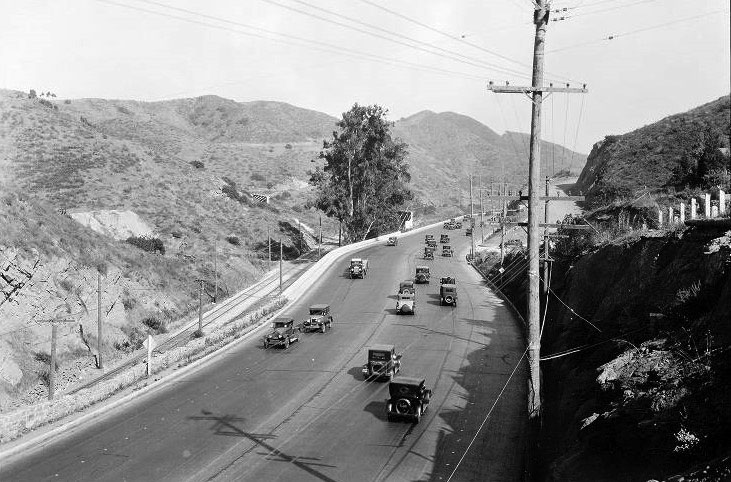 |
|
| (1928)^** - View of Cahuenga Pass Road, south from the Summit. Railway tracks are on the left. |
 |
|
| (ca.1928)* - Cars travel in both directions through the Cahuenga Pass near the Hollywood Bowl. The roadway through the Pass, the lowest through the Santa Monica Mountains, connects the Los Angeles Basin to the San Fernando Valley. The hills are truncated where they were excavated for the road bed. On the left, a large hillside billboard advertises the The Outpost development in the Hollywood Hills. A roadside vendor is setup near the Hollywood Bowl parking sign on the right. |
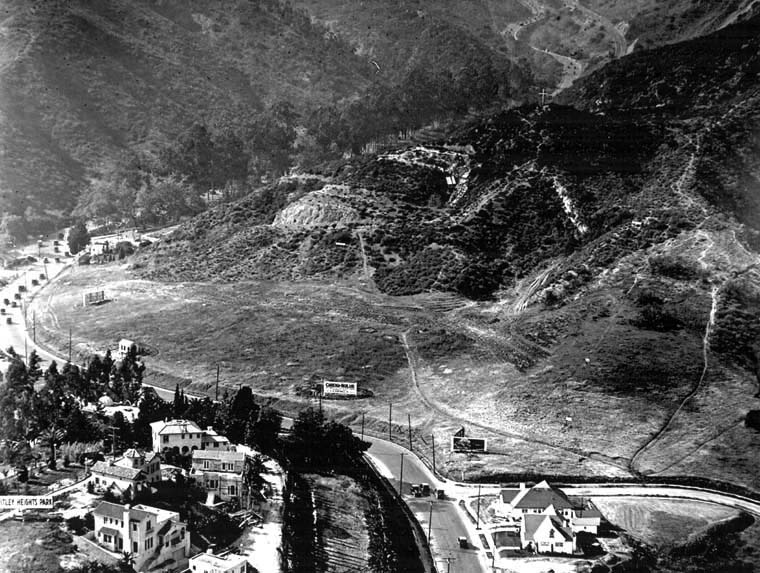 |
|
| (ca. 1930)#^ - Aerial view of Cahuenga Pass looking northwest. Whitley Heights is at the left. The Hollywood Bowl is located at center left (out of view). |
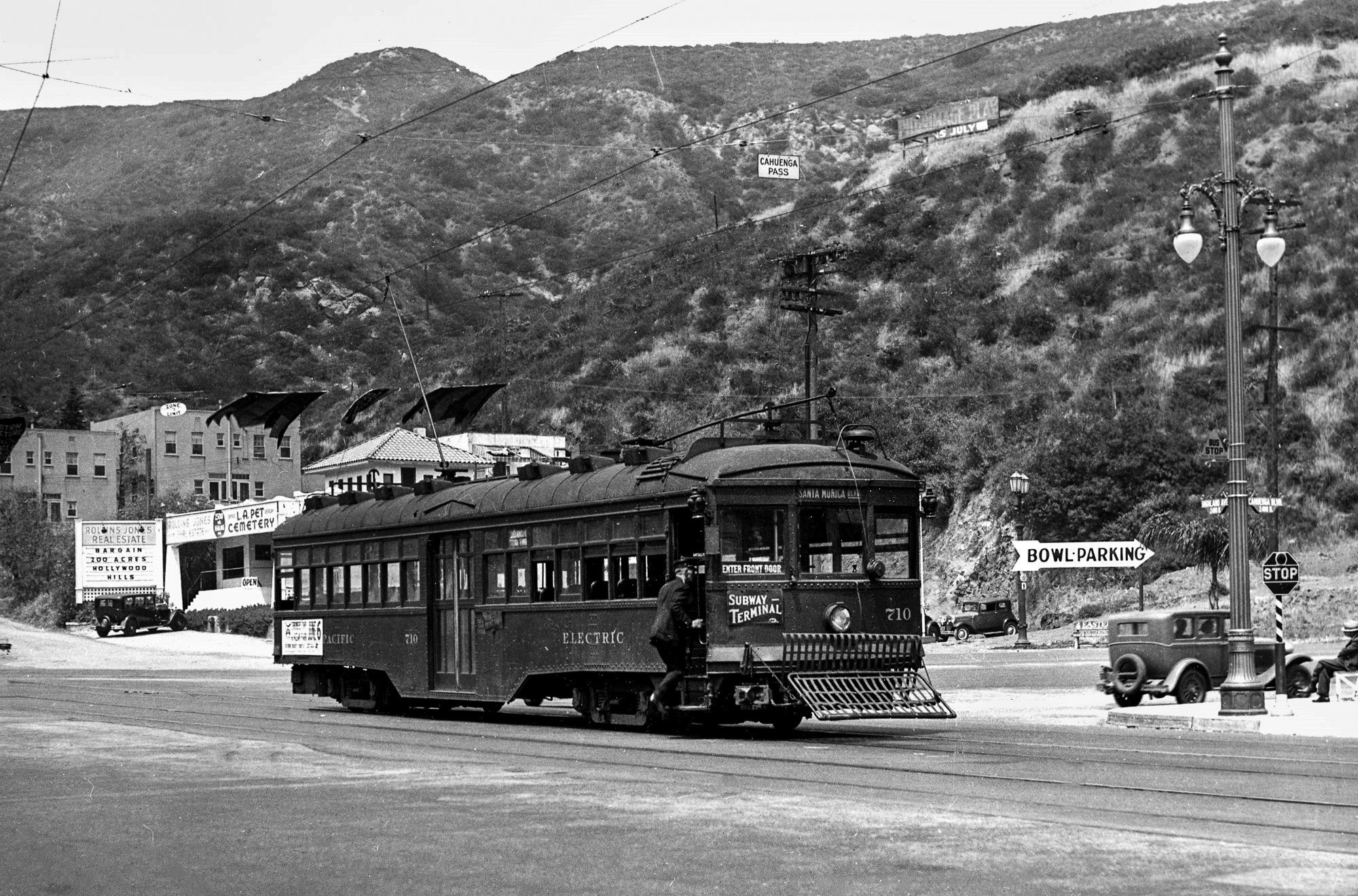 |
|
| (ca. 1930)##+ – View showing Pacific Electric car #710 inbound from the San Fernando Valley through Cahuenga Pass. The streetcar is at the Hollywood Bowl exit at the corner of Highland Ave and Cahuenga Blvd., heading south on Highland to Santa Monica Blvd. |
Click HERE to see more Early Views of Cahuenga Pass |
Annetta Court Apartments
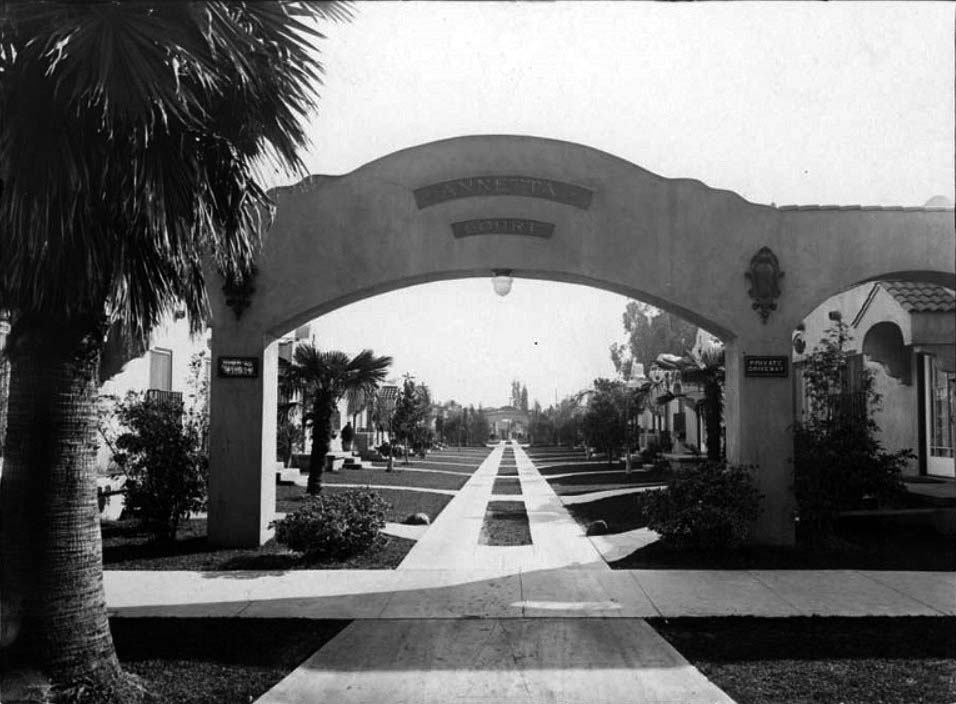 |
|
| (ca. 1928)^^ - View of the Annetta Court Apartments at 5154 Sunset Boulevard in Hollywood. A divided sidewalk runs from the foreground to the background at center. A light-colored archway with the name of the apartments can be seen over the sidewalk in the foreground. And although the apartments themselves are long gone, the street side palms survive and are among the tallest in Hollywood. |
Historical Notes Today a Retirement and Assisted Living Home (Brier Oak on Sunset) stands at the 5154 Sunset location. Click HERE for contemporary view. |
Muller Bros. Service Station
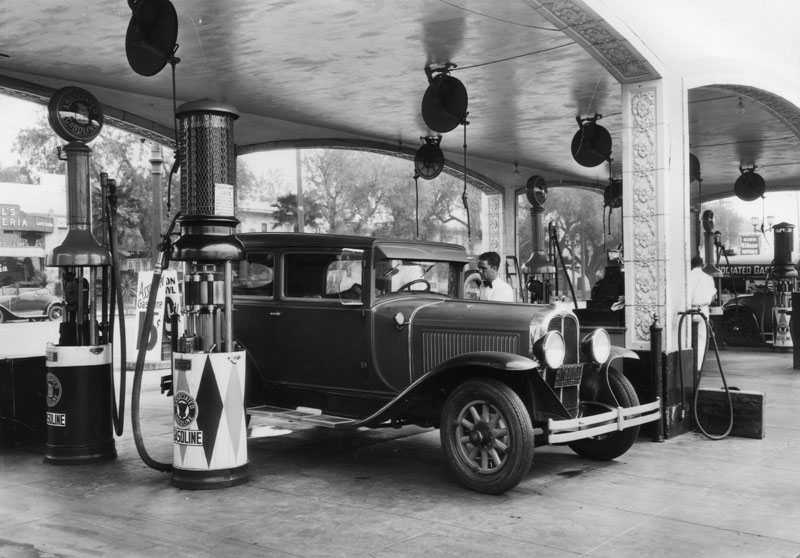 |
|
| (1928)* - A customer gets full service at the gas pumps at Muller Bros. Service Station on Sunset Blvd. |
Historical Notes The Muller family is one of Hollywood’s pioneers. Jacob Muller came to Hollywood in 1893, establishing the first meat market in Hollywood, across from the present Cinerama Dome on Sunset Boulevard. He sold the market in 1907 and established the first ice company in Hollywood, selling that business in 1913. The family’s original house was built Sunset Boulevard at Ivar. This site later became the location of the RCA Building, built by the Muller Family in 1963. (currently the Los Angeles Film School Building). Jacob Muller’s sons, Walter and Frank, opened the Muller Bros. Service Station in 1920.^*^* |
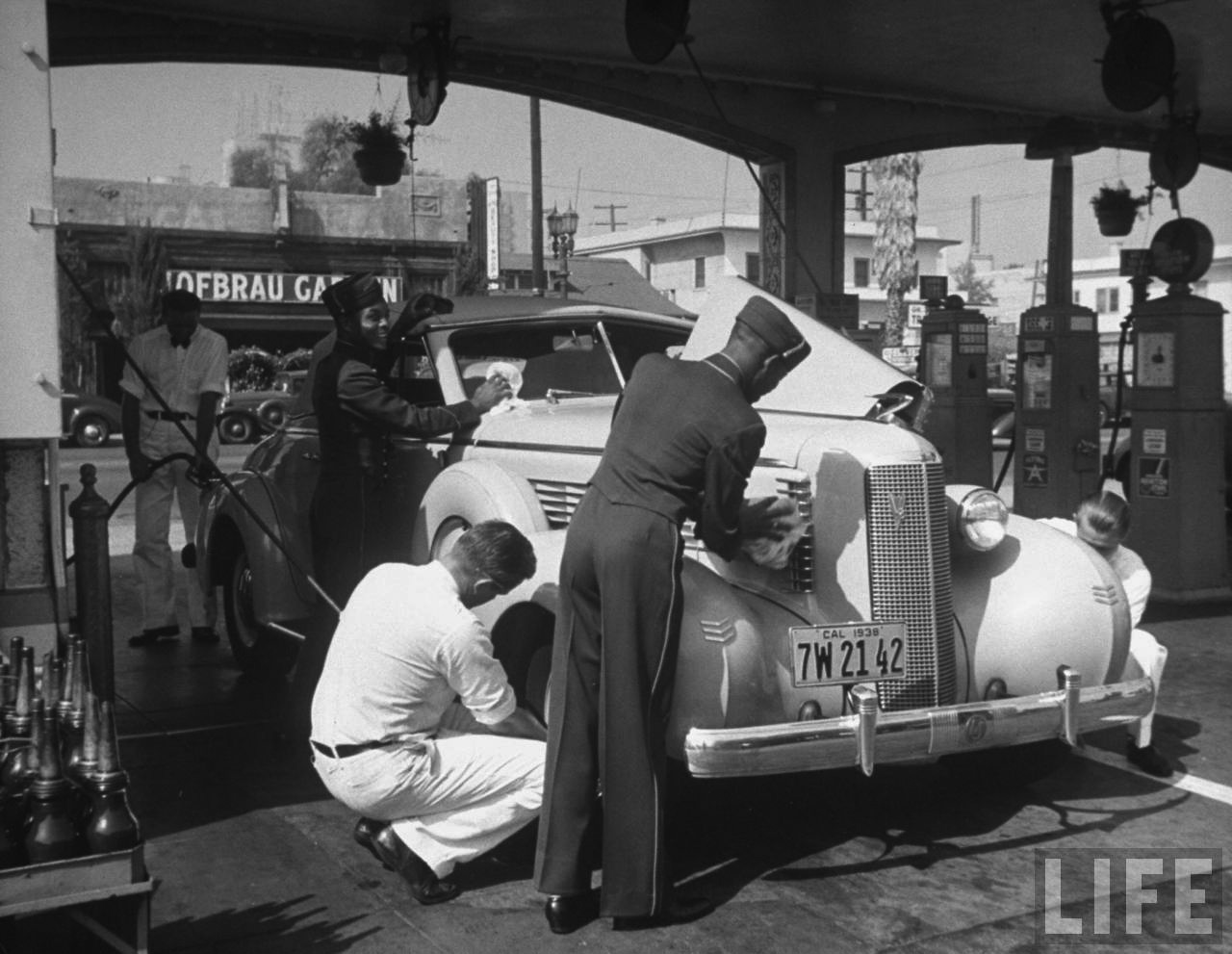 |
|
| (1938)*# - View of what appears to be a 1937 Cadillac LaSalle Opera Coupe being attended to in "full service" at the Muller Brothers Service Station at 6380 Sunset Boulevard in Hollywood. |
Historical Notes The Muller Brothers Service Station was located on the south side of Sunset Boulevard on 4 acres, where the Cinerama Dome Theater is now located. Opened in 1920 by the Muller brothers, Walter and Frank, this became the largest service station in the world (including a large automobile supply center), employing 120 people by 1937. Celebrities, from Rudolph Valentino to Clark Gable, came by regularly to get gas or just work on their cars. In 1963 the site was sold for the Cinerama Dome Theater, and, at that time, an eventual hotel.^*^* Click HERE to see more Early Views of LA Gas Stations. |
* * * * * |
Hotel Christie
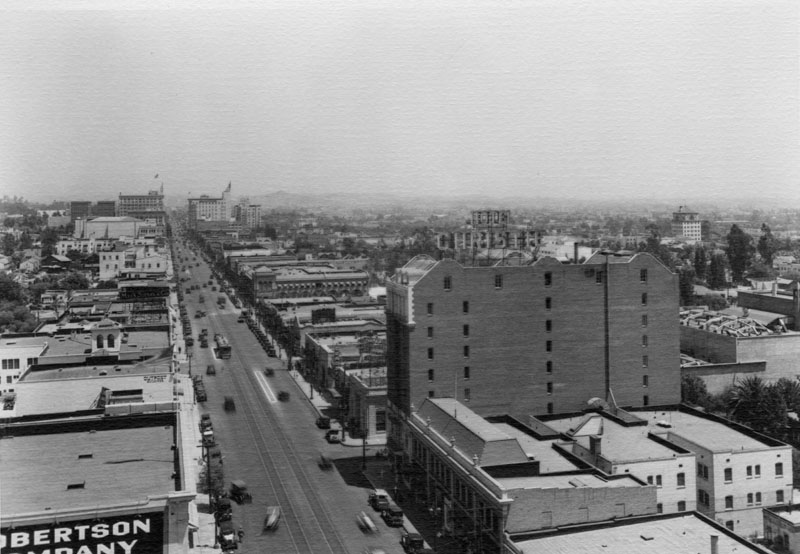 |
|
| (1928)* - Panoramic view of Hollywood, looking east over Hollywood Blvd. from the tower of Hollywood First National Bank Building's northeast corner at Highland Avenue. The Hotel Christie, at 6724 Hollywood Boulevard, is at right. The hotel is divided into three towers. Three dormers with rounded pediments project above the roofline. |
Historical Notes Haldane H. Christie was a pioneering auto parts manufacturer who started out producing axles and springs. In 1914, he sold his Michigan-based car top company to Henry Ford and moved to Los Angeles. Here, he quickly became a real estate developer specializing in property along Hollywood Boulevard and in the Hollywood Hills. In 1920, he commissioned construction of Hollywood's first 'modern' luxury hotel (Hotel Christie) at the southwest corner of Hollywood Boulevard and McCadden Place.^^# |
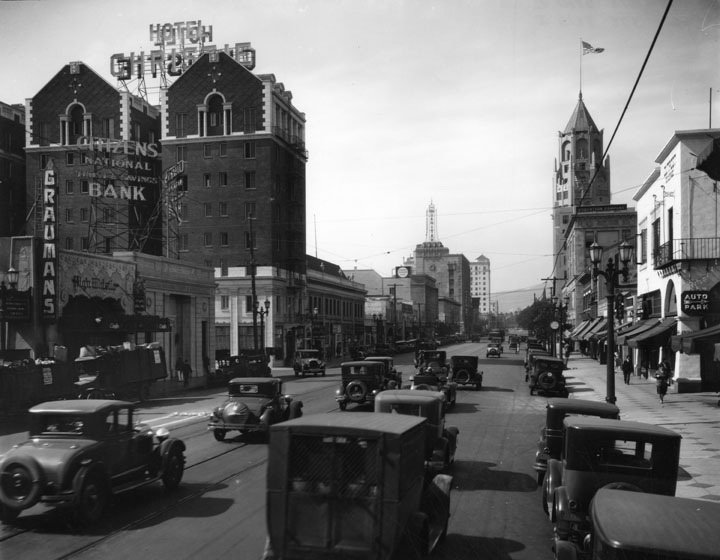 |
|
| (ca. 1928)* - Looking west on the blvd. from Grauman's Egyptian Theatre. On the left street side are signs for: Grauman's, Citizen's National Trust & Savings Bank, the Hotel Christie and in the distance the El Capitan Theatre. On the right side in the distance is the First National Bank Building. |
Historical Notes The eight-story Georgian Revival building with steeply pitched gable roofs was considered Hollywood's first skyscraper when it opened in 1922. Architect Arthur R. Kelly, best known at the time for his residential designs, created three brick towers connected to ground-level shops. The Christie Hotel boasted amenities that included steam heat and individual bathrooms for each of its 100 guest rooms — a first for Hollywood. The hotel’s Greenwich Village Café was a popular gathering spot for the film industry people in the 1920s.^^# |
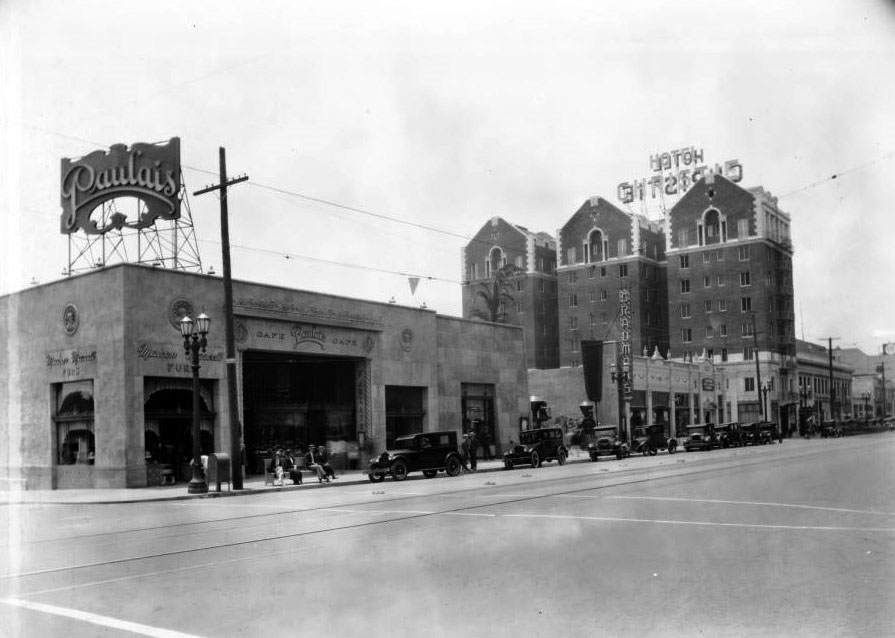 |
|
| (ca. 1925)^^ - View looking at the southwest corner of Hollywood Boulevard and Las Palmas Avenue showing the Paulais Café. The cafe has a large, elaborate sign affixed to its roof, which reads "Paulais" in underlined script letters. Three women and one man can be seen sitting on a bench outside the cafe, and several other people can be seen standing on the sidewalk, near several early model automobiles parked on the side of the road. Next to the cafe, a sign reading "Graumans" can be read vertically in front of a theater. The Christie Hotel can be seen west of the theatre. |
Historical Notes Haldane Christie continued his ownership of the hotel and his realty work until his death in 1941 at age 71. In 1945, the Hotel Christie was renamed the Drake Hotel and later became the Hollywood Inn. These days, the structure is owned by the Church of Scientology.^^# |
* * * * * |
 |
|
| (ca. 1928)#**# – View looking southeast toward Hollywood Boulevard as seen from the Hollywood Hills showing from left to right: First National Bank Building, Hollywood Hotel, El Capitan Theatre, Grauman's Chinese Theatre, and Roosevelt Hotel. |
Historical Notes The above photo was taken from just behind the Pagoda that was/is slightly down the hill from the Bernheimer Mansion (currently the Yamashiro Restaurant). |
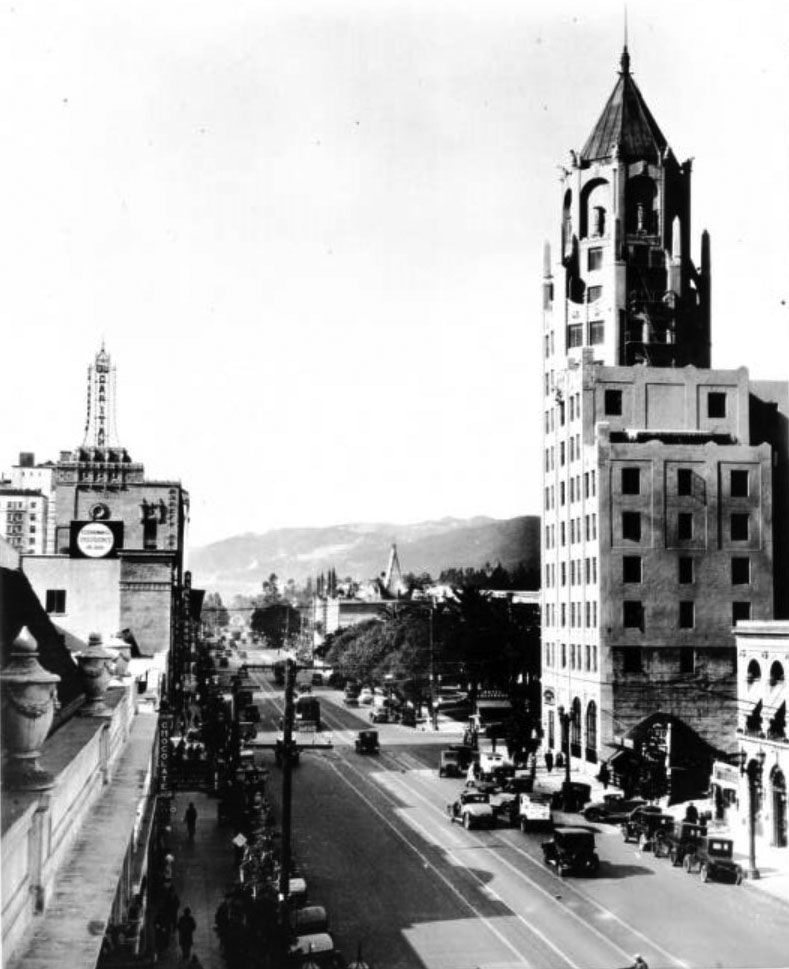 |
|
| (1928)^^ - View of Hollywood Boulevard looking west from McCadden Place. In the distance can be seen Grauman's Chinese Theatre. To the right is the 13-story Art Deco/Gothic style First National Bank Building located on the northeast corner of Highland and Hollywood Blvd. |
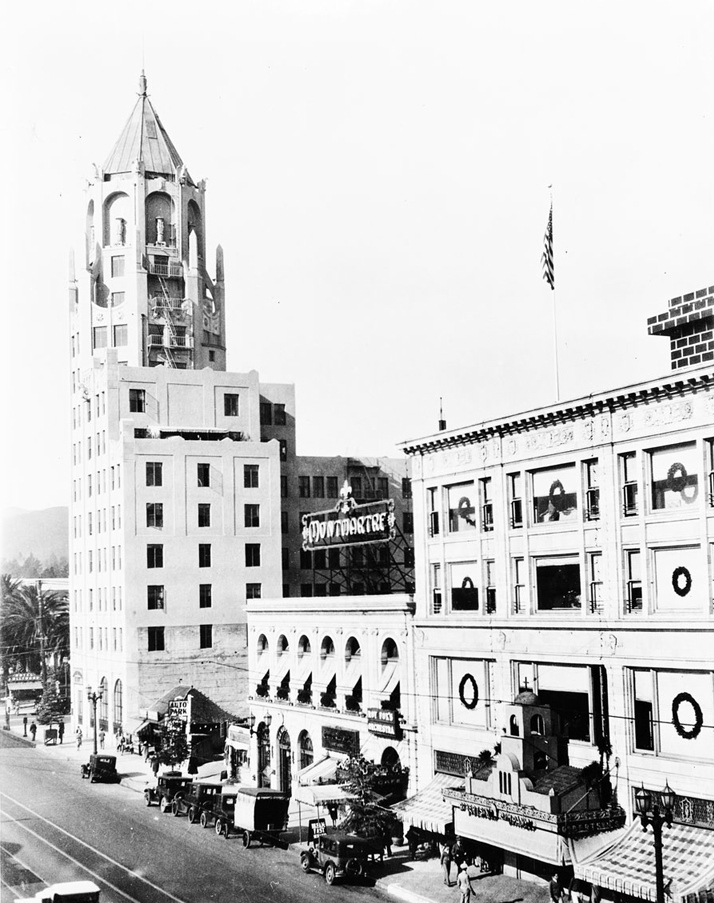 |
|
| (1928)^ - View of Hollywood Boulevard west from McCadden Place. First National Bank Building stands tall on the northeast corner of Highland and Hollywood Blvd. In center of the photo is the Montmartre Cafe, the first nightclub in Hollywood. |
Montmartre Cafe
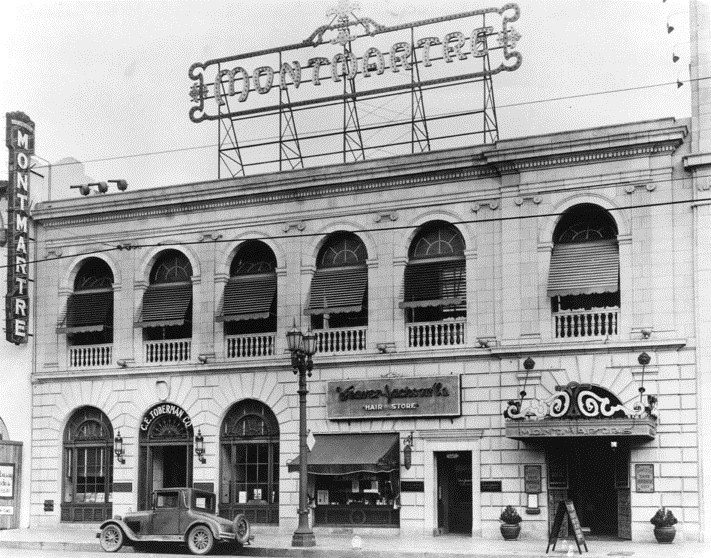 |
|
| (1924)* - The Montmartre name is on the top and the corner of the building, and over the doorway on the right. To the left are the doorways of a hair store, and of the C.E. Toberman Co. Six windows across on the second floor each have individual shade awnings. |
Historical Notes Eddie Brandstatter was one of Hollywood's greatest early restaurateurs. A native of France, he worked in Paris, London and New York restaurants before moving to Los Angeles in the 1910s. In 1923 he built the famous Cafe Montmartre, designed by Meyer and Holler, at a cost of $150,000. This establishment was described as "the center of Hollywood life", where stars usually frequented, and which was the place to see and be seen. |
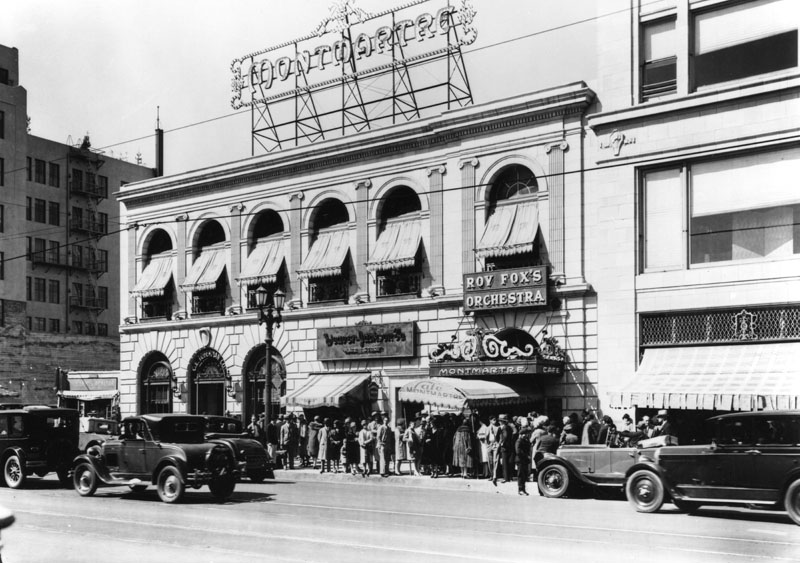 |
|
| (ca. 1928)* - Exterior view of the Montmartre Cafe, located at on Hollywood Blvd. between Highland and McCadden. It has a large lighted sign on top, and another which features Roy Fox's Orchestra. Crowds of people are waiting in line to get into the Cafe. |
Historical Notes Eddie Brandstatter was "Host of Hollywood" and catered to Hollywood stars in the 1920s and 1930s. He was owner and manager of the fashionable Montmartre Cafe, Embassy Club and Sardi's.* |
 |
|
| (1930)* - A large crowd in the Montmartre Cafe is variously standing, dancing or seated at tables. |
Historical Notes in 1932 Brandstatter declared bankruptcy and sold Montmartre. At one point, he was charged with grand theft in a dispute with Hollywood real estate developer C.E. Toberman for having stolen furnishings, drapes, china, and a large "nude statue" of a woman, as well as other valuables and was convicted, though he was given two years probation after returning the property. In 1933 he bounced back and opened Sardi's, only to be again convicted for illegally selling "stimulants" at the establishment. Sadly, Sardi's Restaurant was destroyed by fire on November 2, 1936. The last venue Brandstatter opened and operated was the Bohemian Grill on Vine. On January 20, 1940 Brandstatter's wife, Helen, found the once-famous restaurateur dead in their home garage in Sherman Oaks. He had committed suicide by carbon monoxide poisoning in his car. He was 54.* |
* * * * * |
RKO Studios (later Desilu Studios, Parmount Studios)
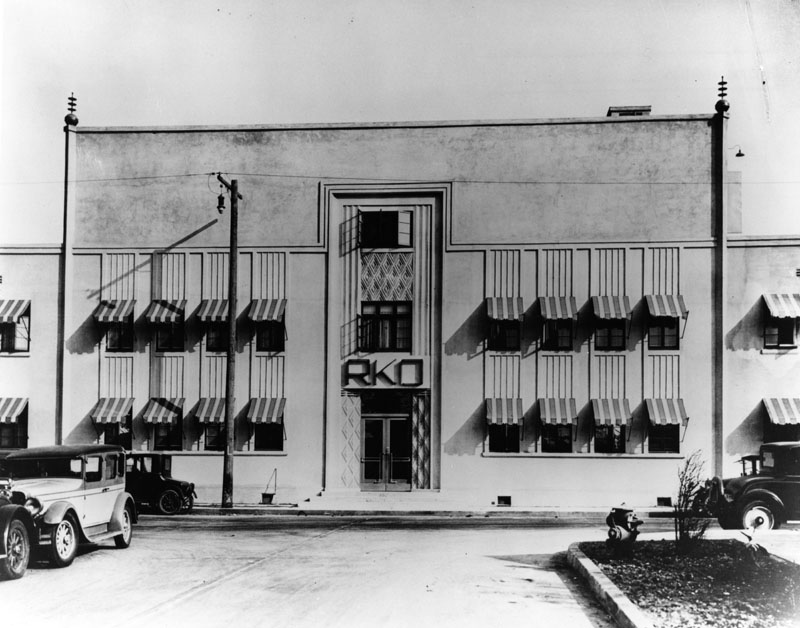 |
|
| (ca. 1928)* - Exterior view of the Gower Street entrance of the RKO Studios, located on Gower Street and Melrose Avenue in Hollywood, 780 N. Gower St. |
Historical Notes RKO (Radio-Keith-Orpheum) was one of the Big Five studios of Hollywood's Golden Age. The business was formed after the Keith-Albee-Orpheum (KAO) theater chains and Joseph P. Kennedy's Film Booking Offices of America (FBO) studio were brought together under the control of the Radio Corporation of America (RCA) in October 1928. RCA chief David Sarnoff engineered the merger to create a market for the company's sound-on-film technology, RCA Photophone. By the mid-1940s, the studio was under the control of investor Floyd Odlum.*^ |
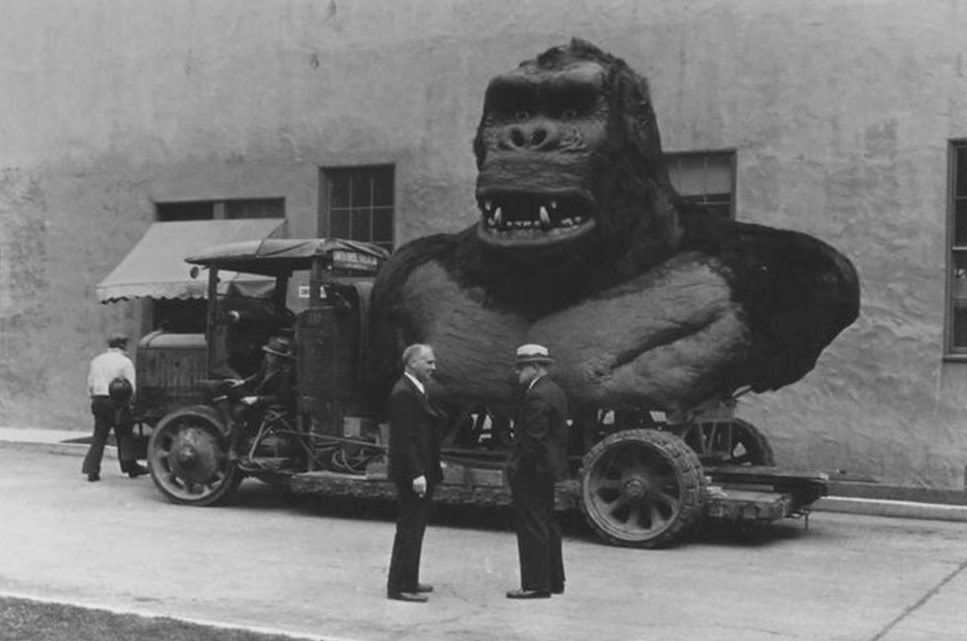 |
|
| (1932)* – View showing the working model built for King Kong at RKO being transported by flatcar to another filming location. |
Historical Notes A huge bust of King Kong's head, neck, and upper chest was made of wood, cloth, rubber, and bearskin. Inside the structure, metal levers, hinges, and an air compressor were operated by three men to control the mouth and facial expressions. Its fangs were 10 inches in length and its eyeballs 12 inches in diameter. The bust was moved from set to set on a flatcar. Its scale, if fully realized, would have made Kong thirty to forty feet tall.*^ The film production took more than a year (Jan 1932 to early Feb 1933) at RKO, with the native village and great wall scenes shot at the Culver Studios on Washington Blvd. The landing on ‘Skull Island’ was filmed at San Pedro, near Los Angeles Harbor, the mountains were painted on glass. The interior of the ‘New York’ theatre, in which Kong is exhibited, is Los Angeles' Shrine Auditorium. The original King Kong movie was deemed "culturally, historically and aesthetically significant" by the Library of Congress and selected for preservation in the National Film Registry. It was also ranked by Rotten Tomatoes as the greatest horror film of all time. |
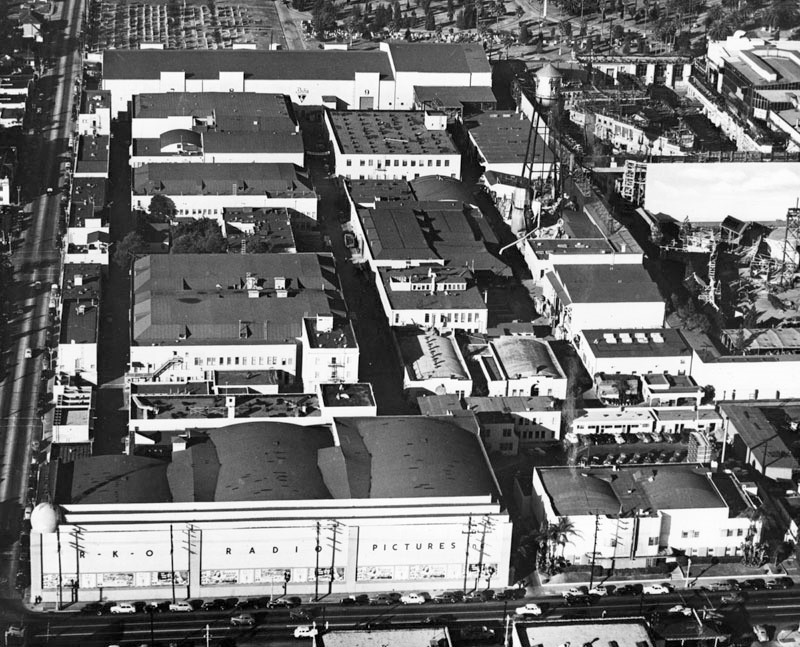 |
|
| (1940s)* - Aerial view looking north showing the RKO Radio Pictures' lot in Hollywood. The intersection of Melrose Avenue and Gower Street is at lower-left. |
Historical Notes Adjacent to the lot on the east was Paramount Studios, and the property line to the north is still Hollywood's oldest cemetery. |
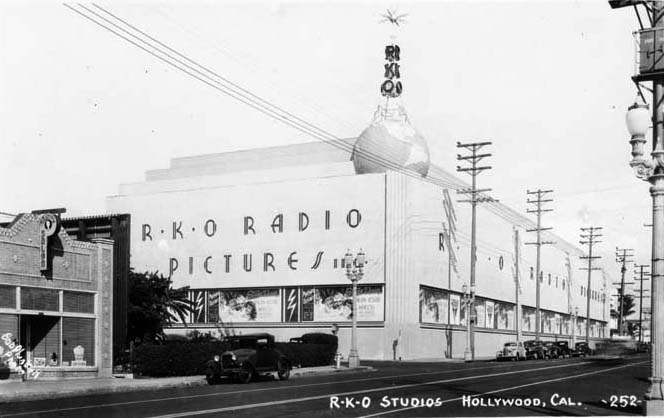 |
|
| (ca. 1940)^^^ - Postcard view of the RKO Studios located on the northeast corner of Melrose Ave and Gower St. |
Historical Notes RKO has long been celebrated for its series of musicals starring Fred Astaire and Ginger Rogers in the mid-to-late 1930s. Actors Katharine Hepburn and, later, Robert Mitchum had their first major successes at the studio. Cary Grant was a mainstay for years. The work of producer Val Lewton's low-budget horror unit and RKO's many ventures into the field now known as film noir have been acclaimed, largely after the fact, by film critics and historians.*^ |
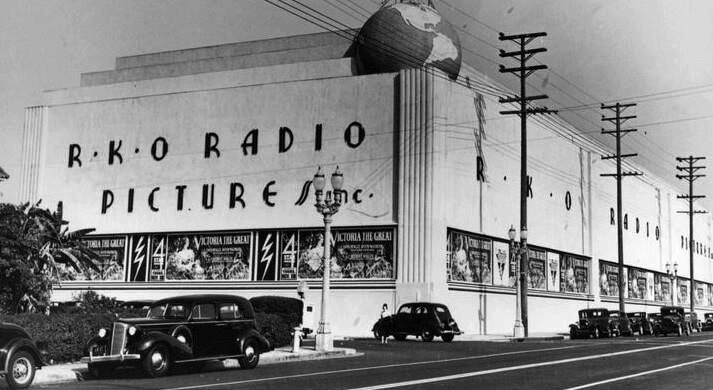 |
|
| (ca. 1940)##^* – Closer view showing the RKO (Radio-Keith-Orpheum)Studios at Melrose and Gower, N/E corner. The film "Victoria the Great" is being advertised. Click HERE for contemporary view. |
Historical Notes The RKO Sutdios produced two of the most famous films in motion picture history: King Kong and Citizen Kane. |
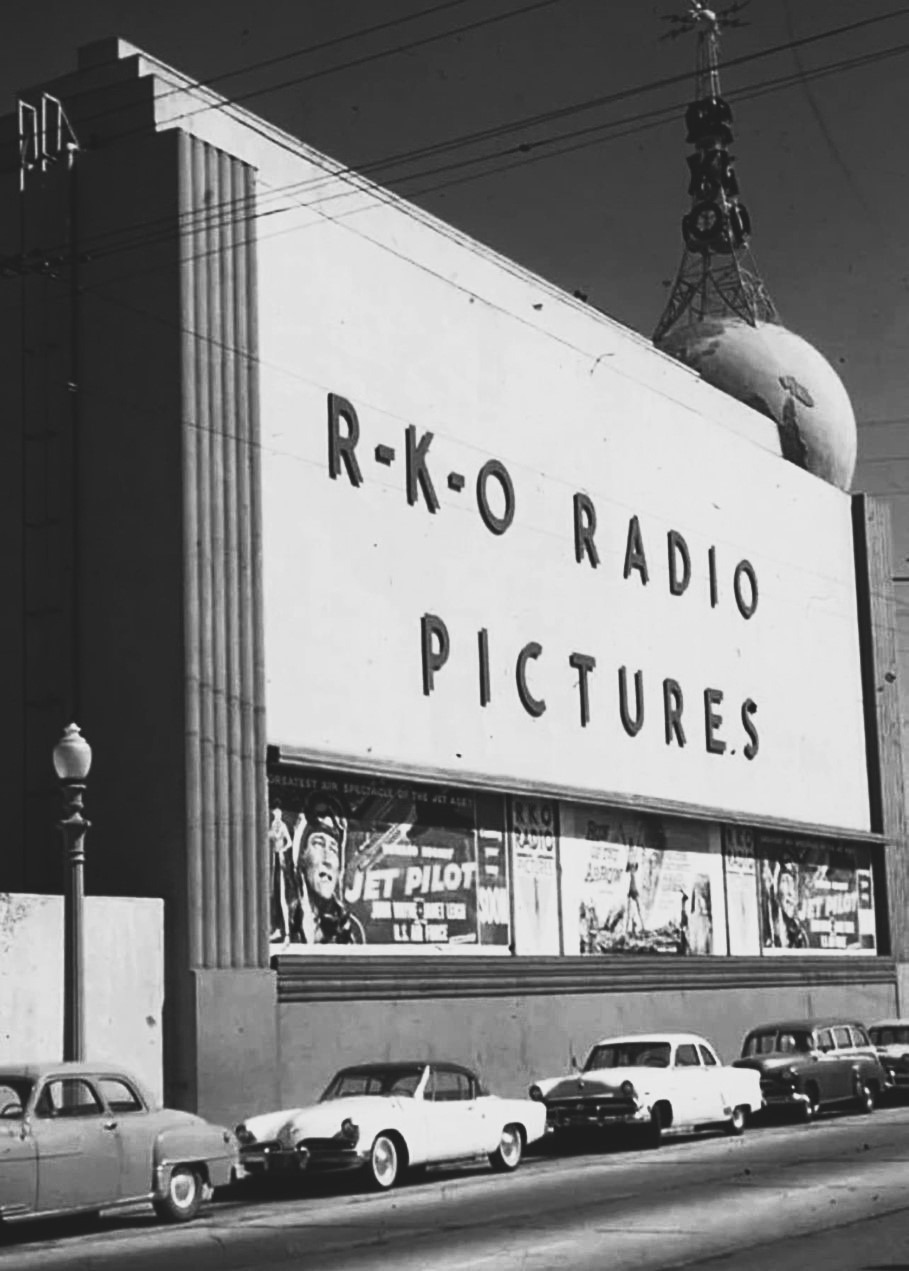 |
|
| (1957)* – Looking SE across Gower toward Melrose showing billboards advertising new movie releases one of which is 'Jet Pilot' with John Wayne. |
Historical Notes Desilu bought the RKO Pictures production facilities just after the above picture was taken (1957). |
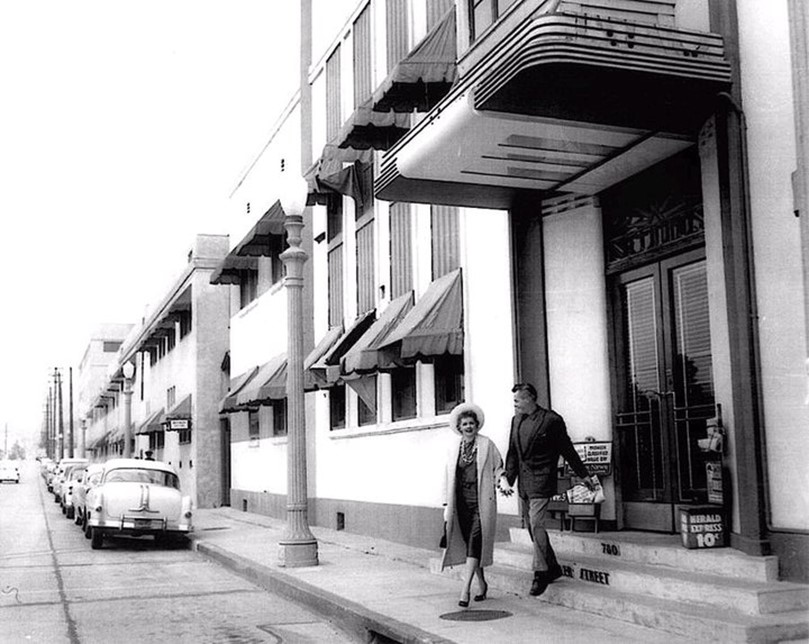 |
|
| (1958)* - Lucy and Desi leaving the Desilu Studios on Gower and Waring, which was the old RKO studios. Click HERE for contemporary view. |
Historical Notes In late 1957, Desilu bought the RKO Pictures production facilities for $6 million from General Tire and Rubber, including RKO's main facilities on Gower Street in Hollywood and the RKO-Pathé lot (now Culver Studios) in Culver City. This purchase included Forty Acres, the backlot where exteriors for Mayberry were filmed. These acquisitions gave the Ball-Arnaz TV empire a total of 33 sound stages — four more than Metro-Goldwyn-Mayer and eleven more than Twentieth Century-Fox had in 1957. Ball and Arnaz divorced in 1960. Ball served as president and chief executive officer of Desilu while at the same time starring in her own weekly series. In November 1962, Arnaz resigned as president when his holdings in the company were bought out by Ball, who succeeded him as president. This made her the first woman to head a major studio and one of the most powerful women in Hollywood at the time. Ball founded Desilu Sales, Inc., for syndication which distributed Jay Ward Productions' Fractured Flickers in 1964. Today, Desilu Sales is part of CBS Media Ventures (formerly CBS Television Distribution). In 1967, Ball agreed to sell her television company to Gulf+Western, which had only recently acquired Paramount Pictures. The company was renamed Paramount Television, and the former RKO main lot on Gower Street was absorbed into the adjacent Paramount Lot. The old RKO globe logo is still in place. The company is now called CBS Studios (formerly CBS Television Studios). Perfect Film purchased Desilu Studios' other lot in Culver City in 1968.* |
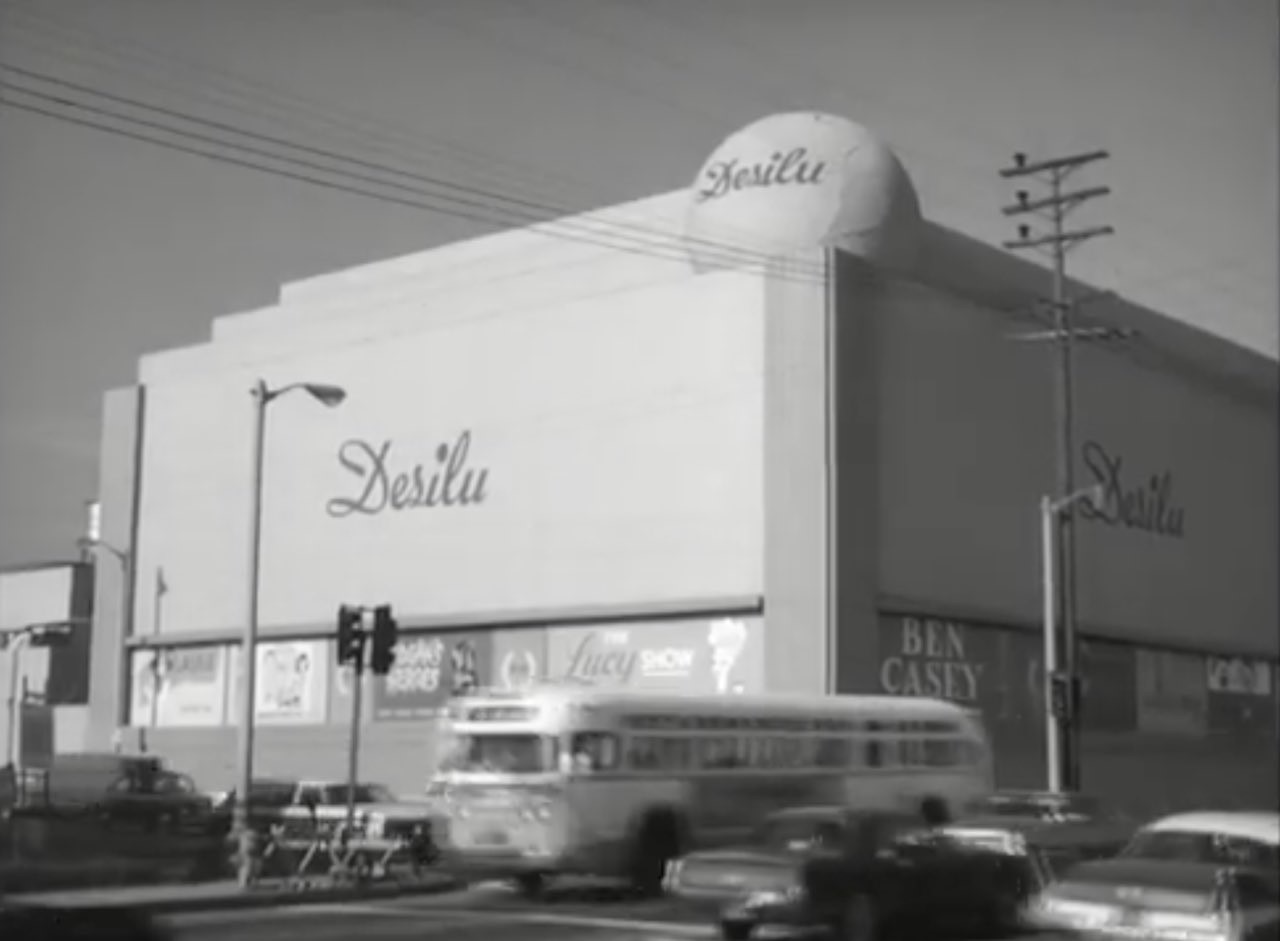 |
|
| (1960s)*- Looking at the NE corner of Melrose and Gower, now the Desilu Studios. Photo courtesy of Jim Vibber |
* * * * * |
Melrose Hotel (aka Melrose Arms, Monte Cristo Island Apts, and Hollywood Historic Hotel)
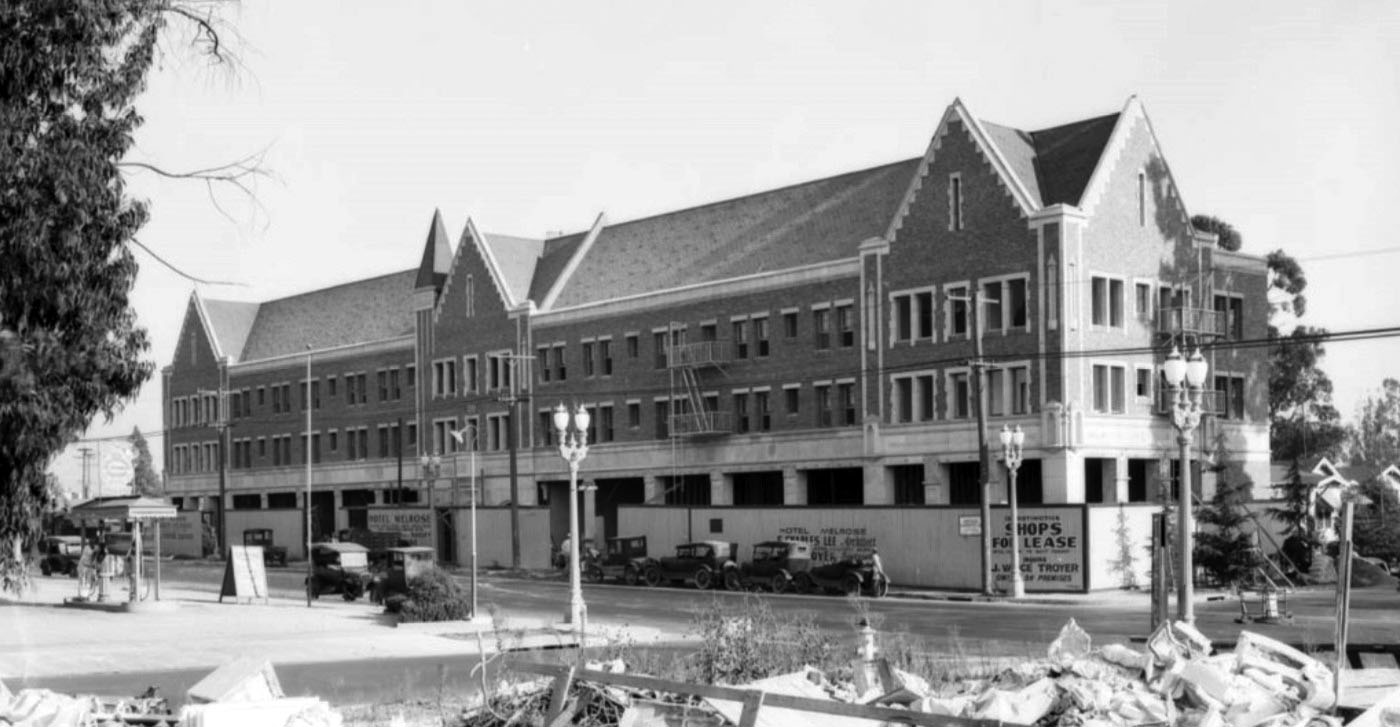 |
|
| (1927)^^ – View showing the Melrose Hotel under construction, located at Wilton Place and Melrose Avenue. |
Historical Notes The Hollywood Melrose Hotel, also known previously as the Melrose Arms and later as the Monte Cristo Island Apartments, is a historic building on Melrose Boulevard in Hollywood. Designed by S. Charles Lee, the structure was built in 1927. It has been used both as a hotel and apartments over the years of its existence, with commercial establishments on the first floor.* |
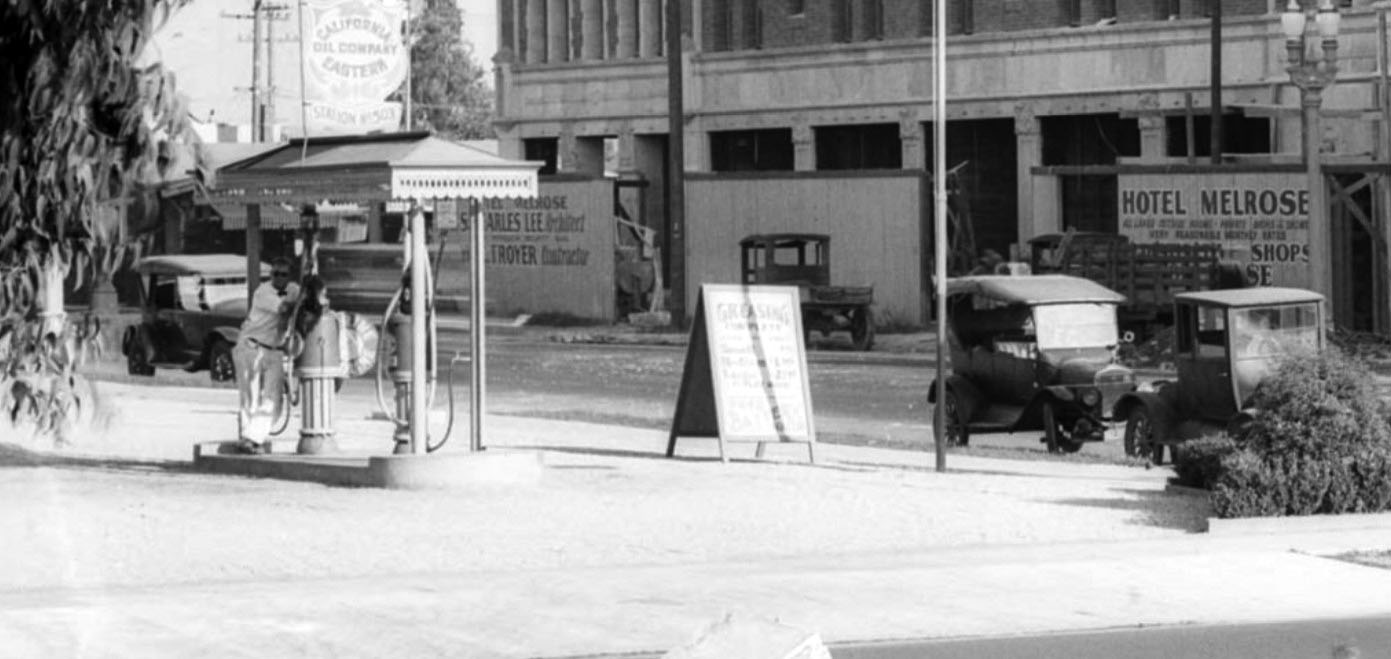 |
|
| (1927)^^ – View showing a California-Eastern Oil Company Gas Station on the NE corner of Melrose Ave and Wilton Place with the Hotel Melrose seen across the street in the background. Note the cool gas station attendant wearing the sun glasses. |
Historical Notes Click HERE to see more Early Los Angeles Gas Stations. |
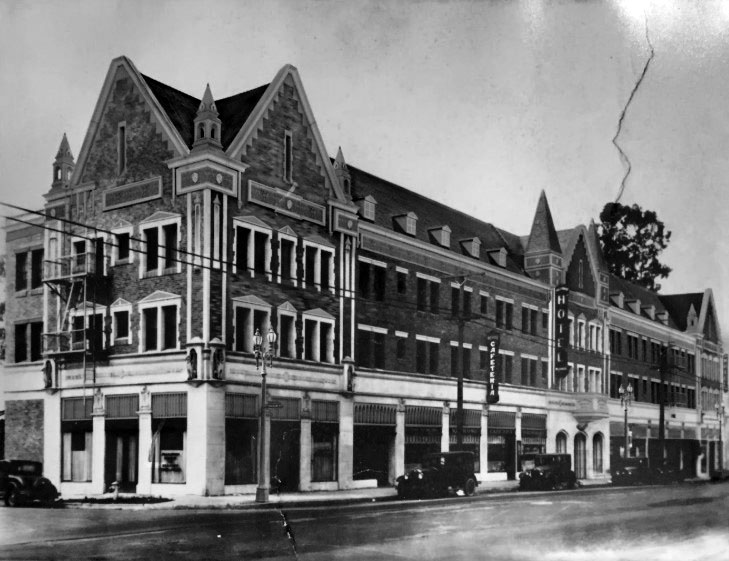 |
|
| (ca. 1927)^.^ – View looking at the SW corner of Melrose Avenue and Gramercy Place showing the Hollywood Melrose Hotel. Click HERE to see contemporary view. |
Historical Notes In 1927 the Los Angeles Times headlines announced "One more beauty from architect S. Charles Lee". The Hollywood Melrose Hotel was the premier choice for celebrities, diplomats and dignitaries for many years. The view from many of the rooms is the Hollywood Sign itself and the famous Paramount Pictures and Raleigh Studios is one block away.^ |
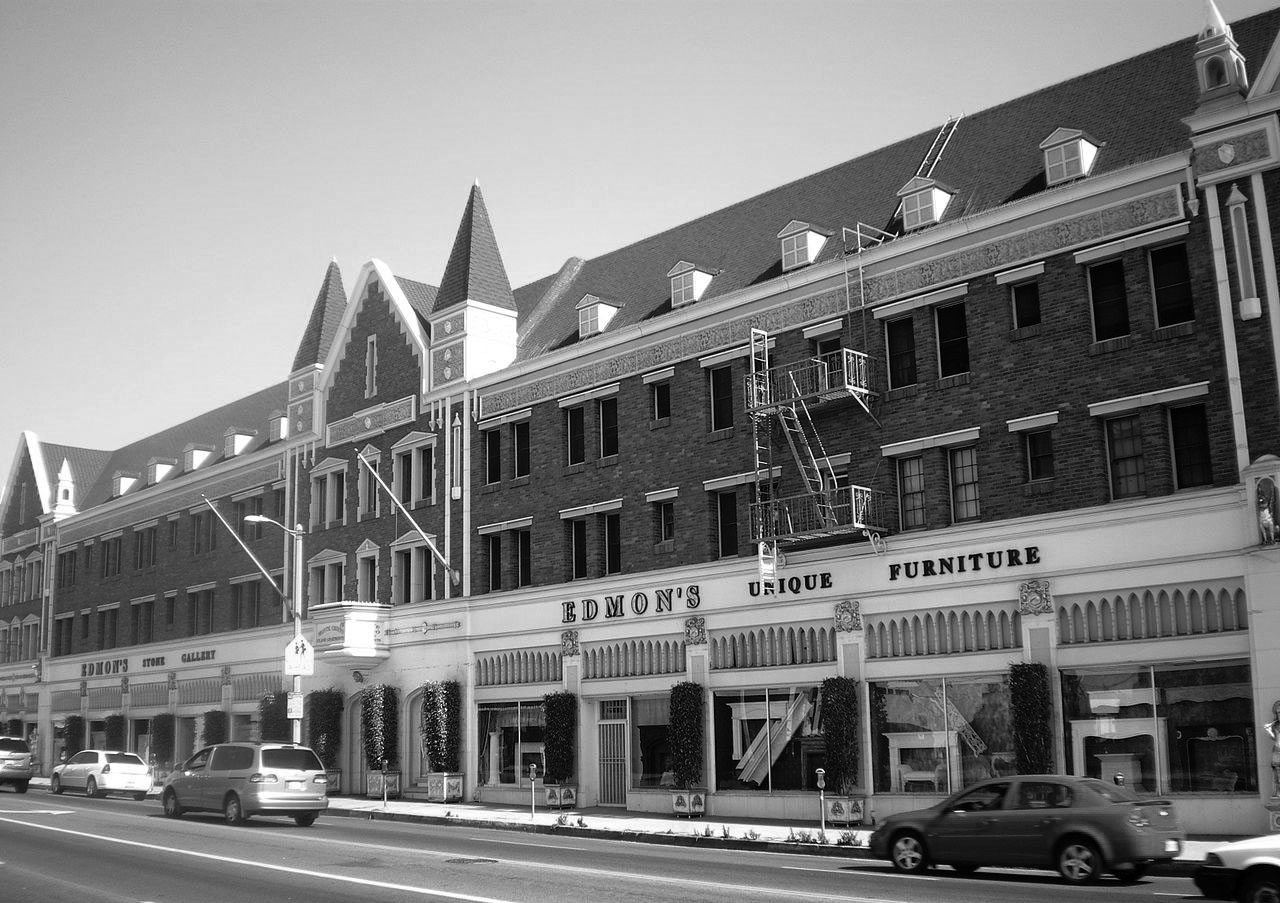 |
|
| (2008)*^ - View looking southeast showing the mixed-use Hollywood Melrose Hotel (Hollywood Historic Hotel) at 5150-5170 Melrose Avenue. |
Historical Notes In 1992, the building was listed on the National Register of Historic Places based on its architecture. In April 2010, the hotel was reopened as the newly restored Hollywood Historic Hotel. Edmon Simonian and his family own the property, and operate a furniture gallery located on the hotel's street level. All of the hotel's facades, common spaces, staircases and 62 rooms were restored to their former 1920's glory following an 18-month interior and exterior renovation.* |
Then and Now
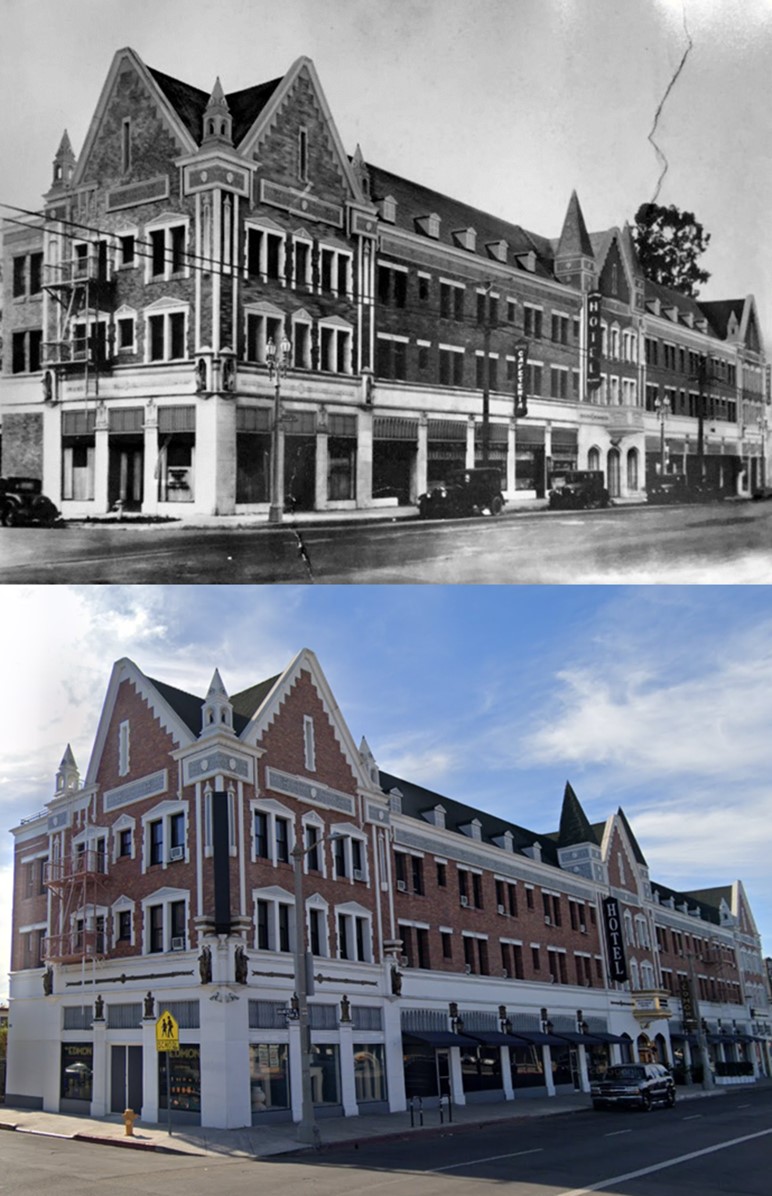 |
|
| (1927 vs. 2021)* - Hollywood Melrose Hotel (currently Hollywood Historic Hotel). |
Hollywood Storage Co. Building
 |
|
| (1928)* - Front view of the Hollywood Storage Co. Building, located at Highland Avenue and Santa Monica Boulevard. |
Historical Notes The 14-story Hollywood Storage Co. building at 1025 N. Highland Ave. was the tallest structure in Hollywood when erected in 1925. It was purchased by Bekins in 1939. The building was also home of the Evening Herald radio station, KMTR.* |
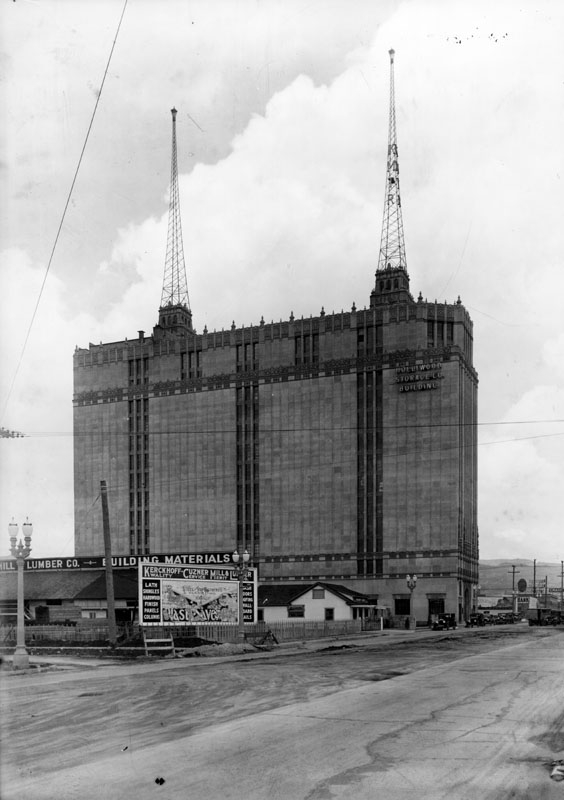 |
|
| (1928)* - Side view of the Hollywood Storage Co. Building, located at 1025 N. Highland Ave. |
Historical Notes Morgan, Walls & Clements designed this Spanish revival style building, completed in 1925.* |
 |
|
| (ca. 1929)^^ - Panoramic view of Hollywood looking north from the Hollywood Storage Co. Building, located at Santa Monica Boulevard and Highland Avenue. Several commercial lots and buildings fill the foreground half of the image, while residential blocks full of houses fill the rest, terminating in several high rise buildings in background right before the mountains. Highland Avenue is visible on the right. A lone "H" stands legible on the mountains to the right. |
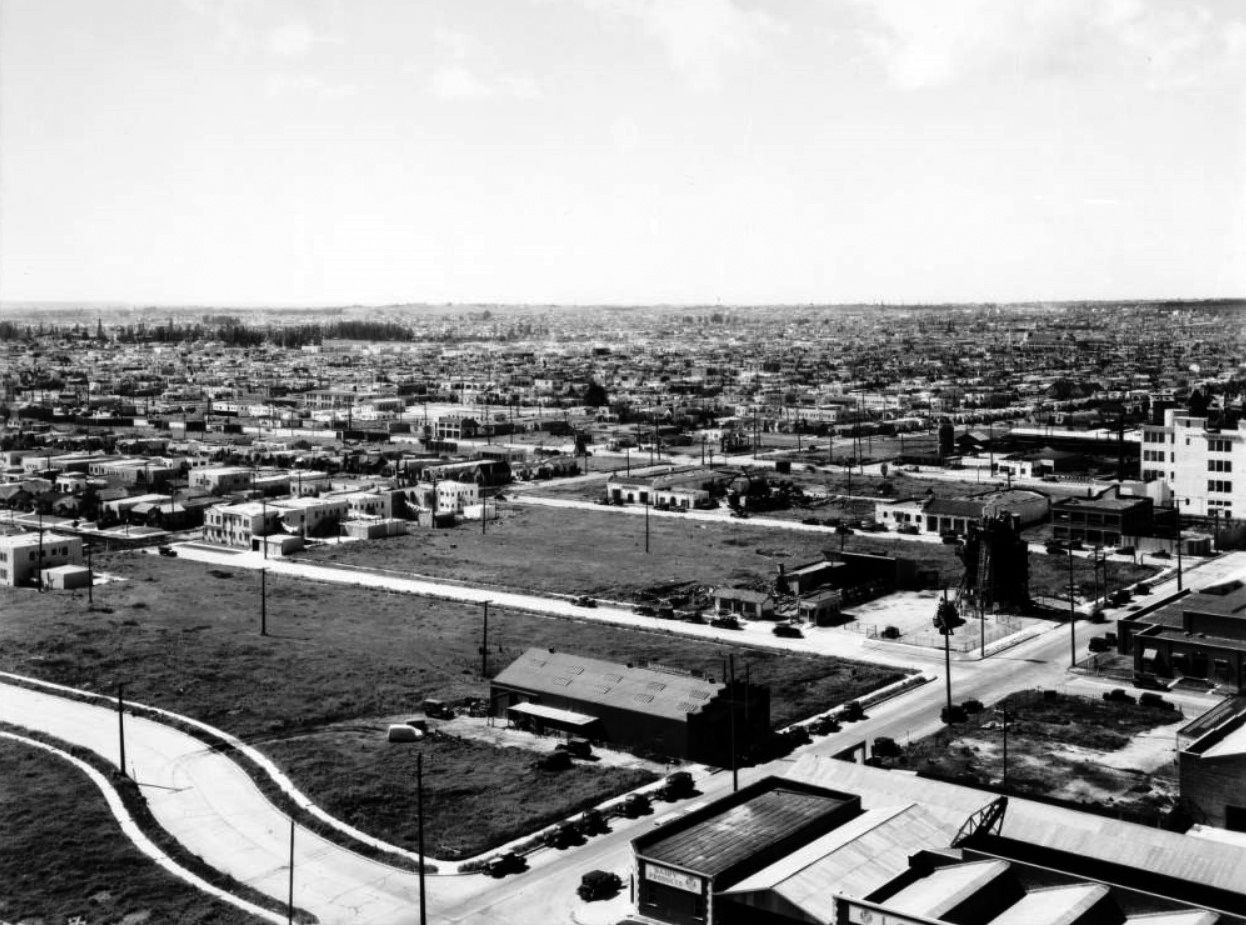 |
|
| (1929)^^ - Panoramic view of Hollywood looking southwest from the top of the Hollywood Storage Co. Building. The intersection of Romaine Street and Mansfield Avenue is seen at lower left. Click HERE for contemporary view. |
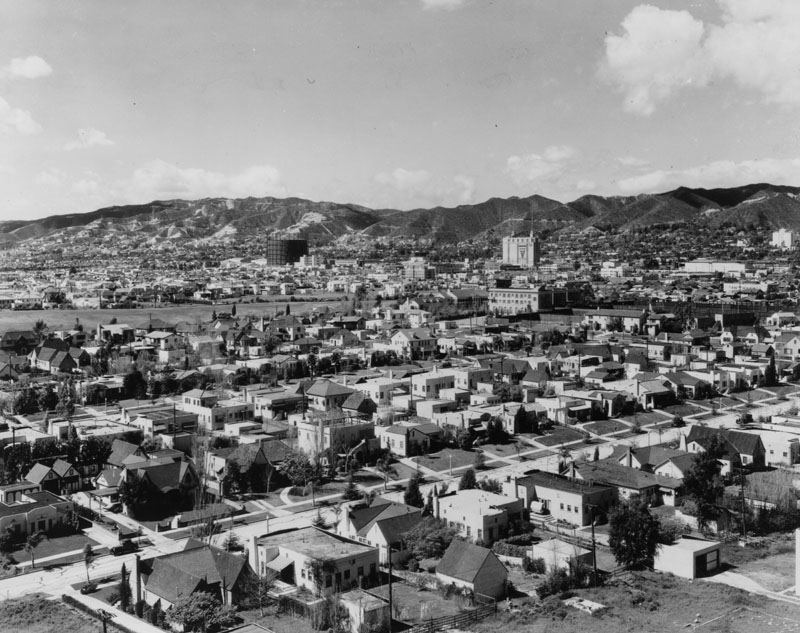 |
|
| (1930)* - Panoramic view of Hollywood looking northwest on a very clear day. The Hollywood Storage Co. Building, located at Santa Monica Boulevard and Highland Avenue, is the tallest building in the area. |
Lockheed Aircraft Company (Hollywood)
 |
(1927)#** – On July 4, 1927 the first Lockheed Aircraft Company Vega 1, NX913, Golden Eagle, made its maiden flight with test pilot Edward Antoine (Eddie) Bellande at Rogers Airport (The airport was at the present location of Wilshire Boulevard and Fairfax Avenue). |
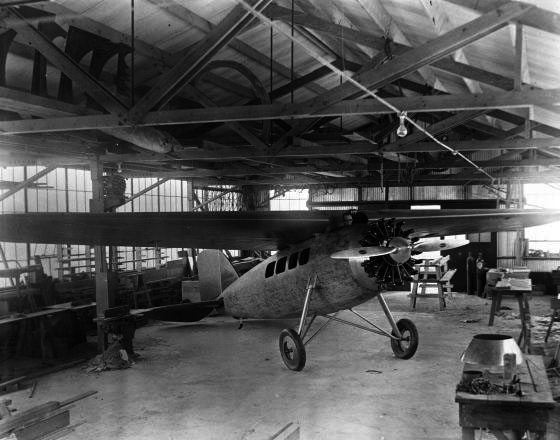 |
|
| (1927)#** - The first Vega 1, NX913, Golden Eagle, nears completion at the Lockheed Aircraft Company, Hollywood. |
Historical Notes Twenty-eight Vega 1 airplanes were built by Lockheed Aircraft Company at the factory on Sycamore Street in Hollywood before production of the improved Lockheed Vega 5 began in 1928 and the company moved to its new location at Burbank, California. #** |
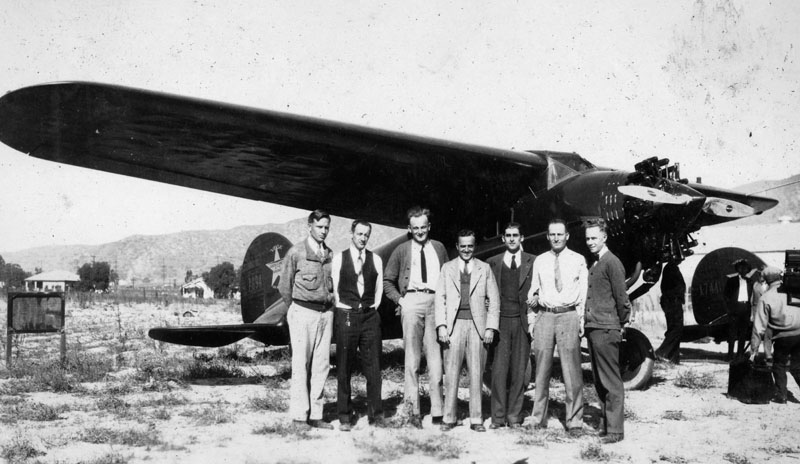 |
|
| (1928)* - Seven men, identified as the "old gang", stand next to a plane at the Lockheed plant in Hollywood. From left to right: Frank Crane, Jimmy Gerschler, Dan Egger, Jerry Vultee, Dick Von Hake and Vard Wallace. |
Historical Notes Originally called the Alco Hydro-Aeroplane Company, Lockheed was founded in 1912 by brothers Malcolm and Allan Loughead. Its next incarnation was Loughead Aircraft Manufacturing Company and was located in Santa Barbara. In 1926, following the failure of Loughead, Allan Loughead formed the Lockheed Aircraft Company in Hollywood. The Great Depression greatly changed the aircraft industry and in 1934, Robert E. Gross was named chairman of the new company, the Lockheed Corporation, which had relocated to Union Airport (Bob Hope Airport) in Burbank, California.* Click HERE to see more in Aviation in Early L.A. |
* * * * * |
Please Support Our CauseWater and Power Associates, Inc. is a non-profit, public service organization dedicated to preserving historical records and photos. Your generosity allows us to continue to disseminate knowledge of the rich and diverse multicultural history of the greater Los Angeles area; to serve as a resource of historical information; and to assist in the preservation of the city's historic records.
|
More Historical Early Views
Newest Additions
Early LA Buildings and City Views
History of Water and Electricity in Los Angeles
* * * * * |
References and Credits
* LA Public Library Image Archive
^* California Historic Landmark Listing (Los Angeles)
^ California Historical Society Digital Archive
** Retronaut - Hollywoodland Sign
^^^California State Library Image Archive
***The Story of Hollywood by Gregory Paul Williams
**^Table Magazine: LA Observatory
^**Huntington Digital Library Archive
^*#West Hollywood Patch: Bancroft Middle School
^^*Cinema Treasures:Ricardo Montabaln Theater
^^#LA Times: 'Swing in, pig out, drive off'; Hollywood American Legion Post 43; Christie Hotel; Making Waves - Japanese American Photography, 1920-1940
#**This Day in Aviation: Lockheed Vega 1
+**HollywoodHeritage.com: The Equitable Building of Hollywood
+##Los Angeles Conservancy: El Capitan Theatre
#*^Hollywood Chamber of Commerce History
#^*Pinterest.com: Old Hollywood
##^UC Santa Cruz Digital Archive
##+Facebook.com: Los Angeles Railroad Heritage Foundation
*^*MTA Transportation and Research Library Archives
*.* Greater Streets: Exploring the Walk of Fame — Heart of Hollywood
++++Stuff.co.nz: Roosevelt Hotel
**##MartinTurnbill.com: Roos Bros. Clothing Store
^*^*HollywoodHeritage.com: The Muller Family Foundation
^*^#Facebook.com - Bizarre Los Angeles
*^^^Pinterest.com: Hollywood History
*#*^PlantTrout.worldpress: Musso and Frank Grill
^#^^Facebook.com - Vintage LA: Musso & Franks Grill; Hollywood Ranch Market
#^**The Go Go's: N/W Corner of Hollywood and Vine
#**#Facebook.com: Garden of Allah Novels, Martin Turnbull
#*^#Historic Hollywood Theatres: Warner Bros. Hollywood Theatre
#*#*Musso and Frank History: mussoandfrank.com
###^Timeout.com: Ricardo Montalban Theatre
#*^*Hidden Los Angeles: Musso and Frank's Grill
*# Skyscraperage.com. - Griffith Observatory; Muller Bros. Service Station; El Capitan Theater; Hollywood and Vine, 1929; Outpost Sign
*^ Wikipedia: Hollywood; Hollywood Athletic Club; Hollywood Bowl; Grauman's Chinese Theatre; Grauman's Egyptian Theatre; Pantages Theatre (Hollywood); John Hanson Ford Theatre; 20th Century Fox; Samuel Goldwyn.Studio; Barnsdall Art Park; Greek Theatre; Griffith Observatory; Cinerama Dome; Ralphs; Hollywood Palladium; Hollywood and Vine; Hollywood Masonic Temple; Hollywood Pacific Theatre; Max Factor; West Hollywood; Brown Derby; Hollywood Christmas Parade; Mt. Lee; Château Élysée; Hell's Angels (film); Morocco (1930 film); KFWB; Hollywood Playhouse (Avalon Hollywood); RKO Pictures; Musso and Frank Grill; Gene Harlow; Hollyhock House; Hollywood Roosevelt Hotel; Lux Radio Theatre; American Legion; El Capitan Theatre
< Back
Menu
- Home
- Mission
- Museum
- Major Efforts
- Recent Newsletters
- Historical Op Ed Pieces
- Board Officers and Directors
- Mulholland/McCarthy Service Awards
- Positions on Owens Valley and the City of Los Angeles Issues
- Legislative Positions on
Water Issues
- Legislative Positions on
Energy Issues
- Membership
- Contact Us
- Search Index